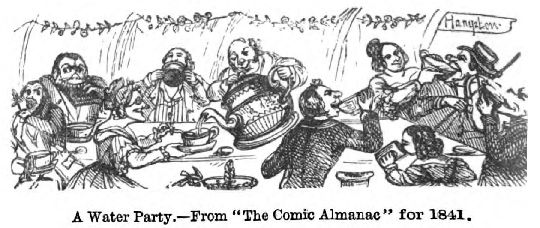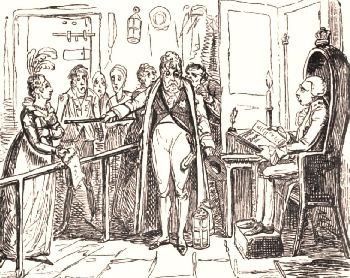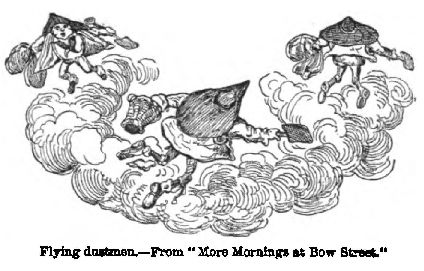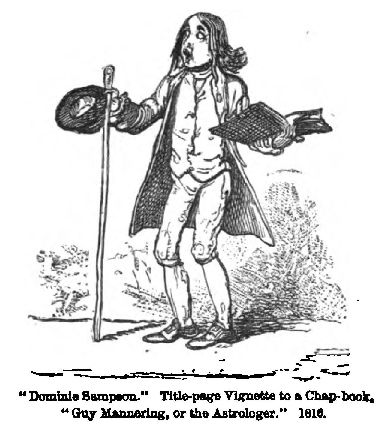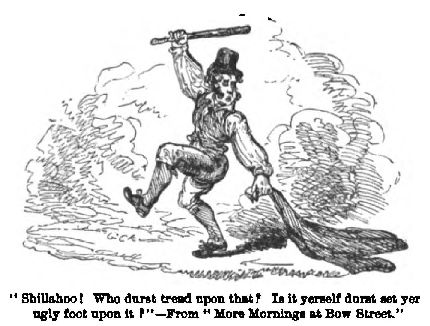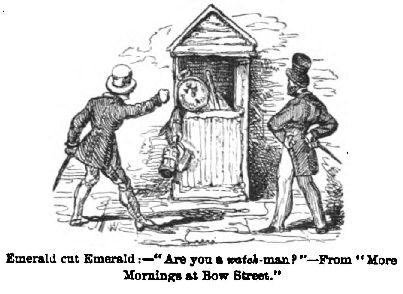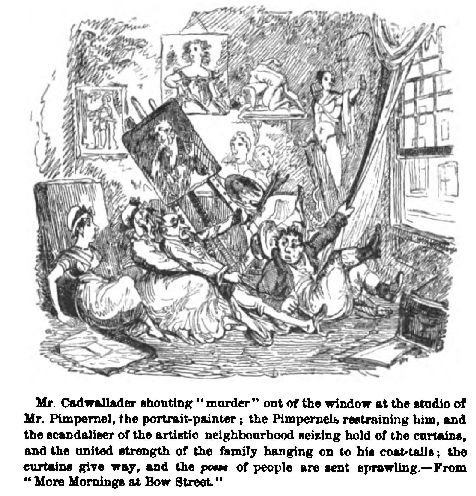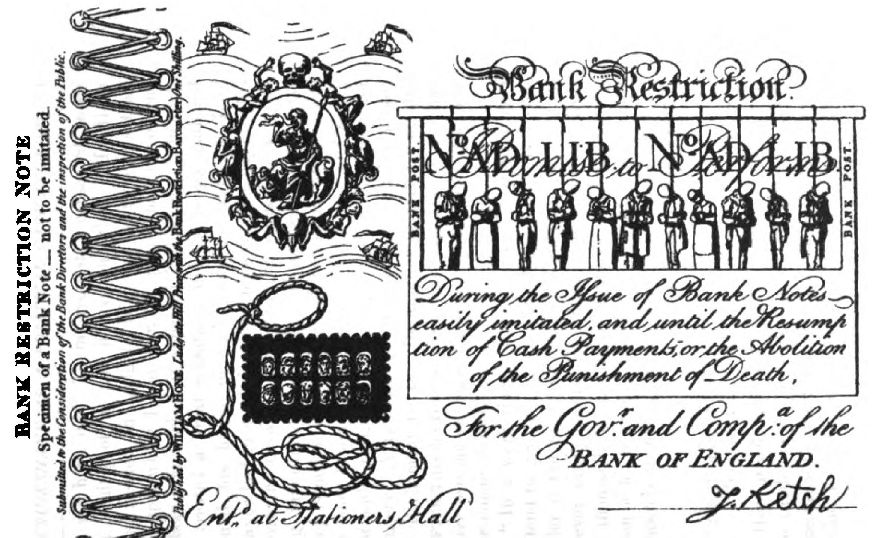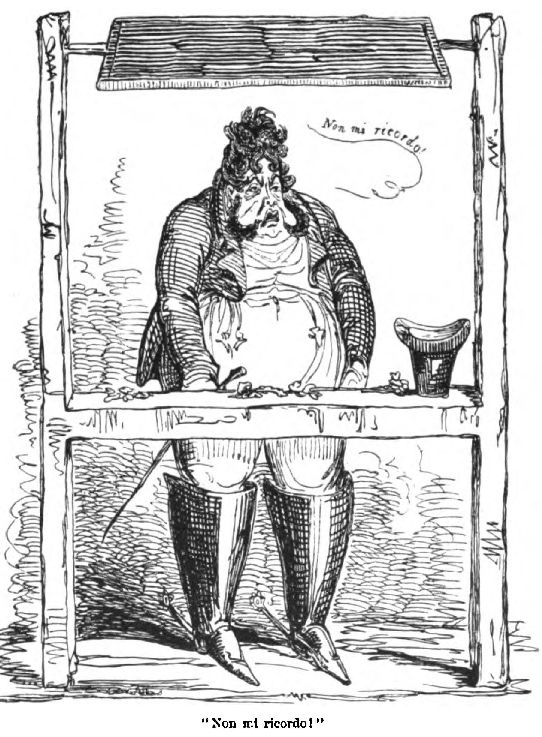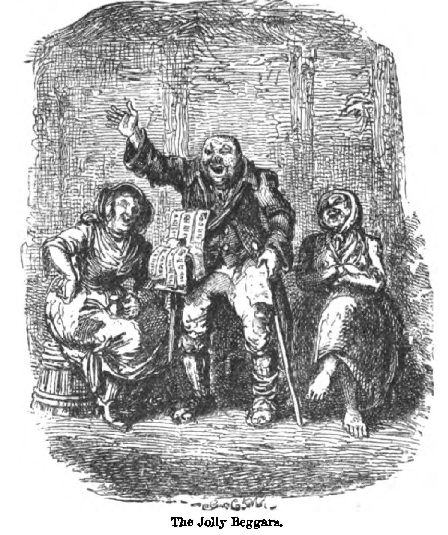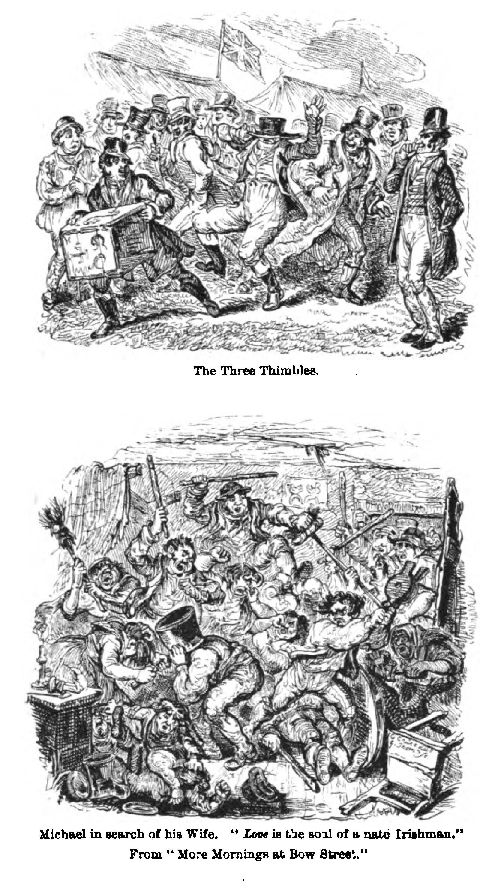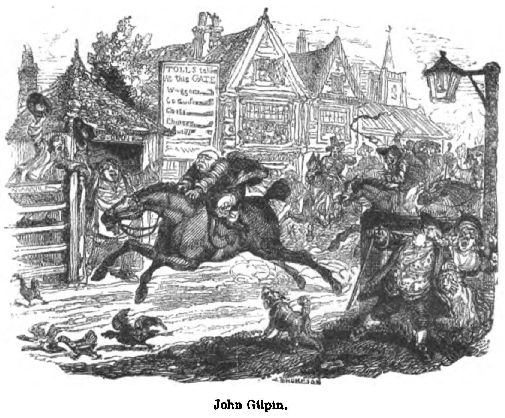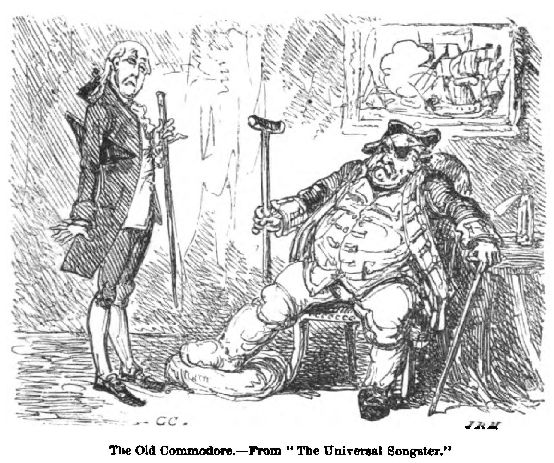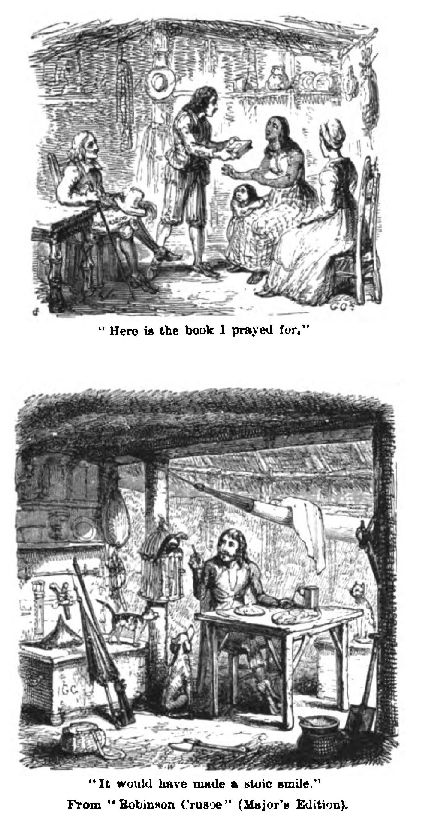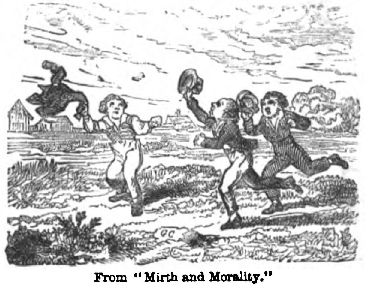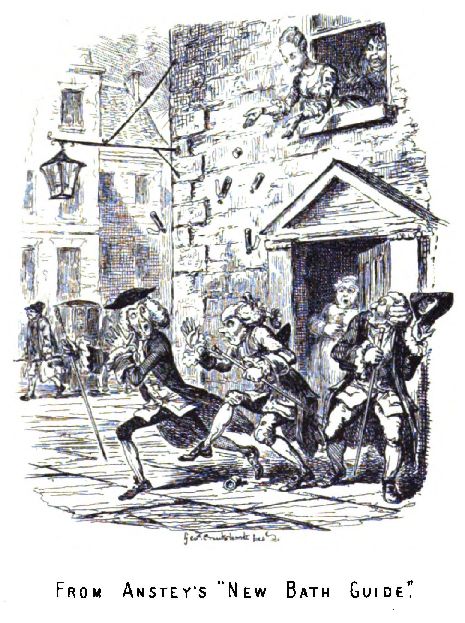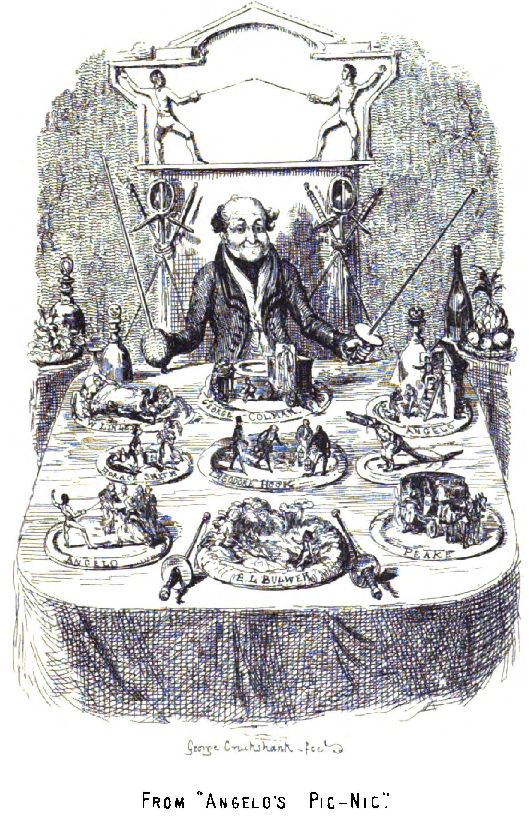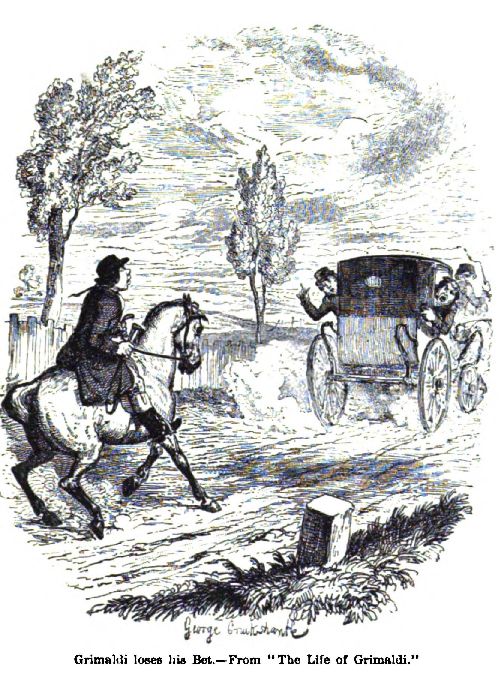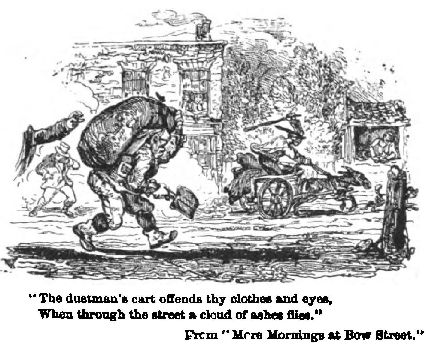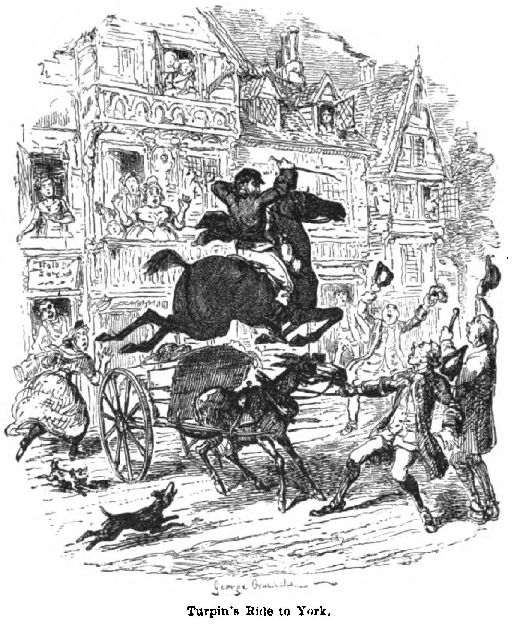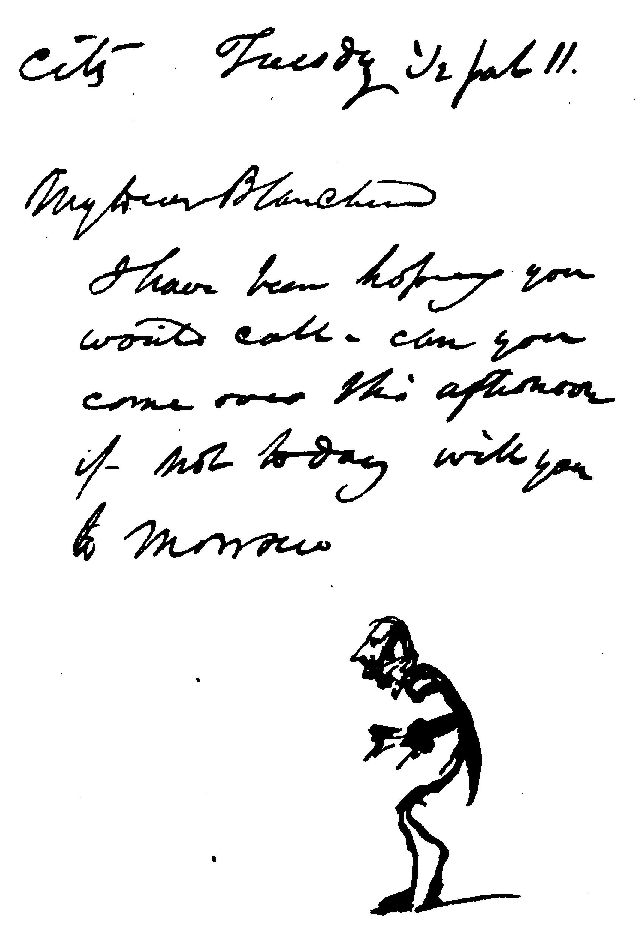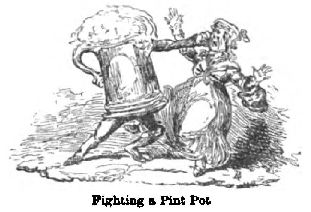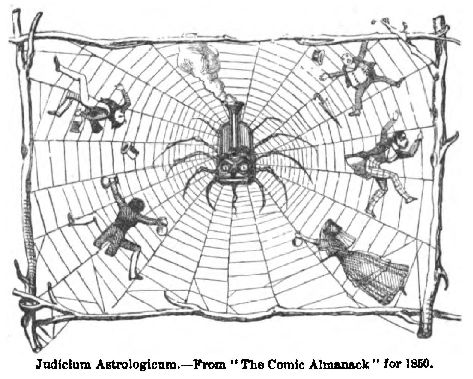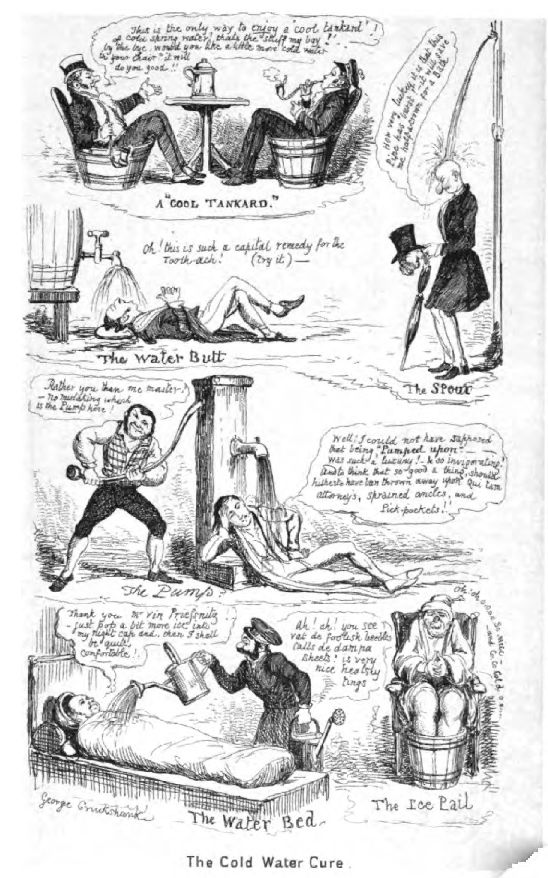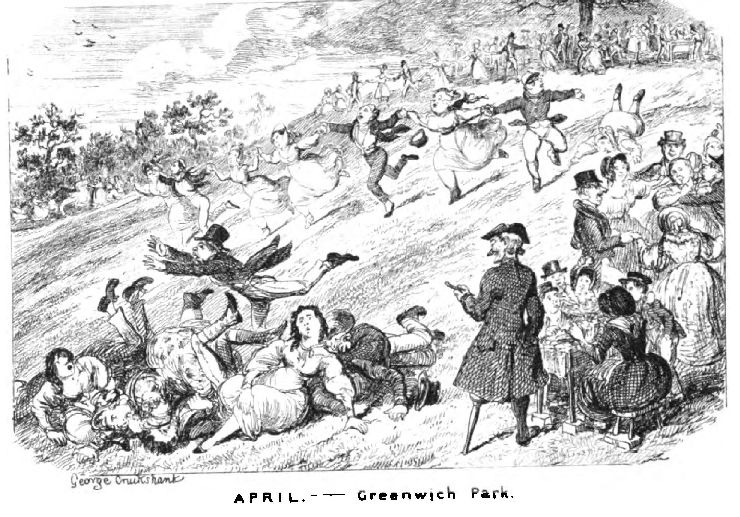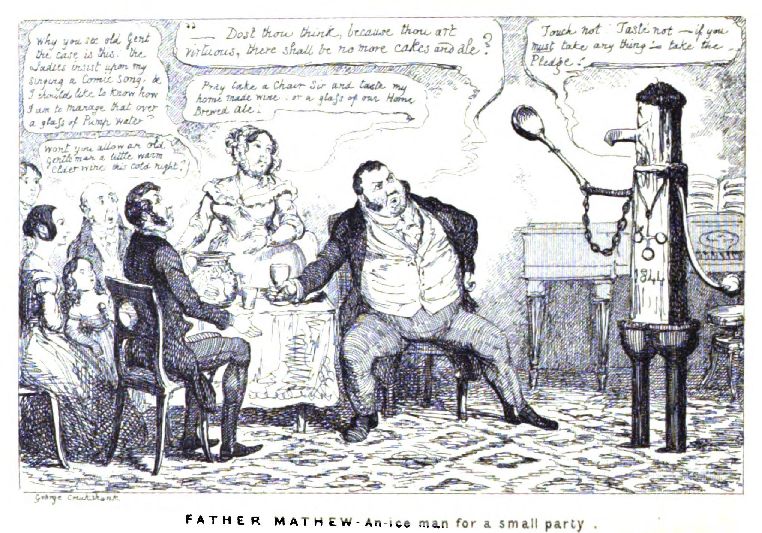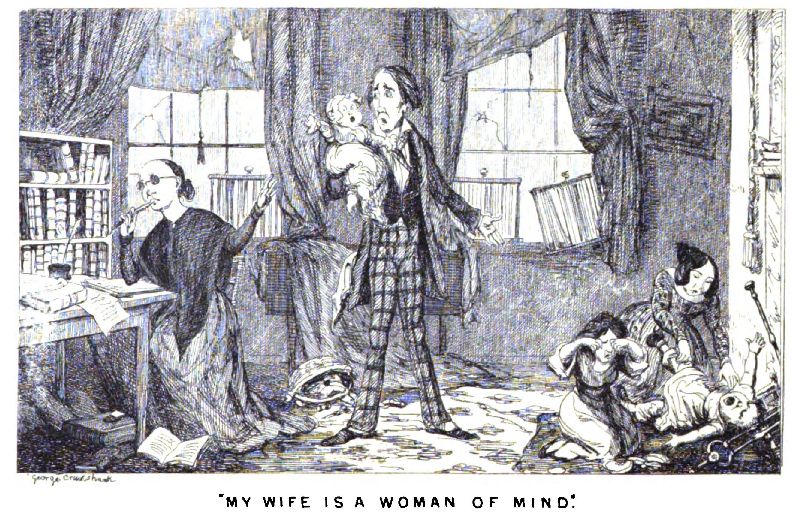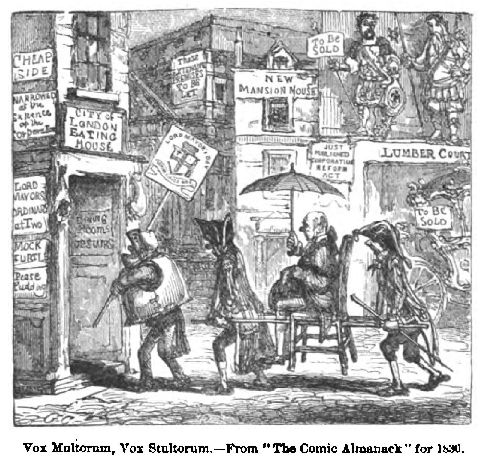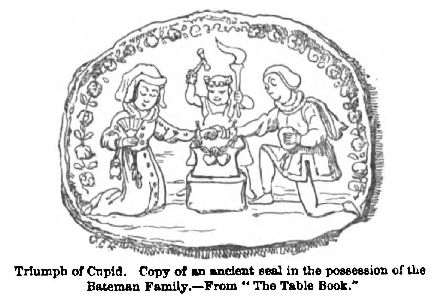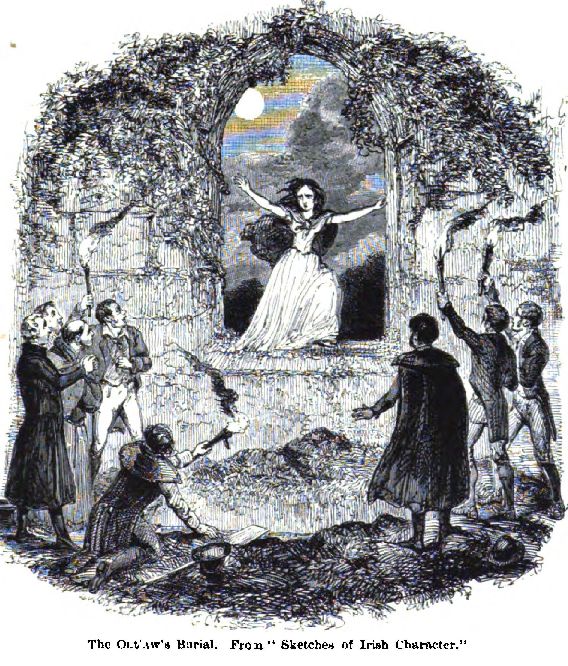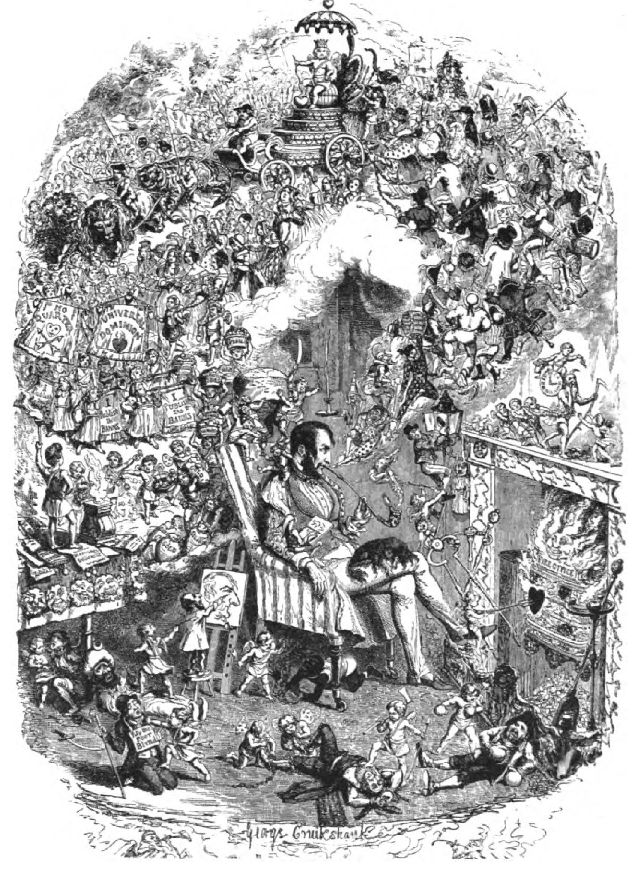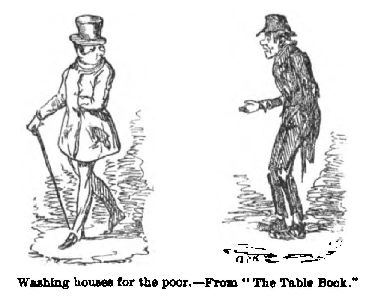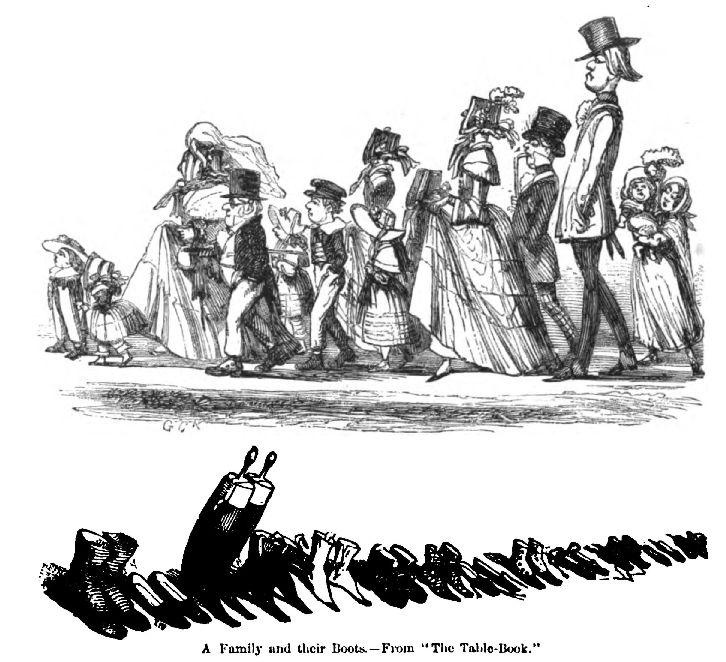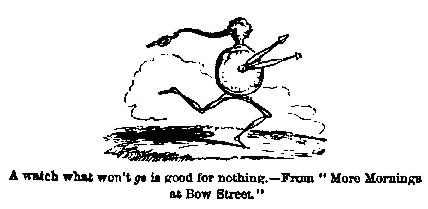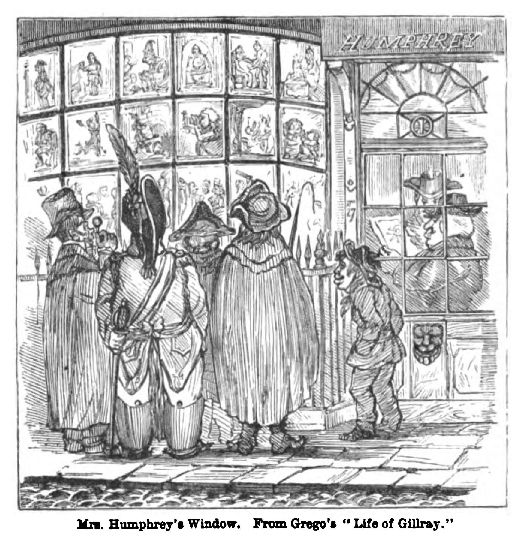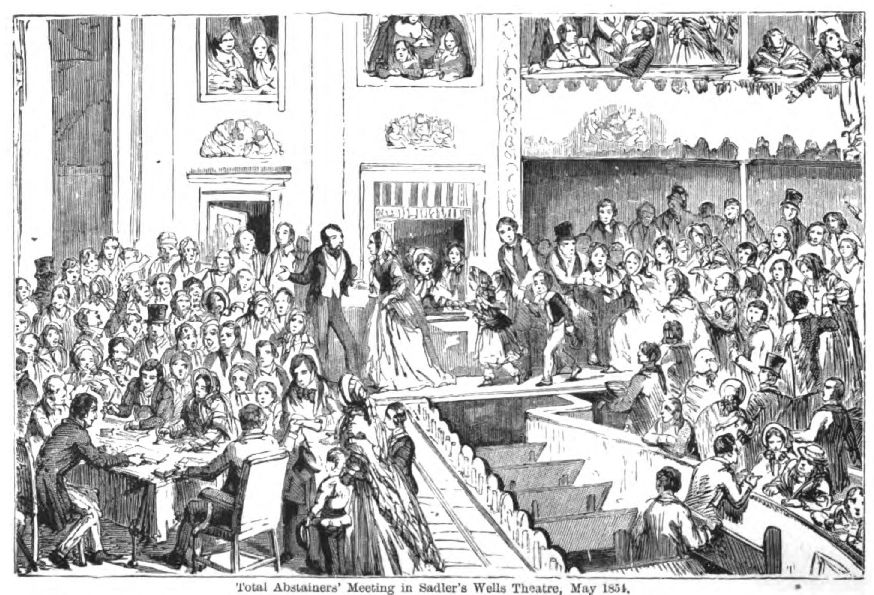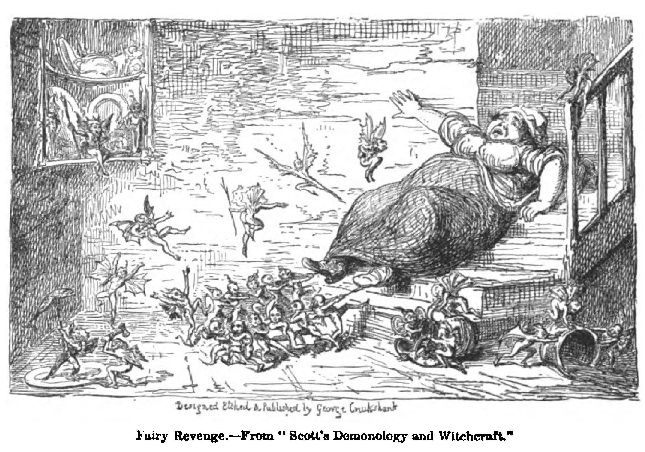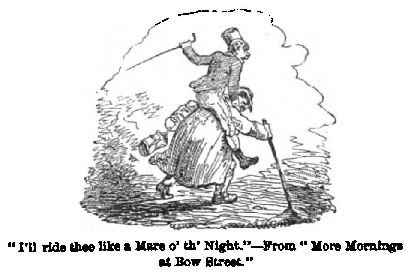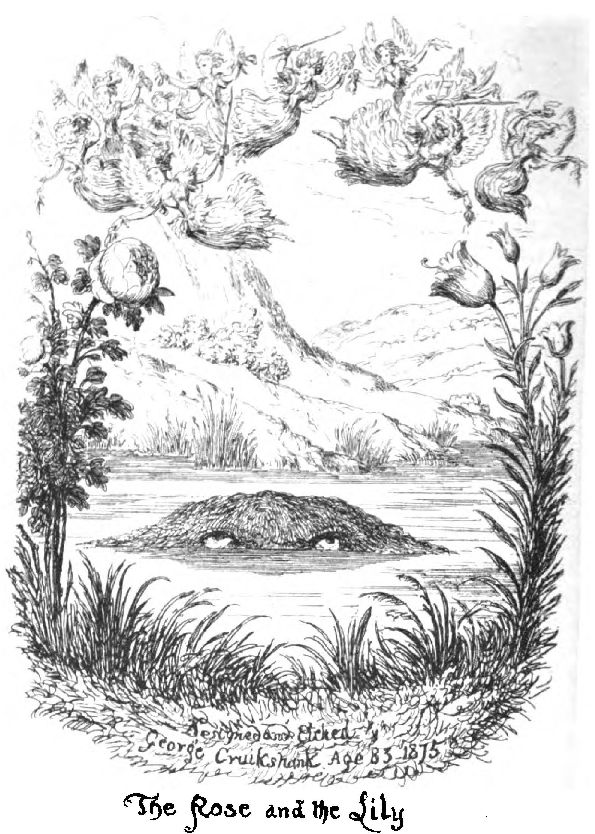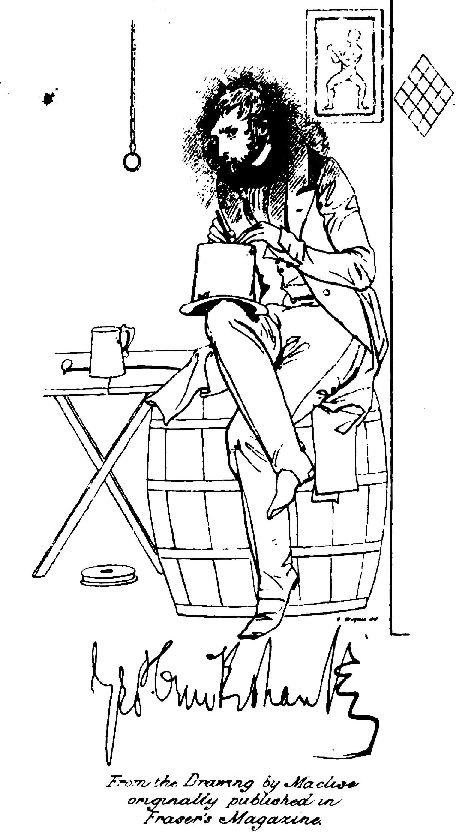

CONTENTS
THE LIFE OF GEORGE CRUIKSHANK.
CHAPTER XI. THE COMIC ALMANAC.
CHAPTER XII. LORD BATEMAN AND THE TABLE BOOK.
CHAPTER I. AT GILLRAY’s GRAVE.
CHAPTER III. GEORGE CRUIKSHANK AS A TEETOTALER.
CHAPTER IV. THE TRIUMPH OF BACCHUS.
CHAPTER V. “FRAUDS ON THE FAIRIES” AND “WHOLE HOGS.”
CHAPTER VI. A SLICE OF BREAD AND BUTTER.
CHAPTER VII. CRUIKSHANK’S LAST TWENTY YEARS.
In 1835 the late Mr. Tilt, publisher, of Fleet Street, started the Comic Almanac, and engaged George Cruikshank to illustrate it. It was a happy idea, exactly suited to the more popular side of the mood and genius of the artist; and Cruikshank entered upon his task with zest For nineteen years this annual comic and satirical commentary on passing and probable events, not only furnished him with a regular income, giving him work on which he might reckon with certainty in estimating his very fluctuating resources; but it afforded him the opportunity, in which he always delighted, of recording in his own quaint, original manner, his opinions on the questions of the day.
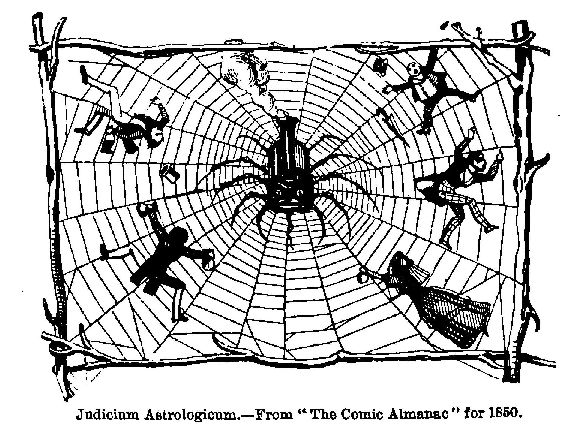
In the nineteen volumes to which the Almanac ran, there are nearly two hundred and fifty etchings by him; and among these there are some of his happiest bits of observation, of his shrewdest exposures of folly and vice and cant, and of his original fancy. After looking over these nineteen volumes, and noticing that the wit and earnestness of purpose are as fresh and strong in that of 1853 as in the first volume, the reader cannot refuse to endorse what Thackeray said of Cruikshank’s humour—viz., that it is so good and benevolent, any man must love it. While in his illustrations of books the many-sided artist continued to express his serious or tragic power, which Mr. Ruskin has asserted to be as great as his grotesque power, though warped by “habits of caricature”; in these pleasant annual volumes, in the letterpress of which he had the assistance of his friends, Thackeray, Gilbert à Beckett, Albert Smith, Robert Brough, Horace and Henry Mayhew, he maintained his original popularity with the laughter-loving sections of the British public.
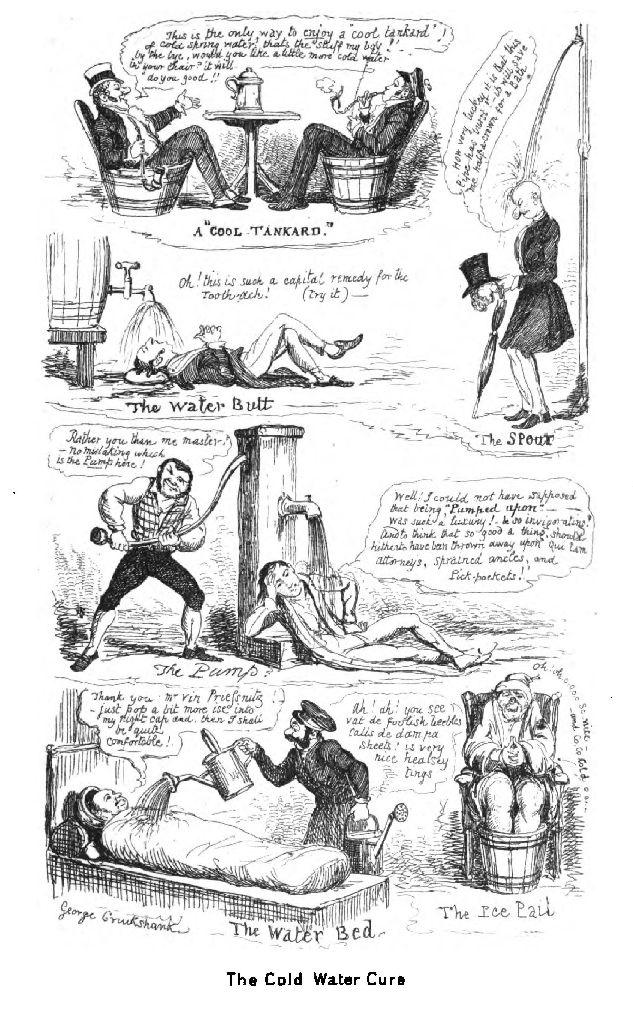
In 1835, when the first almanac appeared, the water cure was amusing the public. Cruikshank’s first plate shows one enthusiast under the water-butt, another under a burst water-pipe, and a third in an elegant attitude, being pumped upon by his servant, and remarking, “Well, I could not have supposed that being ‘pumped upon’ was such a luxury! and so invigorating! And to think that so good a thing should hitherto have been thrown away upon qui tam attorneys, sprained ankles, and pickpockets!” Then Mr. Rigdum Funnidos (originated by the late Mr. Vizetelly, I am informed by his son Henry), enters upon the scene, and continues year after year to be the nom de plume of a succession of wits and humourists; and Cruikshank unfolds his series of plates of the months, each season being indicated by some humorous incident or some happy notes of observation of our London streets. The ice-carts and slides of January; the muddy streets and bustling postmen of St. Valentine’s day,—how unlike (with their great leather bags) the postmen of our day! the winds of March outside Mr. Tilt’s shop, blowing even a dog’s tail over his back; showery April, with a wonderful group of Cockneys standing up; the sweeps of Mayday; June, at the Royal Academy—a bit of Cruikshank at his brightest; July, in Vauxhall Gardens, with the band in cocked hats, and the famous master of the ceremonies in pumps; Cruikshank’s old friend, the dustman, eating his first oyster in August; Greenwich Fair in September; going into the country by the stage coaches in October; Guy Fawkes in November; and the Christmas pudding, with a laughing company welcoming it, in December. As pictures of the humorous side of London life upwards of forty years ago, these spirited etchings, which teem with life, are invaluable.
The fun of Mr. Rigdum Funnidos was of a kind that has found many imitators. In the “proceedings of learned societies” we find that the fossil remains of an antediluvian pawnbroker had been dug up within a mile of Hog’s Norton; that a successful method of converting stones into bread has been transmitted to the New Poor Law Commissioners, and a three-and-sixpenny medal presented to the ingenious discoverer thereof; then that a laborious investigator has reckoned that there are exactly nine millions, one hundred and sixty-four thousand, five hundred and thirty-three hairs on a tom-cat’s tail, which he defies all the zoologists of Europe to disprove. Later on (1839) Thackeray contributed “Stubbs’ Diary” and “Barber Cox, or the Cutting of his Comb,” to the pages of Funnidos. From the first, Cruikshank hit hard at quacks and shams. The first almanac has an “advertisement extraordinary” of the “British Humbug College of Health,” and some amusing testimonials from Gudgeon and Gosling, who have been cured by “Morising Pills.” The moral at the close of the almanac is, “While we venerate what is deserving of veneration, let us not forget that quackery, knavery, bigotry, and superstition always merit exposure and castigation.”
The versatility and the perennial vigour and vivacity of Cruikshank’s genius is nowhere more strikingly displayed than in the variety with which he has treated of the seasons in the Comic Almanac. One year March is illustrated by a meeting of workmen going to work, and roysterers returning home, day and night being nearly equal. Next March the cook is tossing pancakes. April is now shown upon the famous hill in Greenwich Park, and now in a wet return from the races. One November we have Lord Mayor’s Day, with one of Cruikshank’s dense crowds, and the next year we are treated to a delicious bit of humour.
Guys in council over the gunpowder plot May now famishes the artist with one of his happiest bits of suburban scenery, “all a-growing,”—a housewife exchanging old garments for spring flowers; and now such a crowd of lean-shanked charity boys, with such a beadle as only the “inimitable George” could draw before Leech’s time, are beating the bounds. July furnishes a whimsical scene of the dog-days—with London dogs fighting, drawing carts, playing Toby in a Punch and Judy show, running under a truck, and an aristocratic dog looking haughtily down from a first-floor window. (Landseer took more than one hint from Cruikshank’s animals.) June “down at Beulah,” a December dance; May “settling for the Derby”—a wonderful assemblage of broad and long faces; July at the seaside, with cockneys donkey-riding—“long days and long ears;” a November fog; December—“a swallow at Christmas,” a procession of the many substantial items of Christmas cheer, making a procession into the prodigious maw of John Bull. The fountain of humour is inexhaustible. The satirical contrasts also, are capital. Premium, a smart gentleman, with the ladies smiling upon him; Discount, in the dumps, and shabby, with the ladies’ backs resolutely turned towards him. The Parlour and the Cellar, each getting drunk after its fashion. The “Shop and the Shay,” two delightful bits of London life. Then there is the British Museum in 2043, with a gibbet, the pillory, a stage coachman, a Whig, a Tory, and a tax-gatherer’s book among the curiosities.
In 1844, Cruikshank began a series of large folded drawings, with a most humorous etching of the probable effects of over-female emigration. An importation of the fair sex from the savage islands has been effected, “in consequence of exporting all our own to Australia;” and the dark ladies are making eyes at a crowd of anxious men, who are advancing towards them, while in the distance would-be husbands are running to the scene. The faces of the imported squaws on shore, as well as those in the boats, being landed from the big ship, are the creations of a most searching humorous observer. Cruikshank’s cartoon of Guy Fawkes treated classically is wonderfully funny. The artist explained it himself in his own rough fantastic way.
“Having been advised,” he said, “by my friends to publish a sketch of my cartoon” (the great cartoon competition for the Houses of Parliament was going on in 1844) “intended for exhibition at Westminster Hall, I think the public, upon seeing it, will require some explanation of it. The subject has often been treated, and sometimes rather ill-treated, by preceding artists. Being forcibly struck by the grand classical style, I have aimed at it, and I trust I have succeeded in hitting it. At all events, if I have not quite come up to the mark, I have had a good bold fling at it. The first thing I thought it necessary to think of (though, by-the-bye, it is generally the last thing thought of in historical painting) was to get a faithful portrait of the principal character. For that purpose I determined to study nature, and strolled about London and the suburbs on the 5th of November, in search of a likeness of Fawkes, caring little under what Guys it might be presented to me. Unfortunately, some had long noses and some had short; so, putting this and that together, the long and the short of it is, that I determined on adopting a living prototype, who has been blowing up both Houses of Parliament for several years, and if not a Guy Fawkes in other respects, is at least famous for encouraging forking out on the part of others. Having got over the preliminary difficulty,
“I set to work upon my cartoon; and being resolved to make it a greater work than had ever before been known, I forgot the prescribed size, for my head was far above the consideration of mere fact, and I did not reflect, that where Parliament had given an inch, I was taking an ell as the very lowest estimate.
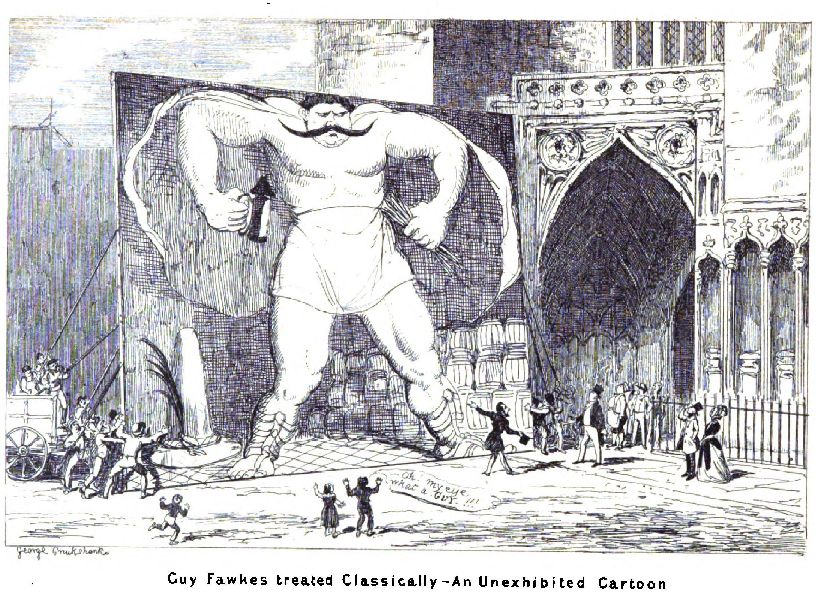
“Having strolled towards Westminster Hall to survey the scene of my future triumphs, it struck me that I had carried the grand classical to such a height as to preclude all chance of my cartoon being got in through the doorway; and I therefore, with the promptitude of a Richard the Third, determined to ‘off with his head’ by taking a slice off the top of the canvas. This necessary piece of execution rather spoiled the design, but it enabled me to throw a heaviness into the brows of my principal figure, which, if it marred the resemblance to Fawkes, gave him an additional look of the Guy at all events. It then occurred to me that I might diminish the dimensions by taking a couple of feet off the legs; and this happy idea enabled me to carry out the historical notion that Fawkes was the mere tool of others, in which case, to cramp him in the understanding must be considered a nice blending of the false in art with the true in nature. The Guy’s feet were accordingly foreshortened, till I left him as he appeared when trying to defend himself at his trial, with hardly a leg to stand upon. Besides, I knew I could fresco out his calves in fine style, when once I got permission to turn the fruit of my labours into wall fruit on the inside of the Houses of Parliament.
“It will now be naturally asked why my cartoon was not exhibited with others, some of which were equally monstrous, in the Hall of Westminster. The fact is, if the truth must out, the cartoon would not go in. Though I had cramped my genius already to suit the views of the Commissioners and the size of the door, I found I must have stooped much lower if I had resolved on finding admittance for my work. I wrote at once to the Woods and Forests, calling upon them to widen the door for genius, by taking down a portion of the wall: but it will hardly be believed, that though there were, at the time, plenty of workmen about the building, no answer was returned to my request. Alas! it is all very well to sing, as they do in Der Freischutz, ‘Through the Woods and through the Forests,’ but towards me the Woods and Forests proved themselves utterly impenetrable.
“It will be seen that the arch-conspirator—for so I must continue to call him, though he could not be got into the archway—has placed his hat upon the ground, a little point in which I have blended imagination with history, and both with convenience. The imagination suggests that such a villain ought not to wear his hat; history does not say that he did, which is as much as to hint that he didn’t; while convenience, coming to the aid of both, renders it necessary for his hat to lie upon the ground; for if I had tried to place it on his head, there would have been no room for it There was one gratifying circumstance connected with this cartoon, which, in spite of my being charged with vanity, I must repeat. As it was carried through the streets, it seemed to be generally understood and appreciated; every one, even children, exclaiming as it passed, ‘Oh! there’s a Guy!’
“George Cruikshank.”
There was some bitterness in this jesting; for Cruikshank felt conscious of the latent power to execute a cartoon about which there should have been no buffoonery. Alas! his lines had been cast in humble places. He had lived to earn his bread from day to day in the grotesque market; and the solemn and poetic side of his genius had been left unworked, or had been only partially and fitfully developed as he became an illustrator of books.
In the Almanac which included the Guy Fawkes cartoon appeared Cruikshank’s Father Mathew, a nice man for a small party. Father Mathew appears in the shape of a pump or filter to a convivial domestic circle, and holds parley with them. The animated pump, with the extended handle for a warning arm, and the spout for a nose, is an old Cruikshankian figure. “Touch not—taste not,” says the preacher-pump: “if you must take anything, take the Pledge.”
Paterfamilias, with a severe frown and aggressive attitude, has turned upon the intruder. “Dost thou think,” he says, “because thou art virtuous, there shall be no more cakes and ale?” Pater’s friend is more insinuating, and has an excuse. “Why, you see, old gent,” he remarks, “the case is this—the ladies insist upon my singing a comic song, and I should like to know how I am to manage that over a glass of pump-water.” The grandfather pleads: “Won’t you allow an old gentleman a little warm elder wine this cold night?” And the buxom lady of the house is coaxing: “Pray take a chair, sir, and taste my home-made wine, or a glass of our home-brewed ale.” These suggested compromises expressed very faithfully the mood of the artist’s mind at the time. His sympathies inclined him towards the Apostle of Temperance; but he was not yet prepared to go over, body and soul, to the cause. The picture is accompanied by an “Ode to Father Mathew,” conceived in a spirit of hearty opposition, that only goes towards proving that Cruikshank was at the half-way house of elder and home-made wines and home-brewed beer, between the punch bowl and the pump. The ode is in the fine old style:—
“Oh, Father Mathew I why dost thou incline Against all spirits thus to whine? To preach against good liquor is a scandal. Why to such rash conclusions jump— To airy, dull, unsocial pump, Why give a handle? Water is very well—but then ‘tis known That well is always better let alone. Washing is water’s only function, Save when a little drop poured in— To brandy, whisky, rum, or gin, Makes glorious grand junction.”
The kindly humourist’s etching-needle was inspired by every good cause. These almanacs have all morals underlying the fun. Cruikshank liked to have an object in view. No class, no creature was too humble for his sympathy. Landseer never drew anything better than the plate of the Dog-Days—suggested by “the Dogs Bill” of 1843. Two hard-working, very radical dogs who are drawing a truckful of hardware, scowl at a pair of genteel dogs, extravagantly arrayed, and smoking cigars, who cross their path. First radical dog says he believes they don’t know the side “their tails hang on,” they are so proud—adding, “Why, a cousin of mine, as lives at Barking, tells me as how the celebrated dog Billy has grown so proud that he has declined to kill any more rats. And as to cigars! why bless you, there ain’t a Puppy about Town but wot has got a cigar stuck in his mouth.” In a corner a watch-dog and a dancing dog are talking over their grievances; while in the distance a lady tells her footman to take care her spaniel, Duchess, does not get her feet wet. The dogs are inimitable. Bloomers, crinoline, over-population (a Cruikshankian plate showing the housetops covered with the superabundant humanity), the “steamed-out” stage-coachman, the “fast man,” female parliaments, baby-jumpers, cheap excursion trains, taking the census, the effect of the Peace Society (a regiment hay-making), Jullien as the President of the French Republic, “with entire new politics and polkas,” a pack of knaves, being a meeting of the betting interest,—these are but a few notable pictures of the crowded gallery. Cruikshank revelled in the fun, and sought to extract wisdom from it He had an old-fashioned idea of woman and her rights, and was sharp with his needle over female suffrage, ladies in pantalettes, and women of mind.
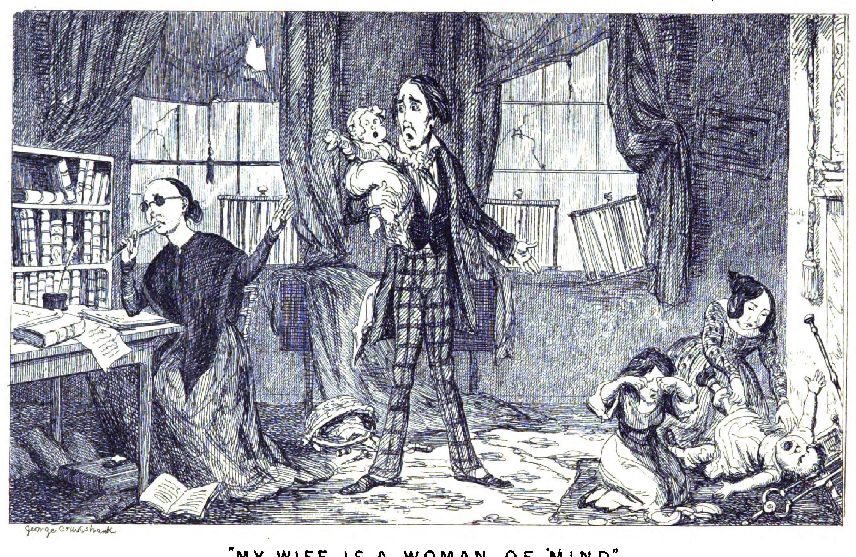
Henry Mayhew wrote some verses on a woman of mind, during one of the years of his editorship (1847), beginning,—
“My wife is a woman of mind, And Deville, who examined her bumps, Vow’d that never were found in a woman Such large intellectual lumps. ‘Ideality’ big as an egg, With ‘Causality’—great—was combined; He charg’d me ten shillings, and said, ‘Sir, your wife is a woman of mind.’”
Cruikshank’s picture of her is one of his stereotyped, ill-favoured, stuck-up, figureless ladies, of whom a friend said one day, when looking over some sketches, in Amwell Street, “Why, George, your females are all shaped like hour-glasses.”
For pure fun nothing could be better than the “Banquet of the Black Dolls,” in commemoration of the reduction of the Duty on Bags. The doll who occupies the chair has before her a Grand Potage de Dripping, and the menu includes Pâté de Horseshoes, Omelette de Old Iron, Bones Boil-é, Rag-out de Superior White Linen Rag, Fricassée de Broken Glass, and Poudin Kitchen Stuff.
The arrival of Tom Thumb, and his reception by the élite of society, as the bills said, and the brilliant court he held under a shower of John Bull’s gold in Piccadilly, suggested two scenes to hard-working and most moderately-paid Cruikshank. The first is called “Born a Genius.” In a garret a poor artist sits in despair and poverty—his empty plate upon the table, his tattered boots upon the floor. The second is called “Born a Dwarf.”
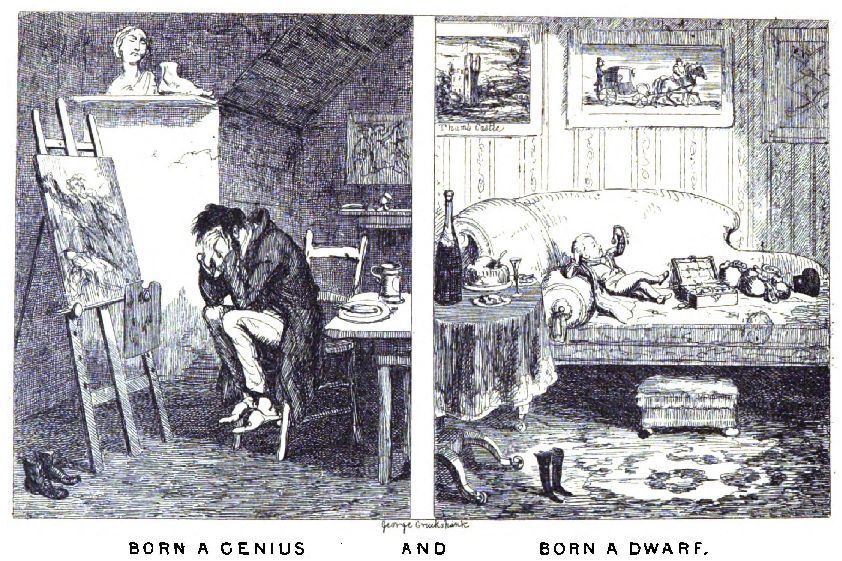
The little man reclines upon a sofa, with a jewel-case and full money-bags beside him. He toys with a trinket, having finished his foie-gras and champagne.
He had seen inexcusable personalities in the paper, he remarked; and when Lemon said to him, “We shall have you yet,” George shouted in reply, striking one of his theatrical attitudes, “Never!”
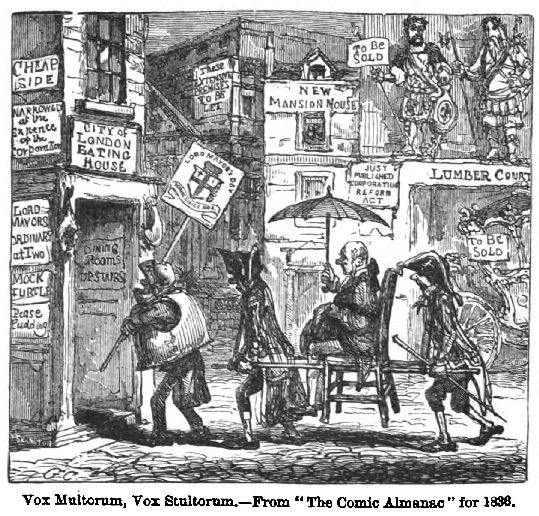
He had repented of his early days of unscrupulous caricature. It must be remembered, always to Cruikshank’s lasting honour, that, his wild youth past, he refused scores of tempting offers of work that did not quite commend itself to his conscience. He used to say he would illustrate nothing which he did not feel.
Later, when Punch goodnaturedly rallied him on his temperance eccentricities, he declared that he had a great mind to go down to Fleet Street “and knock the old rascal’s wooden head about.”
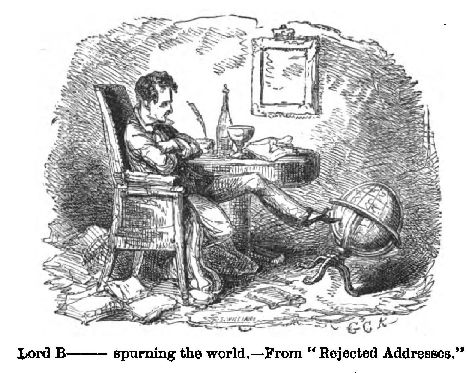
Between 1837 and 1847, in addition to his work with Dickens and Ainsworth, and in his Omnibus and “Comic Almanac,” Cruikshank threw off some of his most popular minor drawings and etchings. Within this decade he etched many of his plates for the “Waverley Novels,” he illustrated “Peter Parley’s Tales about Christmas,” “Rambles in the Footsteps of Don Quixote” (1837), “More Hints on Etiquette” (1838), “Lympsfield and its Environs” (1838), “The Life of Mansie Waunch (1838) for Blackwood, “Land-Sharks and Sea-Gulls” (1838), “Rejected Addresses” (1838), “Out and About,” a boy’s adventures, by Hain Friswell (1840), John O’Neill’s poem of “The Drunkard” (1842), Dibdin’s Songs (1841-2), “Picnic Papers” (1841), edited by Dickens; Douglas Jerrold’s “Cakes and Ale” (1842), “Modern Chivalry, or a new Orlando Furioso” (1843); Martin’s “Vagaries,” a sequel to “A Tale of a Tub” (1843); “The Bachelor’s own Book, or the Life of Mr. Lambkin, gent” (1844); Harry Lorrequer’s “Arthur O’Leary” (1844); Maxwell’s “Irish Rebellion” (1845), “The Old Sailor’s Jolly Boat” (1845), “The Comic Blackstone” (1846), Mrs. Gore’s “Snow-Storm” and “New Year’s Day” (1845), “Our Own Times” (1845), the Brothers Mayhew’s “Greatest Plague of Life” (1847), “The Emigrant,’ by Sir Francis Head, Captain Chamier’s “Ben Brace” (1847), “Nights at Mess,” and Laman Blanchard’s “Sketches from Life.” He also began his capital illustrations to “The Ingoldsby Legends,” in Bentley’s Miscellany. To this period, also, his wellknown “John Gilpin” and “Lord Bateman” (1839) belong.
According to Mr. Walter Hamilton, the history of the “Loving Ballad of Lord Bateman” is, that George Cruikshank “sang the old English ballad, in the manner of a street-ballad singer, at a dinner of the Antiquarian Society, at which Dickens and Thackeray were present.
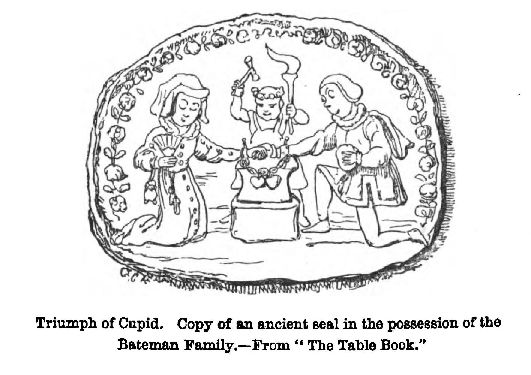
The latter is reported to have remarked, “I should like to print that ballad, with illustrations.” But Cruikshank warned him off, saying that this was exactly what he himself had resolved to do. The original ballad was much longer than that which Cruikshank illustrated, and to which Charles Dickens furnished humorous notes; and was not comic in any respect. Mr. Sala’s version is the more vraisetnblant:—
“The authorship of the ballad itself, which has furnished the basis for no less than three theatrical burlesques—one by a forgotten dramatist at the Strand, another by Robert Brough at the Adelphi, and a third by Henry J. Byron at the Globe—is involved in mystery. George Cruikshank’s assertion, and one to which he doggedly adhered, was that he heard the song sung one night by an itinerant minstrel outside a public-house near Battle Bridge; and that he subsequently chanted and ‘performed’ (George was as good as any play, or as a story-teller in a Moorish coffee-house, at ‘performing’) the ditty to Charles Dickens, who was so delighted with it that he persuaded George to publish it, adorned with copper-plates. But internal evidence would seem to be against the entire authenticity of the artist’s version. That he had heard some doggerel sung outside a tavern, and relating to Lord Bateman, is likely enough. ‘Vilikins and his was immortalised by Robson in Jem Baggs. George Cruikshank’s error, it strikes us, was more one of omission than of commission. He may have lyrically narrated the adventures of the ‘Noble Lord of High Degree’ to Dickens; but he assuredly warbled and ‘performed’ them too in the presence of Thackeray, who in all probability ‘revised and settled’ the words, and made them fit for publication. Nobody but Thackeray could have written those lines about ‘The young bride’s mother, who never before was heard to speak so free,’ and in the ‘Proud Young Porter’ all Titmarshian students must recognise the embryo type of James de la Pluche.”
“Lord Bateman” was Cruikshank’s delight. The exquisite foolery expressed in his plates of this eccentric nobleman he would act, at any moment, in any place, to the end of his life. Mr. Percival Leigh remembers a characteristic scene at the Cheshire Cheese tavern, in Fleet Street, about 1842 or 1843. “This,” * he says, “was in G. C.‘s pre-teetotal period. After dinner came drink and smoke, of course; and G. C. was induced to sing ‘Billy Taylor,’ which he did with grotesque expression and action, varied to suit the words. He likewise sang ‘Lord Bateman,’ in his shirt-sleeves, with his coat flung cloak-wise over his left arm, whilst he paced up and down, disporting himself with a walking-stick, after the manner of the noble lord, as represented in his illustration to the ballad.”
Six-and-twenty years afterwards we find the bright-hearted old man still with spirits enough for his favourite part.
* Letter to B. J., Feb. 18,1878.
“One day,” says Mr. Frederick Locker, “he asked us to tea, and to hear him sing ‘Lord Bateman’ in character, which he did to our infinite delight. He posed in the costume of that, deeply interesting but somewhat mysterious nobleman. I am often reminded of the circumstance; for I have a copy of ‘Lord Bateman’ (1851), and on the false title is written—
‘This Evening, July 13, 1868, I sang LORD BATEMAN to My dear little friend Eleanor Locker. George Cruikshank.’”
This in his seventy-sixth year!
Within the busy decade, 1837—1847, Cruikshank executed many separate etchings for Bentley’s Miscellany and Ainsworth’s Magazine. His work is to be found scattered far and wide. One month he appears as the illustrator of a humorous song or scena by J. Blewitt—“The Matrimonial Ladder” (the ladder was a favourite form with him for conveying the various aspects of a subject)—or Keeley in the new comic song of “Wery Ridiculous”; the next he is the whimsical illustrator of Beaufoy’s Advertisement of his Cure for the Toothache—wood drawings engraved by Orrin Smith. Nor had he quite put aside his habit of expressing himself pictorially on political events. In 1843 he published, from Mr. David Bogue’s shop in Fleet Street, a separate design entitled “The Queen and the Union. No Repeal! No O’Connell!” It was a woodcut enclosing text in type, the text being Cruikshank’s own declamation against the Irish Agitator. Britannia and Erin are represented in the drawing seated, with joined hands, on the shores of the Channel; while the “blustering, foul-mouthed bully, with one foot on Britannia’s shoulder, and the other on Erin’s harp, has raised an axe to sunder the friends.” Frontispieces and covers he designed by the score,—now to “A Tale of a Comical Stick,” and now to The Yorkshireman, a religious and literary journal; and now again a headpiece to one of Mrs. S. C. Hall’s “Sketches of Irish Character,” or a frontispiece to a book on “Prisons and Prisoners.” To every item of this extraordinary quantity and variety of pictorial labour Cruikshank gave his utmost energy. He was a most faithful worker, who never stinted himself, even when the humblest or least important subject was in hand. Let me note, however, some exceptions.
* Letter to B. J.
In 1843 he had quarrelled with Mr. Bentley, and purposely put bad work in them. This was his revenge—and to the end of his life he never perceived the fault he committed in this act. “One day,” says Mr. Locker,* u at my house, he explained how these (the bad etchings) had been etched. It appears that he had quarrelled with Mr. Richard Bentley (he was a singularly kind-hearted man, but, I fancy, had a somewhat remarkable faculty for quarrelling with almost every one with whom he was connected in business), and was obliged to fulfil his contract to supply an etching for each monthly number of Bentley’s Miscellany, and he did them as badly as he possibly could, and etched his name under them so illegibly as to be quite indecipherable: ‘And,’ said he, ‘I used to take out my watch, and put it beside me on the table, and give myself just—’ (mentioning the number of minutes) ‘for each plate.’”
It was after another and a final parting from Mr. Ainsworth, on the sale of his magazine, that Cruikshank, “left in the lurch,” to use his own phrase, started his “Table-Book,” with Gilbert à Beckett as editor, and Bradbury and Evans as printers and publishers. The artist has put on record the manner in which he and the eminent Whitefriars firm came together:—
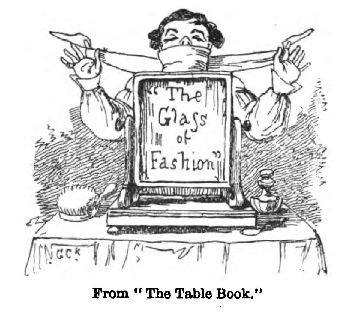
“I will not go into the details of how I assisted this author (Ainsworth) with head and hand work in these novels, but I did my best to design and suggest; and my time was so much occupied in performing this duty, and also with some other matters, that I was not able to bring out my Omnibus as an annual, as I had intended to have done; but I now determined to bring it out again in monthly numbers; and as Bradbury and Evans (the fathers of the present firm) had printed that work for me, I went to their office to see what stock there was of the Omnibus on hand, and to make arrangements for the republishing of it; and when I mentioned this to my friend Bradbury, he said, ‘Ah, it is a pity that work was ever stopped; we should have been glad to have bought it of you, and will buy it now, if you would like to sell it.’ I replied that I did not wish to dispose of it, but if they would like to join me, I should be glad to have them as partners. ‘Agreed,’ said both Mr. Bradbury and Mr. Evans; and as these friends of mine were men of business, as well as gentlemen and men of honour, in this case there was a written agreement clearly and legally drawn out, and duly signed by both parties. But their engagements at that time were so many, that a considerable time elapsed before arrangements could be made for the republishing of the Omnibus; so they then suggested, as it was such a long time since my Omnibus had been on the road, that it would, perhaps, be better to start another vehicle of the same build, but under another name. To this I agreed; and thus originated ‘The Table Book,’ which was edited by my friends the late Gilbert à Becket and Mark Lemon.”
The “Table Book” includes two of Cruikshank’s most powerful and perfect etchings—viz., “The Triumph of Cupid” and “The Folly of Crime.” The fertility of imagination manifest in “The Triumph of Cupid” is amazing. The execution is that of an original master. No man who ever held an etching-needle has surpassed the truth and beauty and boldness of the touches by which hundreds of figures live, a happy tumultuous throng, in this octavo plate. The central figure is the artist, in slippers and embroidered dress-ing-gown, before his fire, smoking a handsome meerschaum pipe, gazing abstractedly into the fire; and upon the cloud of smoke from his lips, his dreams of the triumphs of Cupid rise till they fill the room.
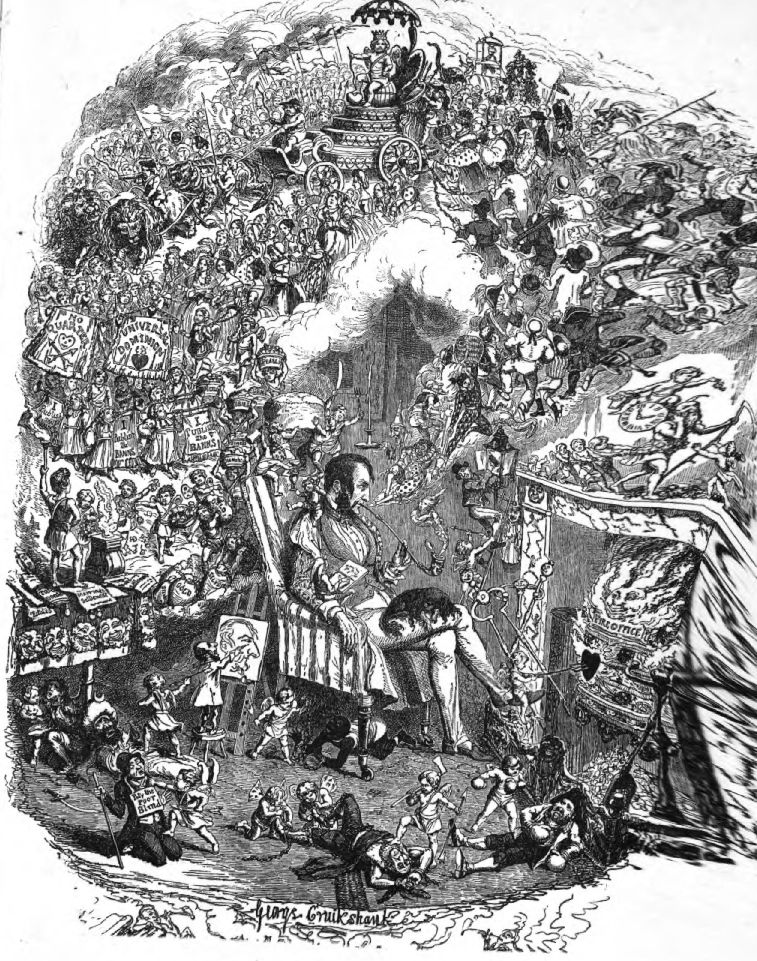
Cupid perches himself upon his foot, and toasts a heart at the fire; jumps upon the back of Old Time who bears the clock upon the mantelpiece; is enthroned in a triumphal car, with kings and princes, bishops and generals, lawyers and stock-jobbers, drummer-boys and jack-tars and sweeps, clown and harlequin, and even slippered pantaloon, and Chelsea pensioners upon wooden stumps, for his court. The car is drawn by subdued lions and leopards.
The blind beggar is waylaid by the little god, and brought to the ground. He has floored a dustman on his rounds. He makes the Great Mogul sue for mercy. He drags a little black page from under the armchair, and puts gyves upon his wrists. All is clearly and beautifully grouped, and frankly and boldly, and at the same time delicately, drawn. It is as precise and luminous as Durer. It is perfect etching, by one who knew the limits as well as all the capabilities of his exquisite art.
“The Folly of Crime” has been not extravagantly described by a writer in the London Quarterly Review (1873) as a very great work indeed. He says it is perhaps the artist’s highest effort: I should rather say it “is clearly and beautifully, and at the same time precise and luminous by one who knew the value of his exquisite art. He says it suggests an undeveloped power of the highest order—albeit the management of the direct and reflected lights is most admirable, and the skill throughout is consummate. “Without lingering over the framework of lesser groups, though these are sufficiently impressive,” says the reviewer, “let us go straight to the central picture. A murdered man lies stark in the shadow. The murderer springs forward to catch at, a bowl of pearls, snake-like and seemingly incandescent, that are borne swayingly before him on the head of a grinning fiend. The ground smiles at his feet. He falls, and, as he falls, the light from the pit leaps up, catching his bloody hand, and the fatal knife, and the long ears of his fool’s-cap, and gleaming in his despairing eyes; while all the air is filled with chattering and mowing demons, whose eyes and teeth also glitter white and cruel. And the horror of the man’s face is terrible.” The little morals framed around the central picture complete the awful story. The murderer lies—always wearing the fool’s-cap—in his bed, with a heavy weight upon his chest, snakes hissing in his ears, and the scales of justice held steady before his eyes. He is upon the treadmill. He crouches in a corner of the condemned cell. A convict, he carries a weighty burden upon his shoulders, marked “for life.”
The many light, playful, and fanciful sketches that are included in the one thin volume to which in “The Table Book” ran, are trifles light as air, when compared with those two great efforts of Cruikshank’s genius, at its ripest and brightest. They mark the highest point of his ascent. In the sequel we shall find him executing much noteworthy, honourable Work,with the zeal of a great moral preacher; but he will not surpass these two noble etchings.

George Cruikshank worked, as he reader knows, with great care and deliberation. He thought out his subject well before beginning to realize his conception. He made, to begin with, a careful design upon paper, trying doubtful points on the margin of the paper. The design was heightened by vigorous touches of colour. Then a careful tracing was made, and laid, pencil side down, upon the steel plate. This was carried to the printer, who having placed it between damp paper, and passed it through the press, returned it, the blacklead outline distinctly appearing upon the etching ground. And then the work was straightforward to the artist’s firm hand. The firmness and fineness of his touch are as conspicuous in his wood drawings as in his etchings.
“It was the custom of the artist,” according to his nephew, Percy Cruikshank, “before parting with his plates, to have India-paper proofs of the etchings, and this being ‘before letters’—that is, before the title was engraved on the plate—made them the more valuable. He also insisted on the engraver’s supplying him with a proof of his drawings on wood when completed. This, in time, formed a scarce and choice collection, of which he knew the value full well. The centralizing all that was Cruikshankian within himself was the end which crowned the work. The late Prince Consort being desirous of possessing a collection of George’s proofs, offered a considerable sum for them; but the artist, although pressed for money, not considering it sufficient, respectfully declined the proposal.”
To return to the “Table Book.” The miscellaneous etchings and drawings in this book are mostly arrows aimed at folly as it was flying at that time. The railway mania, clairvoyance, emigration, the fashions, furnished Cruikshank with inexhaustible humorous or grave material. His etching of Mr. John Ball in a Quandary, or the Anticipated Effects of the Railway Calls, is one of those wondrously filled drawings, in the composition of which he stands alone. John Bull is in his armchair, with a great railway bell clanging over his head. Hosts of pestilent demons cover him, and are stripping him. Some are hoisting his hat, some are bearing away his wig, others have perched ladders against his capacious paunch, and are dragging his money and his watch from his waistcoat pockets. The greedy imps are tugging his gloves from his hands, unfastening his neckcloth, and pulling his boots off. Liliputian lawyers, at hand, are demolishing a barrel of oysters, and leaving a plentiful supply of shells for their clients. Imps, driving a little locomotive, have attached it to Bull’s cash-box, and are making off with it; and in the distance the pictures are marked for sale. Then we have a few bits of Cruikshankian humour called “‘Heads of the Table,”—the final head being a capital study of an old gentleman who is entre deux vins, saying, “Well, we’ll just take another glass—and then—we’ll join the—the ladies.” Opposite this page is a drawing of a family, and also of their shoes.
I will now endeavour to afford the reader an idea of the man who created the extraordinary variety of artistic work of high excellence briefly described in the foregoing chapters. George Cruikshank was eminently a convivial man. He was born in a boisterous and coarse convivial time; when Lords and Commons boxed at Jackson’s; went to see monkeys set to fight terriers at Cribb’s; fought “Charleys” and turnpike-men; and drank hard and played high at Crockford’s. Their humble imitators were the associates of Robert and George Cruikshank. George’s associates were tavern frequenters for the most part: in those days taverns were used by many of the men who now frequent clubs. The portrait of him drawn by Maclise was Cruikshank in his earlier and humbler time, when he was in the hands of the caricature vendors. The writer in Fraser says: “Here we have the sketcher sketched; and, as is fit, he is sketched sketching. Here is George Cruikshank (see Frontispiece)—the George Cruikshank—seated upon the head of a barrel, catching inspiration from the scenes presented to him in a pot-house, and consigning the ideas of the moment to immortality on the crown of his hat....

Of George Cruikshank the history is short. He stands too often and too well before the eyes of the public to render it necessary that we should say much about him; and we confess that of his earlier annals we know little or nothing.... The first of Cruikshank’s works known to us are his caricatures of George IV. and his friends. Tories as we were and are, and as we trust we still shall be, these comic picturings haunt our imagination. The poor old king in every attitude of ludicrous distress (the ‘Fat in the Fire’ was perfection); Copley (sketched, as we have been assured, merely from description, and yet a great likeness); Castlereagh (but even the professed caricaturist could not destroy the gentlemanly grace of that noble face and figure); the ‘Waterloo man,’ with his sword dropping into the scale against the pen; the various persons, jailors, jockeys, lawyers, and the rest, were first-rate. As Cruikshank himself says of Gillray, ‘He that did those things was a great man, sir,—a very great man, sir.’ To Cruikshank, however, they were productive of nothing but the fame of their cleverness and the odium of their politics; as Hone, for whom and his blockhead authors George’s talents floated the dire rubbish of the ‘House that Jack Built,’ and other witless productions, never paid him for what he had done. In all these stupid productions there were loud puffs at the power of the press. George never knew anything of it when in their hands but as a screw.* However, what he did, gave him fame and name.... Of course, George is, like all other men of undoubted genius, a most ill-used gentleman. As Mathews laments that the general obtuseness of the public will not recognise his talents for tragedy,—as Liston mourns over the delusion which applauds him in Sam Swipes and Paul Pry, and does not permit him to appear as the Damon or Strephon of a sighing opera,—so Cruikshank is shocked at the evil fate which consigns him to drawing sketches and caricatures, instead of letting him loose in his natural domain of epic or historical picture.
* According to a Reviewer of “Three Courses and a Dessert,” in Fraser (June 1830), the whole sum received by Cruikshank from Hone was £18; but this was not so.
Let him content himself; he can draw what will be held in honoured remembrance when ninety-nine out of every hundred of the great ‘masters’ of our ‘schools’ and a still larger proportion of all the R.A’s and A. RA.‘s that ever existed, or ever are doomed to exist, will be forgotten. The historical which we should cultivate is such as that which appears in his recently published ‘Sketch-Book,’ where, for example, the life of Bonaparte, whether as eagle soaring over the Alps, or eagle chained to a perch, is depicted in all its stages, from artillery lad on watch, through triumph, splendour, and flight to the little cock-hatted and round-paunched exile of St. Helena.”
Many years later Cruikshank had not quite given up his dream of the epic or historical picture; for the dream had been encouraged by the criticisms of some of the most thoughtful of his contemporaries, who set him on a level with Hogarth and Durer, and said that posterity would delight in him as one of our most venerated old masters.
But our present concern is with George Cruikshank as he lived, and moved, and impressed his friends. They all speak cordially of him. Poor Samuel Phillips, who was hearty in spirit, albeit he lived for many years at death’s door, says of him: “George is popular among his associates. His face is an index of his mind. There is nothing anomalous about him and his doings. His appearance, his illustrations, his speeches, are all alike—all picturesque, artistic, full of fun, feeling, geniality, and quaintness. His seriousness is grotesque, and his drollery is profound. He is the prince of caricaturists, and one of the best of men.”
In a whimsical account of an amateur strolling excursion, in which Cruikshank was one of the company (1847), supposed to be written by Mrs. Gamp, Dickens has vividly described the illustrator of ‘Oliver Twist’:—
“I do assure you, Mrs. Harris, when I stood in the railways office that morning, with my bundle on my arm, and one patten in my hand, you might have knocked me down with a feather, far less porkmangers which was a lumping against me, continual and sewere all round. I was drove about like a brute animal and almost worritted into fits, when a gentleman with a large shirt-collar, and a hook nose, and a eye like one of Mr. Sweedlepipes’s hawks, and long locks of hair, and wiskers that I wouldn’t have no lady as I was engaged to meet suddenly a turning round a corner, for any sum of money you could offer me, says, laughing, ‘Halloa, Mrs. Gamp, what are you up to?’
“I didn’t know him from a man (except by his clothes); but I says faintly, ‘If you’re a Christian man, show me where to get a second-cladge ticket for Manjester, and have me put in a carriage, or I shall drop.’ Which he kindly did, in a cheerful kind of way, skipping about in the strangest manner as ever I see, making all kinds of actions, and looking and vinking at me from under the brim of his hat (which was a good deal turned up), to that extent, that I should have thought he meant something but for being so flurried as not to have no thoughts at all until I was put in a carriage along with an individgle—the politest as ever I see—in a shepherd’s plaid suit with a long gold watch-guard hanging round his neck, and his hand a trembling through nervousness worse than an aspian leaf. Presently they fell into conversation.
“‘P’raps,’ he says,'if you’re not of the party, you don’t know who it was that assisted you into this carriage!’
“‘No, sir,’ I says, ‘I don’t indeed.’
“‘Why, ma’am,’ he says, a-wisperin, ‘that was George, ma’am.’
“‘What George, sir? I don’t know no George,’ says I.
‘"The great George, ma’am,’ says he. ‘The Crookshanks.’
“‘If you’ll believe me, Mrs. Harris, I turned my head, and see the werry man a-making pictures of me on his thumb nail, at the winder! While another of em—a tall slim, melancholly gent, with dark hair, and a bage vice—looks over his shoulder, with his head o’ one side as if he understood the subject, and cooly says, ‘I’ve draw’d her several times—in Punch,’ he says too I The owdacious wretch.’”
The melancholy gent with the “bage vice” was Leech.
In those days, and down to those days, Cruikshank was convivial—sometimes to excess. It was not for nothing that Maclise had drawn him seated upon a beer barrel.*
* His brother Robert drew his portrait as a young man, his hair and whiskers uncombed, cross-legged, in a contemplative mood, his dress in disorder, and called it “George in a Brown study.” It was a picture of him in his days of dissipation, when his sister-in-law would occasionally seize and wash and comb him, while he laughed at the absurdity of his position. He was very sensitive in later life about any allusion to his appearance. When Mrs. Stowe, in her book of London impressions, roughly described him as “an old man, with a keen eye and grey hair,” he was deeply mortified, and he addressed an expostulation to the papers. His portraits, by himself, in oil, abounded in his studio. They were marked with touches of chalk, giving a fresh curl to the whisker, a fiercer flash to the eye, a more effective arrangement of the hair; but not one was finished.
His fortunes threw him early among humble boon companions, at Grimaldi’s club and elsewhere, as we have seen; and his wild exuberant spirits and lively sense of humour made him king among them. Later, when Dickens knew him, he would fall away occasionally from his new and more dignified friends (who were not ascetics), and run a wild career for a night in his old haunts. Dickens used to describe one wonderful day—among others—he had passed with “the inimitable George.”
Dickens was living in Devonshire Place, and was just setting to work one morning in his library, when Cruikshank, unwashed and “smelling of tobacco, beer, and sawdust,” as Dickens described him, burst into the room. He said he had been up all night; was afraid to go home, and begged for some breakfast. While he was breakfasting, Dickens did his utmost to persuade him to go to bed. But George resolutely set his face against it.
He said he dared not even think of Islington. Seeing the state of affairs, Dickens closed his desk, and proposed to accompany his friend to face the domestic storm with him. But Cruikshank would only consent to a walk—the farther from Islington the better.
Dickens, under such circumstances, was an admirable friend. His cheery talk and wise counsel had great weight with Cruikshank; but each time he artfully turned the truant’s face east, he drew back with a—“No, no, Charley—not that way.”
And so they walked about the streets for hours, strolling in the course of the day into the famous aviary of the Pantheon in Oxford Street.* Here Cruikshank came suddenly face to face with one of Mrs. Cruikshank’s intimate friends. The scene which ensued, Dickens used to say, was one exquisitely farcical. And the manner in which he set forth the episodes of the long day in the streets, with Cruikshank’s droppings into various hostelries, and his final dejected departure homewards, utterly worn out, and having exhausted his faithful friend, was in his happiest vein.
* Dickens used to tell, with humorous details, how “George,” On another occasion, was refused admittance because he was plashed to the shoulders with mud.
“I remember him about 1846,” said Mr. W. H. Wills, another old friend. “He was then flirting with Temperance. I wanted him to dine at my house; but he excused himself, saying he should be led into temptation, and he had resolved to be a water-drinker thenceforth.” He did not go to dinner, but dropped in later—much excited; and when his host pushed the water-bottle towards him, he gently added brandy. The guests departed, leaving the hilarious George, with two others, to finish the evening; and when the trio got into the street, they found the old difficulty in restraining Cruikshank’s boisterous spirits. After trying in vain for something more than an hour to lead him home, they left him—climbing up a lamp-post!
The same friend hastens to tell me how generous this wild bon-vivant was, even in his more convivial moods:—
“The force of George Cruikshank’s character lay in the single-minded earnestness with which he carried out his objects. These throughout his life were numerous and always good. Zeal and energy glowed out of him upon whatever he undertook, whether saving a family from starvation (and there are instances in which he could only have done this at the risk of stinting himself), or rehearsing the character assigned to him in a private play, or commanding a regiment of volunteers, or advocating and advancing the temperance cause at every conceivable sacrifice of time and money. It was not until after his second marriage that he took to temperance. In his first wife’s lifetime he sacrificed to the jolly god rather oftener than occasionally; and surely no man drank with more fervour and enjoyment, nor carried his liquor so kindly, so merrily. Then was the time to hear him sing ‘Lord Bateman’ in character, and costume improvised from table-covers, table-napkins, and antimacassars—anything he could lay hands on—with the laughing help of his host. He was what Albert Smith called ‘great fun’ in this song at any time.
“Even when dependent upon his pencil and etching-needle for means of existence, if any good was to be done for a decayed brother artist or literary friend, George was only too ready (for his own prosperity) to throw down his tools, and stroll about the country with a theatrical company, or go anywhere to solicit subscriptions and make speeches, or to settle to his worktable again to make gratuitous sketches for bazaars and charities. When acting in Edinburgh, for Leigh Hunt’s benefit, with Charles Dickens and his brilliant dramatis personae, news came to him that a country editor, with a large family, whom he had often previously helped, was on the edge of ruin for the want of fifty pounds. ‘I must send it to the poor fellow,’ he said to Dickens, ‘immediately.’ ‘That would be very kind to him,’ answered Dickens, ‘but very unkind to yourself. By-the-bye, have you got fifty pounds in your pocket?’ ‘Oh dear, no,’ was Cruikshank’s reply, ‘but I want you to lend me the money to send to him—now—at once.’ Dickens’s rejoinder was not resort to his cheque book, but the remark that he knew George’s incapable friend would be as badly off as ever after the execution had been paid out of his house, even if the money was sent. ‘Then,’ he added, ‘you would deny yourself all sorts of things and be miserable till you paid me back. That I can’t stand, so I must decline.’”
On the day of his death, his old friend and fervent admirer repaid his kindness by sketching this loving portrait of him:—
“Only a few days ago there was extant—nay, it may be said, flourishing, in the midst of the life and bustle of the Great City, and to all seeming as lively and bustling as any citizen there—a hale, bright, active, elderly gentleman, whose age might, by the majority of cursory age-judges, have been set down as ‘a good sixty-five,’ but who was in reality closely verging upon ninety. A quarter of a century before his death he had looked—so those who knew him well loved to declare—much older than when he was past fourscore. Like the American lady mentioned by Dickens, he seemed to have grown old, ‘got over it,’ and become young again. He was slightly below the middle height, spare but solid of frame, somewhat long-armed and short-legged, as powerful and long-lived men are apt to be, and very broad in the chest. His head, scarcely bowed or blanched to the very last, was massive and well-shapen. He had a high forehead, blue-grey eyes full of a cheerful, sparkling light, penthouse brows, somewhat high cheek-bones, a prominent aquiline nose that Caesar would have liked to look upon, and a mouth cut in firm, sharp lines, and from whose corners grew an ambiguous pair of hirsute ornaments which were neither moustaches, nor whiskers, nor beard, but partook vaguely of the characteristics of all three. But, beyond these, there was curious and original individuality in his hair, which, after its fashion, marked him as typically as the well-known mèche marks the portraits of Napoleon L and M. Emile de Girardin. The elderly gentleman’s chevelure had dwindled down to a few thin locks, indigenous, it is to be feared, to his occiput, but which, by careful combing, and an artful contrivance—so rumour ran—of wire and ‘elastic,’ had been seduced over his temples and his parietal bone. Thus to the greater justice could point triumphantly to the fact that his sparse wisps of hair were still mellow brown in hue, and soft as silk in texture. His face was full of wrinkles; but the furrows seemed to have been ploughed more by hard work, sedulously and unwearyingly performed, than by the mere plodding footsteps of the dragging years. In his port and mien, indeed, until almost the very moment when the hand of the Grim Sergeant was laid upon his shoulder, there was but little of the feebleness and less of the caducity of age. Its garrulity he had; but his friends rejoiced in the good old man’s loquacity, recognizing, as they did, the undimmed clearness of his understanding and tenacity of his memory. Nor, with one singular exception, to which we shall subsequently allude, did that memory play him the woful tricks to which the very aged are so often subject. He could remember perfectly well trifling occurrences which happened in 1800, but he did not forget events of moment which had end he repudiated the imputation of baldness, and with happened in 1877. He was, to sum up, a light-hearted, merry, and, albeit a teetotaler, an essentially ‘jolly’ old gentleman, full physically of humorous action and impulsive gesticulation, imitatively illustrating the anecdotes he related; somewhat dogged in assertion and combative in argument; strong-rooted as the oldest of old oaks in old true British prejudices; decidedly eccentric, obstinate, and whimsical; but in every word and deed a God-fearing, queen-honouring, truth-loving, honest man.
“This was the famous George Cruikshank, caricaturist, social satirist and moralist, illustrator of books, engraver on steel and copper, draughtsman on wood, painter in oils and water-colours, the doughtiest champion, in his degree, of the temperance cause; and, albeit his ‘foaming bowl’ was for many years replenished only from the pump, the Prince of Good Fellows.”
The Prince of Good Fellows looked very much as his later friends remembered him, some five-and-thirty years ago, as I can well remember. The ingeniously arranged chevelure was within artful elastic bands drawn over the skull, when I was a boy. I was one of many youngsters who would creep round his chair clay pipe in his mouth (he always smoked a long clay pipe while he smoked at all) and his brandy-and-water before him, talking loudly and eagerly, gesticulating like a Frenchman, and turning now one ear and now the other, to catch the conversation of the company. A man incapable of rest, with a swift, glancing, steely eye, a mobile mouth, and a grotesquely fierce general aspect, aggravated by the hook-nose, which was awry; prodigal in the matters of whisker, shirt-collar, and wristband; old-fashioned enough, even in the year 1845, to strike boys. *
* George Cruikshank was very careful about any portrait of him that was drawn or painted. One in coloured chalks by his friend Mill, that hung in his Amwell Street studio, satisfied him entirely. The eyes were at their fiercest, and the whiskers were superb. One day, when Cruikshank was illustrating Scott, Mr. Lockhart called, and, remarking the portrait, said drily, “I saw a man, very like that, in Italy, executed for murder.” Some people would have been offended, but Cruikshank was delighted. He affected the brigand look.
In his social habits and relations, Cruikshank was a most modest, self-respecting man. He never courted great folk, he submitted to no form of patronage, and he never pretended to ape the manners and habits of the fashionable world. He lived the first half of his life in Pentonville,* and the second in Camden Town. He confined his acquaintance to congenial friends; and when these happened to be persons of rank and wealth, in its unfashionable neighbourhood. In this he set an example which many of his brother artists—his inferiors in genius—might have followed with advantage to their fame. He stood, at the end of his life, in strong contrast with the petits maîtres in the arts, who give themselves fashionable airs, decorate their houses extravagantly, and spend their too easily acquired gains in slavish imitations of Mayfair life. Cruikshank, in his Omnibus, reproved, in his own quaint way, a writer who had said that he was a collector of curiosities.
* Among the visitors to Amwell Street was the Baron de Berenger, a remarkable adventurer and spectator. George Cruikshank, when a young volunteer, had been intimate with Charles Ransom of his corps, who as a print colourer at Ackermann’s, and who, as a volunteer, was remarked as a good shot. Being a well-mannered young fellow, he was patronized by Mr. Hammerley the banker; and at this gentleman’s house he met the Baroness de Berenger, a German widow. He married her, and assumed the title of Baron de Berenger. Being a man fond of athletics, he conceived the idea of turning Cremorae Farm, Lord Cremome’s place at Chelsea, into a suburban gymnasium and place for field sports. Cremorne Farm became the Stadium, and flourished under the Baron’s management. He rode out always attended by his four sons on horseback, dressed in grey military tunics, and with swords at their sides. This cavalcade occasionally clattered along Amwell Street, Pentonville, to pay a business visit to Cruikshank, who, with his brother, was illustrating with sporting etchings the guide-book to the Stadium.
“No single symp—I was about to say that no single symptom of a curiosity, however insignificant, is visible in my dwelling, when by audible tokens I was (or rather am) rendered sensible of the existence of a pair of bellows. Well, in these it must be admitted that we do possess a curiosity. We call them ‘bellows,’ because, on a close inspection, they appear to bear a much stronger resemblance to ‘bellows’ than to any other species of domestic implement; but what in reality they are, the next annual meeting of the great Scientific Association must determine; or the public may decide for themselves, when admitted hereafter to view the precious deposit in the British Museum.” Then follows an amusing account of the old bellows, with a sketch of them. “The origin of the bellows I know not,” says their owner; “but a suspicion has seized me that they might have been employed in the Ark, had there been a kitchen fire there; and they may have assisted in raising a flame under the first tea-kettle put on to celebrate the laying of the first stone of the great wall of China.”
Cruikshank, moreover, took exception to the description of his person by the same writer. If careless about his house, he was vain of his person. The writer said: “In person, G. C. is about the middle height, and proportionbly made. His complexion is something between pale and clear; and his hair, which is tolerably ample, partakes of a lightish hue. His face is of the angular form, and his forehead has a ‘prominently receding shape.” Cruikshank closed with his antagonist:—
“As Hamlet said to the ghost, I’ll go no further! The indefinite complexion, and the hair ‘partaking’ of an opposite hue to the real one, may be borne; but I stand, not upon my head, but on my forehead! To a man who has once passed the Rubicon in having dared to publish his portrait, the exhibition of his mere profile can do no more injury than a petty larceny would after the perpetration of a highway robbery. But why be tempted to show, by an outline, that my forehead is innocent of a shape (the ‘prominently receding’ one) that never yet was visible in nature or in art? Let it pass, till it can be explained.
“‘He delights in a handsome pair of whiskers.’ Nero had one flower flung upon his tomb. ‘He has somewhat of a dandified appearance.’ Flowers soon fade, and are cut down; and this is the ‘unkindest cut of all.’ I, who, humbly co-operating with the press, have helped to give permanence to the name of dandy—I, who have all my life been breaking butterflies upon wheels in warring against dandyism and dandies—am at last discovered to be ‘somewhat’ of a dandy myself.
‘Come, Antony, and young Octavius, come! Revenge yourselves’ as you may; but, dandies all, I have not done with you yet.”
The “inimitable George,” however, was a dandy—in his way. Old-fashioned, tumbled, eccentric, his dress had a studied look. The strong individuality of the vivacious and active little man (for he was under the middle height) appeared to be preserved by attention to the elaboration of a costume unlike that of any of his neighbours. It was foppishness like that of the late Marquis of Lansdowne, whose buff and blue had become a fancy dress at the end of his life.
I cannot do better than conclude this description of the George Cruikshank of the first epoch, by an account of him, in 1840-42, written by his old friend W. L. Sammons, who is now a Temperance light at the Cape, but who has a vivid recollection of his friend in days when they met over a mug of ale. It comes to me from Cape Town. The scene opens in Amwell Street, Pentonville:—“The same evening a friend or two dropped in—Douglas Jerrold and, I think, Laman Blanchard, the editor of Cruikshank’s Omnibus,—and the former Mrs. Cruikshank was present and presided, and threw a charm over the tea and supper tables; and I saw and revelled, as it were, through all the gems, both ancient and modern, signed “G. Ck.,” in the Royal workshop, and lingered over that famous notorious Screen in it, covered by him with texts of thought for present and future use, in the shape of “Odd People and Things”—queer “head and tail pieces”—strange “monstrosities of Fashions” for the day—noses, dresses, and phizes of all dimensions and shades, ready for adaptation according to the age and epoch required. George Cruikshank was particularly busy on this day, because of “The Miser’s Daughter,” by Ainsworth, that he was illustrating for Bentley’s Miscellany, and he assured me if not finished by such an hour and such a day he should forfeit fifty pounds; and yet he risked the uncertainty to show hospitality to his friends.
“During this visit to London, dear George took me the round of several of the theatres and gardens—Old Vauxhall, that we had seen as boys, when unknown to each other, being closed, and the great “M. C.”
Simpson dead; and I could not fail to perceive how he was petted and respected by all, lessees, managers, and actors, and readily ushered into any quarter that caprice, pleasure, or professional duties required, whether pit-boxes, or gallery; but the “dress circle” was less to his taste than others, because there life was fossilised, artificial, and restrained, and dress mere tinsel; and no dialogue suitable for his reports, or action worthy of his crayons. This may account, perhaps, for that ‘absence of beauty’ that is said to pervade his works; because beauty per se is apt to give itself airs and become unseemly and ungraceful; and George Cruikshank’s high and stern mission was in ‘the highways and hedges,’ and to reclaim by a moral and pictorial force the repelling, the vicious, and the vile.
“But I confess to feeling a little disturbed, when at his side, at seeing so many long necks and bright eyes and glasses turned upon him from all directions, and to perceive the whispering and commotion in consequence. Here G. C.‘s thumb-nails often served as ample Space for a photo.
“As a thing of beauty is said to be a joy for ever, so at the period above stated we had our glorious days together, and may be figuratively described as ‘being in clover and sleeping in lavender’; for kind George devoted many hours in taking me to some of his favourite, and it may be added, requisite haunts, where he gathered his Fame for his simple wants, without i hoarding. One morning he led me to the burial-ground of St. James’s Chapel, Pentonville, near his house, and pointed out the graves of Thomas Dibdin, son of the great sea-songster, and of his old and ‘mutual friend,’ Joey Grimaldi, whose mortal coils are laid near each other; and I wish I could remember so as to record the tender and sympathetic little oration he then delivered.
“At night Sadler’s Wells was the scene of action, but poor Joey being absent,
‘Greece was living Greece no more,’
and all things were changed since our boyhood Friend Cruikshank reminded me of that passage (in Dickens’s ‘Life of the King of Clowns’) that he illustrated in two vols., where Joey and his much better-half, one evening, disputing about precedency, resolved upon taking poison to end all contention, and to settle their differences of opinion for ever. But not taking enough, and forgetting the oft-quoted maxim, now travestied,
‘Drink deep, or taste not any poisonous thing,’
the feeble dose merely kept them awake and talkative, and lying in the same room, with a slight partition between them, sensations became unpleasant, and so they held a colloquy in their fears as follows: ‘Joey, are you dead?’ ‘No, Mary,—are you?’ ‘No.’ And then they altered their minds, and felt disposed to live a little longer, arose, had a good supper and something warm and comfortable as a sedative and antidote, and then jogged on a little more in unison.
“On passing through the Queen’s Bench with him, I called his attention to the prison window, behind the bars of which stood a miserable inmate with a black box before him, on which was written, ‘Remember the poor debtors.’ George smiled, and said, ‘Yes, but think of the poor creditors.’ And this scene I find recorded by him, and his own remarks, on a small placard at the top of the picture ‘Remember the poor creditors.’ But what numbers of similar Hogarthian hints he has left behind him!
Shortly afterwards Cruikshank paid his friend a visit at Bath:—
“‘The Bottle Conjurer’ and smasher of it, and part destroyer of his contents—I mean George Cruikshank—arrived safely at the city of King Bladud and the throne of Beau Nash; and he commanded me with a willing assent to become a second ‘Anstey,’ or little ‘Bath Guide,’ to ferret all quarters with him—West to East and High to Low—having a monthly serial still on hand that required certain characters for illustration (perhaps ‘Jack Sheppard’ or the ‘Tower of London,’ after the Omnibus had ceased running). Friend George began with the upper crust, as nearest ‘home’ and Lansdown; and leaving his card the day before at William Beckford’s mansion in the Crescent, went with me where I had been several times before. Possibly at the foot of Table Mountain it may not be known that this William Beckford was an esquire and a somebody in England, the owner and builder of Fonthill Abbey, inheritor but not enjoyer of immense wealth, and the celebrated author of ‘Vathek’ and the ‘Halls of Eblis,’ before which, in point of imagination, Byron, or somebody else, said ‘Rasselas’ must bow.”
Mr. Beckford, notwithstanding original gifts, and the accident of riches, was a shy and eccentric bird that flew from every one, and nobody must approach; and so, when we got there, and were passing along a corridor, door suddenly in our faces, the apology being, ‘he saw Mr. Beckford coming, and it was more than he dare hazard for any one to notice him.’ And yet he left a gracious message in the hands of his house-steward, Mr. F-, who himself kept a stylish establishment and carriage, ‘to show Mr. Cruikshank all he desired;’ and even added, ‘that if Mr. Cruikshank knew how much he (Mr. B.) valued his earlier sketches, he would not have refused some of them when once solicited.’ I asked ‘G. C.’ the cause of this, and he remarked, ‘at that time he parted with few of his originals;’ and when we left Lansdown Crescent, he commented warmly on the treat and pleasure he had derived, and as a red-letter day in his biography. ‘From the sublime to the ridiculous is but a step,’ and so we soon threaded the externals of Royal a black dwarf—or rather a nutmeg shade—banged a Anstey’s “New Bath Guide.”
Crescents and Circuses, Pulteney and Milsom Streets, and Queen Squares, and odd holes, lanes,’ and corners, until reaching Avon Street, where ‘the power of sinking could no further go,’ nor the Pig and Whistle meet with a more picturesque if degraded aspect In this latter neighbourhood it was requisite for professional purposes and home orders that George Cruikshank should have a nightly sojourn, if not revel; and so a suitable tavern was chosen that had a skittle-alley attached, that except in name or position might form a capital match for that Lion in the Wood in Wilderness Lane, that he mentions in ‘My Portrait,’ at the commencement of bis Omnibus. Whilst we were there as lookers-on only, and sipping ‘half-and-half’ out of the same pewter ‘between the acts,’ if they may be so called, or during the ‘intervals,’ at this Beggars’ Opera, friend Cruikshank amused himself by chalking one scene on the wall, and all eyes were soon upon it, for it was lifelike and spirited. Oh that I could have removed that wonderful cartoon from its surface, or preserved a copy! it would now realize the value of many ordinary frescoes and presumed originals—and more than drunken Morland’s ‘Goat-in-Boots’ signboard. But leaving Bath for Cape Town three months afterwards, the mind was absorbed in other matters, and both places and scenes forgotten at the time, but now stand out in bold relief and vividly.”
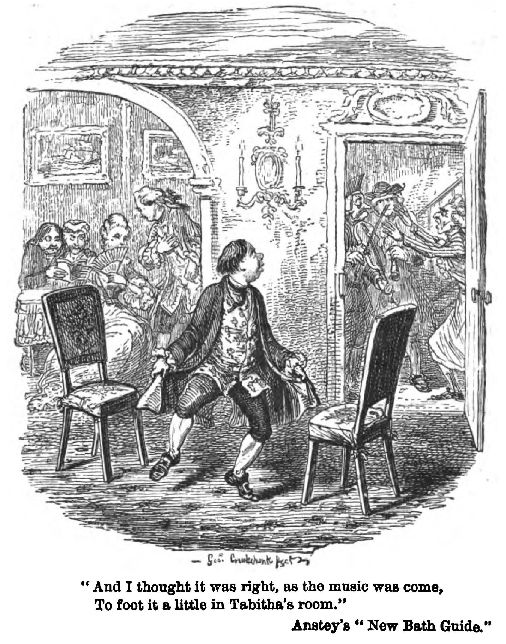
This was George Cruikshank only a few years before he gave himself wholly up to the cause of Temperance.
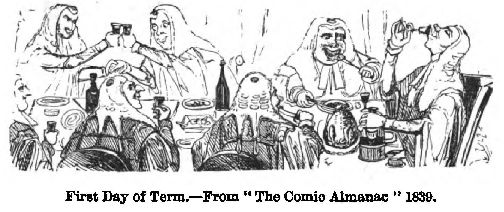
No great stretch of the imagination is needed to conjure up an interesting picture in the corner of the graveyard of St. James’s, Piccadilly, in that momentous June when the forces of France and the Allies were gathering hastily for the field of Waterloo. It was on the first of the month. From the famous print-shop of Mistress Humphrey in St. James’s Street, before which hosts of laughing men and women had been wont to linger, a coffin was home, containing the mortal part of the “Juvenal of caricature” as he had been called—of the hapless man of genius, who had lain, with short flashes of sanity, full six years with mind unstrung—a dreadful shadow over the mirthful shop. Behind followed the good Mistress Humphrey and her faithful Betty, her maid; probably stout Mortimer the picture dealer, possibly Mr. Gifford. Let us think of Landseer and James Stanley and others to whom poor Gillray had been known in his bright days, standing by the open grave near the Rectory House, within full sound of the hum of Piccadilly. And at hand we shall note a slim young man, with eager, piercing eyes, a hook nose, with fall whiskers trimmed to the corners of his mouth; a young man with incessant spasmodic action. His eyes start and his mouth works, as, the service ended, he gazes into the yawning grave. To his neighbour he says, under his breath, “A great man, sir—a very great man.”
With a bow to weeping Mistress Humphrey he retires. The good soul, who has now done her last duty to the poor madman with whom she has borne patiently and gratefully so long, is pleased to note that Mr. Cruikshank had not forgotten to pay his last tribute of respect and gratitude to his master. Mrs. Humphrey, no doubt, regarded the young man whom she had employed to finish Gillray’s work when he first fell ill, and who had since managed to keep the crowds laughing before her windows, as a very poor substitute for the dead genius. And in those days Cruikshank himself was still very modest, and was proud to be accounted strong enough to hold the pencil and the needle of the stricken Gillray.
Upon a sensitive, imaginative, observant man like George Cruikshank, the life of him whom he owned in his early days as his master, with its awful close, must have made a deep impression. Men said that Gillray had wrecked his career through frequenting low company, and by intemperate habits. Cruikshank knew something of this, had seen much of such company, and was in close companionship with tipplers. Gillray was not the first man of mark whom he had watched from tavern to tavern, and so on to poverty and death. Almost his earliest recollections were of drinking bouts, and their debasing consequences. His boyish sight had been offended at his father’s house with the spectacle of drunken men rolled up in carpets, upon whose blank and soddened faces the morning sun was shining.* He had been saddened as a son by his father’s example, and inexpressibly shocked by the manner of his death. It appears that Isaac Cruikshank, who was a heavy whisky drinker, laid a bet with a boon companion that he would drink more tumblers than his friend without falling under the table. He won his wager, but his excess brought upon him the illness of which he died, about his fifty-fifth year. **
* “At a meeting held at Manchester, this great artist gave an address on Temperance; in the course of which, referring to the early days of his life, and to the drinking habits which existed at that period, he said he recollected gentlemen coming to dine occasionally at his father’s house, and he was often surprised on coming downstairs of a morning to find some of them rolled up in the carpet in an extraordinary manner. His own father took too much drink, and shortened his life by it. He shortened his life by the fashion of the day, and left him (the speaker) uneducated.... He had watched the effects of drink ever since he had begun to reflect, both among the higher and lower orders.”—Poor Richards Almanac, 1876. ** This story was told to the Rev. Dr. Rogers by George Cruikshank.
Such experiences, albeit they led Cruikshank to reflect seriously on the evils of excessive drinking, did not, as we have seen, at once turn him from the bottle. Mr. Paget remarked in Blackwood that Cruikshank was a severe anatomist of the vice long before any idea of his celebrated “Bottle” could have crossed his mind. In his “Sunday in London,” published in 1833, he depicted the drunkard paying his week’s score. In one of his Temperance speeches he said: “I am ashamed to say that for many years I went on following the ordinary custom of drinking, till I fell into pecuniary difficulties. I had some money at a banker’s; he fell into difficulties, took to drinking brandy-and-water, and ended by blowing out his brains.
I lost my money, and in my distress applied to friends who aided me for a time, but they themselves fell into difficulties, and I was forced to extricate myself by the most extraordinary exertions. In this strait I thought, The best thing I can do is to take to water; but still I went on for some time before I quite weaned myself from my own drinking habits. I went to take luncheon with my friend Dickens (who, I am sorry to say, is not a teetotaler); he asked me to take wine, but I told him I had taken to water, for, in my opinion, a man had better take a glass of prussic acid than fall into the other habit of taking brandy-and-water; and I am happy to say that Charles Dickens quite agreed with me, that a mam had better wipe himself out at once, than extinguish himself by degrees by the soul-degrading and body-destroying enemy.”
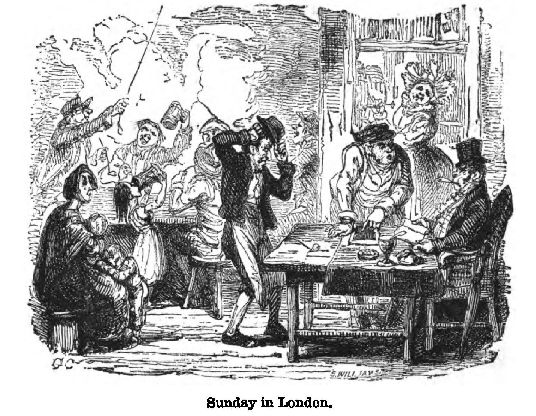
Immediately after the death of Gillray, we find evidence of the twinges of conscience which Cruikshank felt, even while he continued to fall, at intervals, into wild excesses. These were followed by dark passages of remorse, and by resolutions which were again and again broken. The fate of the men—and that of Gillray especially—whom he had seen fall victims to what he was pleased to call the fashionable vice, would rise before him. But, in an impulsive, convivial moment, his own sad experiences of time wasted and opportunities gone, and of the friends he had lost, were often forgotten; and he found himself, as of old, wending his way home, in the small hours, covered with a sense of disgrace. Cruikshank was no better, and no worse, than his contemporaries. A letter in Procter’s * neat hand lies before me. It is dated from Gray’s Inn Square, March 13th, 1839; and he says:
“I shall be very happy to be one of the number to dine with Macready. But, remember, I cannot be one of those who will doubtless be found under the table at four a.m. (as I understand was the case upon a late occasion).”
* Barry Cornwall.
If, however, Cruikshank was not early a convert to the practice of temperance, he was, as I have remarked, a preacher betimes.
His “Introduction to the Gout” (1818) is in his best vein. A toper is seated over his pot, and holding a peach upon his fork, with which he is about to cool his mouth. An imp—one Gout—approaches from the fireplace, and with the tongs is about to drop a red coal on the great-toe of Toper. Another drawing (a lithograph) of this date is suggestive. It is called “Deadly Lively.” Death has stepped in, surprising a man and two women, who are drinking in a kitchen, before a blazing fire. Death is filling the man’s glass; the old woman is falling from her seat, and the young man is tumbling drunk under the table. Presently (in the same year) the artist is in a gayer mood as a satirist. The picture is called “Tit-Bits.” An Irishwoman, overcome by beer, has fallen into a deep sleep under a tree. Her slumbers give a yokel an opportunity of stealing one of her chickens, while a cur licks the tarts in her basket.* Then we have “The Three Bottle Divine,” no rara avis in those days. It is the head of a heavy, coarse-featured man, in sporting guise, his face garnished with carbuncles and large spectacles.
So far back as 1836, Cruikshank gave the public a foretaste of “The Bottle” in a vignette to a music title. Two individuals are represented—one old and spectacled, the other young and with an eyeglass,—examining with horror the contents of a spirit bottle, which is filled with malignant imps emblematical of alcohol as “doctored by publicans,” and sold for “Old Tom,” etc. The cork has turned devil, and throws up his arms in delight at the work of his imps.
* The foregoing were drawn by Cruikshank from Captain Hehl’s designs.
“Gin” remarks Mr. Thackeray, years before Cruikshank had become a Temperance advocate, or in the least degree an abstainer; “gin has furnished many subjects to Mr. Cruikshank, who labours in his own sound and hearty way to teach his countrymen the dangers of that drink. In the ‘Sketch-book’ is a plate upon the subject, remarkable for fancy and beauty of design; it is called the ‘Gin Juggernaut,’ and represents a hideous moving palace, with a reeking still as the roof, and vast gin-barrels for wheels, under which unhappy millions are crushed to death. An immense black cloud of desolation covers over the country through which the gin monster had passed, dimly looming through the darkness, whereof you see an agreeable prospect of gibbets with men dangling, burnt houses, etc. The vast cloud comes sweeping on in the wake of this horrible body-crusher; and you see, by way of contrast, a distant, smiling, sunshiny tract of old English country, where gin as yet is not known. The allegory is as good, as earnest, and as fanciful as one of John Bunyan’s, and we have often fancied there was a similarity between the men.”
The similarity, if you look deeply into the two imaginations, is strong and striking, as it is between the genius of Doré in its grotesque and moral moods, and that of Cruikshank. Compare Doré’s “Wandering Jew,” his “Rabelais,” his “Contes Drolatiques,” with Cruikshank’s work about 1826, and even later, and you cannot fail to discover the strong affinity between the two great artists. Doré knew nothing of Cruikshank’s work in his early time, and Cruikshank had never heard Doré’s name when, in 1854, I brought over to England the blocks of his “Wandering Jew.” **
** I introduced George Cruikshank to Gustave Doré in the Doré Gallery in Bond Street. Doré looked wonderingly at the vivacious, wild old man as he went through a pantomime in default of French, to express his admiration of the pictures the gallery.
In his illustrations to “Sketches by Boz,” Cruikshank first approached intemperance from that point of view in which he treated it afterwards in “The Bottle.” His view of the gin-shop comprehends a complete story.
“We have sketched this subject, says Dickens, “very slightly, not only because our limits compel us to do so, but because, if it were pursued further, it would be painful and repulsive. Well-disposed gentlemen and charitable ladies would alike turn with coldness and disgust from a description of the drunken besotted men and wretched, broken-down, miserable women, who form no inconsiderable portion of the frequenters of these haunts; forgetting, in the pleasant consciousness of their own high rectitude, the poverty of the one and the temptation of the other. Gin-drinking is a great vice in England, but poverty is a greater; and until you can cure it, or persuade a half-famished wretch not to seek relief in the temporary oblivion of his own misery with the pittance which, divided among his family, would just furnish a morsel of bread for each, gin-shops will increase in number and splendour If-Temperance Societies could suggest an antidote against hunger and distress, or establish dispensaries for the gratuitous distribution of bottles of Lethe-water, gin palaces would be numbered among the things that were. Until then, their decrease may be despaired of.” Dickens here glanced, and only carelessly, at the surface of the great question. This poverty which he deplored was the result of the drink. The Lethe-water would be unnecessary if the gin-and-water were stopped. Poverty, dirt, hunger, promote the publican’s trade; but this trade breeds the misery on which it thrives. The quartern which the father drinks, helps to raise a customer in his son, for the trade of the publican’s son. More than ten years elapsed before this view of the Temperance question was destined to have complete sway and mastery over the genius of Dickens’s illustrator; but already he saw deeper into it, because he looked more earnestly into it than the writer, who had not yet done with the comedy element of drunkenness.
In 1841, Cruikshank drew for Bentley’s Miscellany an “allegorical representation of the infatuation of the mob for ardent spirits, and the drunkenness occasioned by an election, from a design by T. L. F.” * In 1846, he illustrated Our Own Times, and in the London Penetralia we find him moralizing with his etching-needle, in the ragged school of Chick Lane, Smithfield, and satirising, under the head of “A Tremendous Sacrifice,” the slop-sellers who live in luxury on the work of poor seamstresses.
* “In the centre of the composition is the pedestal of an altar, ornamented with a bas-relief of Britannia, on which is resting a barrel of liquor, inscribed, ‘Ruin Members and Co.—Poverty—Treadmill—Botany Bay,’ the tap running for the gratification of an assemblage of drunken wretches, who eagerly endeavour to get their favourite beverage, excepting those who are helplessly drunk or fighting.”—Reid’s Descriptive Catalogue.
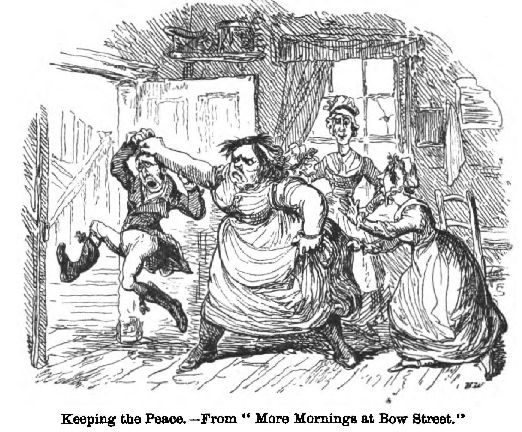
Cruikshank was now inclining strongly to the work to which he was destined to give the last thirty years of his life. And in 1847 he gave himself up heart and soul to the preaching, by example as well as by tongue and etching-needle, the moral which had haunted him so long, that had left him no rest till he grappled with and conquered it, since he had watched the eclipse of Gillray’s genius, and seen his own father hurried, by a boastful toper’s bet, to his premature grave.
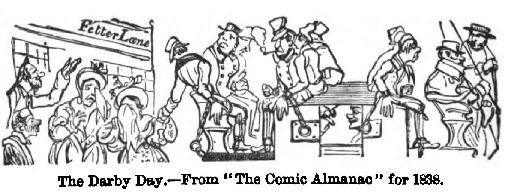
We have seen that many years before the Temperance question fastened itself upon Cruikshank’s mind, never to be blotted out again for a single day, he had marked and satirized the effects of drunkenness in the desolate home, the workhouse, and the gaol. His “Gin Shop,” where Death sets a trap for a party of topers, the “Ale-house,” and the “Pillars of the Gin Shop,” were drawn some fifteen years before he added to the preaching of his needle and his pencil, the force of his personal example.
In 1836, as the reader has already learned, the germ of “The Bottle” appeared in a lithographed vignette to a music title, “The Dream of the Bottle,” and was published by poor old A. Schloss, proprietor of “lie Bijou Almanac,” a little annual that was issued with a magnifying glass.* Schloss was a well-known figure in London years afterwards, first as Staudigl’s secretary, and afterwards as an employé at the office of Dickens’s “Household Words.” Then again, in “Sunday in London,” Cruikshank drew a Temperance moral from “The Pay Table.” A publican is pointing out a workman’s score for the foreman to deduct from his week’s wages—with the lean and hungry wife and children at hand. In the same series we find “The Sunday Market”—a butcher’s shop between two public-houses, where the food money is spent.
But “The Bottle” was Cruikshank’s diploma work, as L. E. L., who edited it, says in her dedication of the number for 1837 to Queen Adelaide. It was bound in vellum and gold; illustrated with tiny portraits of Pastor, Malibran, and others, enriched by fairy pages of music, and enclosed in a blue velvet or morocco case, with a magnifying glass for the reader’s use. In that for 1839, poor L. E. L. bade her farewell to England.
It was a pictorial Temperance drama—so essentially dramatic indeed, that on its first appearance it immediately found its way to the stage. *
* It was published by the late David Bogue, of Fleet Street.
The story of The Bottle is unfolded in eight designs executed in glyphography—a process by which it was possible to execute the immense number of copies which the publisher anticipated, and with good reason, would be required by the public, but which is ungrateful and unfaithful to the touch of the artist.
In the first plate we have a cosy family party. The open cupboard is well supplied. The children are playing by the hearth; a kitten is toying with the cat’s tail upon the rug; the mantelpiece is loaded with pretty ornaments; there is a picture of a village church against the wall; at the table the husband and wife are seated at dinner, and he is handing her a glass, which she coyly refuses. Under the plate we read: “The bottle is brought out for the first time: the husband induces his wife ‘just to take a drop.’” The interest deepens apace. The effect of the first drop is seen in Plate 2. The sottish husband, with a pipe hanging from his mouth, his kerchief awry, his clothes in disorder, sits drowsy with drink, his children looking fearingly at him, while the wife is giving a bundle of clothes to the servant girl, to pawn, “to supply the bottle.” The starved cat is licking an empty platter upon the table; the cupboard door ajar discloses empty shelves. In the next plate “an execution sweeps off the greater part of the furniture,” but the drunken man and wife huddle themselves before the fire, and “comfort themselves with the bottle.” There are Hogarthian touches, developing the story throughout the series. In this plate the china cottage upon the mantelpiece is broken, and the husband’s battered hat upon a peg is the only ornament to the bare walls. From the empty house the family repair to the streets to beg, “and by this means they still supply the bottle.” In the fifth plate, “cold, want, and misery” have destroyed their youngest child, and still “they console themselves with the bottle.” A little open coffin is in the room, and while the eldest girl weeps over it, the father and mother drink, and weep also. A broken toy dog is upon the mantelpiece near a candle, with a bottle for a candlestick. An old shawl is fastened before the window with a fork. There are only a few sticks in the fire. In the next scene the husband has his wife by the throat; and his children and neighbours intervene.
“Fearful quarrels and brutal violence,” says the artist-preacher, “are the natural consequences of the frequent use of the bottle.” Murder is the next scene. The wife lies dead, with the doctor leaning over her, and all the horrible commères who gather round death in the dark, byways of great cities, are staring and talking. The murderer is in the clutches of the police; the boy looks on aghast, holding his chin, and trembling in his rags; the bottle, which has done the deed, is shivered upon the floor and the fragments lie near a broken pipe, a ragged slipper and a battered hat. The final scene is a mad-house. “The bottle has done its work; it has destroyed the infant and the mother, the boy and the girl left destitute and thrown on the streets, and has left the father a hopeless maniac.” The figure of the madman before the caged fire is a very powerful bit of realism.
The moral of “The Bottle” was enforced by the poetic genius, Charles Mackay. His “Gin-Fiend” sang to the scratching of Cruikshank’s needle—
“There watch’d another by the hearth, With sullen face and thin; She utter’d words of scorn and hate, To one that stagger’d in. Long had she watch’d; and when he came, His thoughts were bent on blood; He could not brook her taunting look, And he slew her where she stood. ‘And it’s hip I’ said the Gin-Fiend, ‘hip, hurrah! My right good friend is he; He hath slain his wife, he hath given his life, And all for the love of me!’”
Regarded as a sample of Cruikshank’s art power, these plates are far below the level of his best. We do not perceive here the master-craftsman. His dramatic force is evident in every plate. He tells his story with the fulness and intensity which are in all his pictorial narratives; but the drawing is without grace, and the types, with the exception of the husband, are wanting in that strong individuality he generally realized.
In a letter to Mr. Forster (September 2nd, 1847), Mr. Dickens describes the impression “The Bottle” made on him:—
“At Canterbury yesterday, I bought George Cruikshank’s ‘Bottle.’ I think it very powerful indeed: the two last plates most admirable, except that the boy and girl in the very last are too young, and the girl more like a circus-phenomenon than that no-phenomenon she is intended to represent. I question, however, whether anybody else living could have done it so well. There is a woman in the last plate but one, garrulous about the murder, with a child in her arms, that is as good as Hogarth. Also the man who is stooping down, looking at the body. The philosophy of the thing, as a great lesson, I think all wrong; because, to be striking, and original too, the drinking should have begun in sorrow, or poverty, or ignorance—the three things in which, in its awful aspect, it does begin. The design would thus have been a double-handed sword—but too ‘radical’ for good old George, I suppose.”
And yet such calamities as that which “old George” has drawn happen every day; beginning not in sorrow, or poverty, or ignorance, but in little yieldings to temptation, in apparently trivial and accidental excesses. What constitutes intemperance? According to Dr. Alfred Carpenter, any consumption of alcohol sufficient to furnish the blood with one part of alcohol in five hundred of blood, is dangerous to health, and therefore is an act of intemperance. A more moderate indulgence, he says, is not yet proved to be deleterious. The late Dr. Anstie put temperance in a different way. An average man or woman cannot, according to him, take more than a couple of glasses of sherry daily without injury. Dr. Carpenter has denounced the habitual use of stimulants, even in a very diluted form, to enable the drinker to do more work than he could get through without them, as unquestionably injurious—and therefore an act of intemperance. There is not a middle-aged man of education who has not come across the wrecks of lives where the ruin was a gradual giving way to-the temptation of stimulants.
The police courts unfold daily stories of clerks and others, holding positions of honour and of trust, who have first staggered out of the straight path under the influence of drink. Cruikshank’s beginning of his drama is only too true to life; and I think he would have made a mistake, that he would have weakened the tremendous force of his moral, if he had put the excuse of sorrow, or poverty, or ignorance into his opening scene. As his story, stands, it teaches humble and happy households, in a rough text which all who run may read, to have a care whenever the bottle appears on the scene; and to lose no opportunity of impressing, upon the children the danger, of putting; the enemy near, their mouths, who may steal away, not their brains only, but their heart and soul.
“Coarsely designed and coarsely executed, yet very suggestive, very full of that story-teller’s power which was so much Hogarth’s and his own,” as Mr. Frederick Wedmore remarks, “Cruikshank’s ‘Bottle,’ and the ‘Drunkard’s Children,’ which immediately followed it, albeit executed when the finer qualities of his genius were suffering decay, must always be welcomed as admirable contributions to the matériel of Temperance advocacy.” Cruikshank used to relate how, when his “Bottle” was finished, and he was anxious to secure for this first Temperance sermon the widest possible publicity, he carried the plates to Mr. William Cash, then chairman of the National Temperance Society, for his approval, and the support of his powerful Association. Mr. Cash, although a Quaker, was a gentleman with a very sharp, humorous manner. Having attentively examined the series, he turned upon the artist, and asked him how he himself could ever have anything to do with using “The Bottle,” which, by his own showing, was the means of such dreadful evil? Cruikshank, in his own forcible way, described how he was “completely staggered” by this point-blank question. He said, when he had left Mr. Cash, he could not rid himself of the impression that had been made upon him. After a struggle, he did not get rid of it, but acted upon it, by resolving to give his example as well as his art to the total abstainers.
He was immediately rewarded by the extraordinary success which “The Bottle” achieved. It was sold by tens of thousands, and was the talk of the day. If it has not directly led to a tangible result, as Hogarth’s “Harlot’s Progress” is said to have led to the foundation of the Magdalen Hospital, it and the “Drunkard’s Children,” a poor sequel (but then sequels are always poor), have had the effect of powerful, popular, and permanent sermons against the monster evil of our time.
Not the least of the artist’s rewards was the tribute to his genius it inspired in Mr. Matthew Arnold, who wrote:—
TO G. CRUIKSHANK, ON SEEING, IN THE COUNTRY, HIS PICTURE OF “THE BOTTLE.” “Artist, whose hand, with horror wing’d hath torn From the rank life of towns this leaf! and flung The prodigy of full-blown crime among Valleys and men to middle fortune born, Not innocent, indeed, yet not forlorn— Say, what shall calm us when such guests intrude Like comets on the heavenly solitude? Shall breathless glades, cheer’d by shy Dian’s horn, Cold-bubbling springs, or caves?—Not so! The soul Breasts her own griefs, and, urged too fiercely, says— ‘Why tremble? True, the nobleness of man May be effaced; man can control To pain, to death, the bent of his own days. Know thou the worst! So much, not more, he can. ‘”
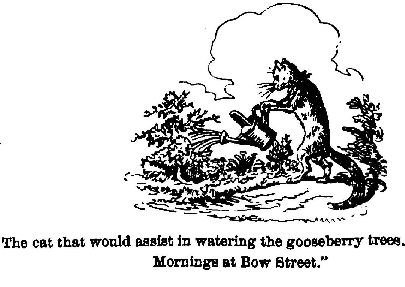
George Cruikshank was an enthusiast in all things to which he gave his mind. He did nothing in a halfhearted way. Whether preparing to address a great Exeter Hall audience on the evils of drunkenness, or marching at the head of his riflemen, or arraying himself in a table-cover to enact the part of Lord Bateman; in small things as in great, he was ever at fever-heat. He would have made a good actor, had he not been incapable of a moment’s repose; he would have been an admirable Temperance advocate, had it been in him to give himself pause in order to think over the heads of his discourse; he would have been a good volunteer officer, had it been possible for him to sit quiet in his saddle. But he seemed to be troubled with an excess of life. Life at fever-heat is the dominant characteristic of all his work. The “quiet spaces” in his etchings are rare.
Having been converted by his own “Bottle” to total abstinence from fermented liquors, he could be nothing less than an earnest and a vehement worker in the cause. He threw himself heart and soul into it; and during the thirty remaining years of his life his zeal never slackened, and he had never made sacrifices enough in it. His impulsive advocacy often took ludicrous forms. He sometimes offended people by his denunciations of even the most moderate drinkers, but he never made an enemy by his gaucherie or his downright phrases imported into quiet circles, because the parity of his motive and the well-known impetuosity of his nature excused him. I can remember, in the first year of his total abstinence, meeting him at a ball given in Fitzroy Square, by Mr. Joshua Mayhew, the father of Horace and the Brothers Mayhew. He danced and was light-hearted with the youngest; but when at supper the wine began to circulate, he stole round to the head of the table, and, laying his hand upon the shoulder of the venerable host (who was a very haughty and quick-tempered old gentleman), said, in a deep, warning voice, “Sir, you are a dangerous man.” Mr. Mayhew had a glass of wine in his hand, and was about to drink a toast to the health of one of his sons, when Cruikshank’s hand fell upon his shoulder. “I look upon every wine-drinker,” Cruikshank added firmly, “as a dangerous man, sir.” The company, knowing the hot temper of their host, expected an explosion of rage; but it was staunched by Horace Mayhew, who burst into a hearty laugh, and told his father to go on, for “it was only dear old George.”
In the same way, when dining at the Mansion House, Cruikshank, at the passing of the loving-cup, would go through an extraordinary pantomime before all the company, expressive of his horror of strong drinks. He would shake his hand angrily at the Lord Mayor, and raise his arms with horror while his neighbour quaffed of the cup. The company humoured the eccentric old gentleman; for, in their hearts, they could not but respect his downright earnestness. He lost no opportunity. Returning home at the head of his volunteer corps, he showed his jaded officers, who had freely taken beer, how fresh he was—on two oranges.
“Ah! you may laugh,” he would say, when his friends bantered him about his aggressive protests in society; “you may laugh, but I can tell you this——the presence of the old jackdaw checked the drinking, if didn’t stop it, and I am very grateful to feel sure of that.” * As Mr. Sala has observed, “the veteran sticks bravely to his text.” And well he might, for his temperance renewed his youth. “He neither smoked tobacco nor drank fermented liquors in his old age; but he was a hearty eater, an early riser, and a vigorous walker and his reward was that which, according to Gray, is only felt by boys at school—a perpetual ‘sunshine of the breast.’” He was fond of showing this vigour renewed by temperance, at every possible opportunity; for he very wisely regarded it as his most forcible argument. It enabled him, in his old age, to capture a burglar on his own premises. The story runs that when he was following the burglar to the station, with the police, he drew him under a lamp, and told him that he could see drink had brought him to this—adding that he himself drank nothing but water. “I wish I’d ha’ known that,” said the ruffian, “I’d ha’ broken your head for you.” Cruikshank delighted to show an audience how he could hold a tumbler full of water steady upon the palm of his outstretched hand. At eighty, he was seen in costume at a fancy dress ball at Willis’s Rooms, joining heartily in the dance, and letting everybody know that it was “water that did it.”
* Grace Stebbing’s article on Cruikshank in the Graphic.
It was very difficult to obtain from him the toleration of tobacco smoke in his company; for, after he had given up alcoholic stimulants, he threw away his pipe. He would say to a man of letters whom he favoured, laying his hand upon his arm, and turning those fierce eyes of his full upon him, “I want you to give up drinking and smoking, and you tell me that if you don’t smoke you can’t write. Now, I’ll meet you half-way. Give up the drink, and you may smoke—-just a little.” But, as a rule, he was as stern in the matter of tobacco as in that of beer or gin. One evening M. Legros, the distinguished French artist, lighted a cigarette in his hall as he was leaving Mornington Place. “To that vice,” said “the inimitable George” in his deepest tone, “I was a slave for many years, but now I am a free man.”
To it also, it must be added, he owed one of his most imaginative and delightful etchings,—“The Triumph, of Cupid,”—published in his “Table Book.”
His earnestness was extravagantly expressed in all things. As a furious anti-Papist, he would draw aside and shake his coat when Sisters of Charity or a Catholic priest passed him. “Do you see that fellow in front?” he suddenly asked a friend with whom he was walking. It was a workman quietly enjoying his pipe. “Do you know what I would do to him if I were a man of fortune? I’d kick him! To think that any man should be fool enough to place a tube between his lips, and go puff, puff, puff!” This was his “counter blast.” And he glared at the workman as he passed on. He had himself been an inveterate smoker for more than forty years!
On another occasion he drew sharply up before the windows of his old wine merchant, and called out, “Give me back my thousand pounds!”
When the Crystal Palace was opened at Sydenham, Cruikshank, in his rage that it had not been made a Temperance palace, drew some extravagant drawings of the opening ceremony for Messrs. Cassell, one of which represented the Archbishop of Canterbury bestowing his blessing upon a public-house.
Dining one day at Grampian Lodge, Forest Sill, with his friend Dr. Rogers, he suddenly began to tell the company that he had had a vision the night before. Then he related it with much gesticulation, and with dramatic effect.
He had seen two devils in council. One had said, “England is moral, prosperous, happy—this will never do. How can we put an end to it? Her crops are splendid; look, for instance, at her barley, her-” The second devil interrupted: “I have an idea. Her barley, which makes such splendid food, let us teach them to soak it, to sour it, to make it ferment; in short, to turn it into a tempting poison.”
“Agreed!” cried the first devil.
“Why,” the second devil continued, “we will actually make them drink it of their own accord; they shall lift the poison to their own lips with their own hands.”
“Ha! ha!” shouted the first devil; “and then of course, there will be murder, robbery, violence, and misery all over the land.”
“The devils have had their way,” the old man added his keen eyes glancing round the table to mark the effect of his vision.
He was indeed, as a writer called him, a “muscular teetotaler.”
“In his time,” a Temperance writer * records to his honour, “he must have attended thousands of temperance meetings, and at these few men were more welcome.
* The Temperance Record, February 7th, 1878.
The style of his advocacy was peculiar, he passed from grave to gay with facility, but he never lost sight of the great object he had in view. He seemed for years, to be deeply impressed at the numerous murders that were taking place, all of them, or nearly so, being in the last instance, if not in the first, attributable to drink. He used to exclaim, with deep fervour, ‘Can nothing be done to stop these dreadful murders?’ The clear remedy of total abstinence from that drink which was their inciting cause then came naturally from his lips; but though individuals responded to his appeal, the general mass of the public remained unmoved. Sometimes he would suggest a deputation to the House of Lords. But though this idea was not acted upon, yet he lived to see that august assembly collect evidence well fitted to be of service to them, and also to the public at large. Mr. Cruikshank’s powers of mimicry were also very great, and often has he convulsed his audience with his inimitable acting; but, at the same time, there was no mistaking his deep earnestness, and the sincerity with which he expressed the convictions of his heart.
He did his utmost, when the teetotalers had failed at the Crystal Palace, to establish a teetotal palace in the old Surrey Zoological Gardens; and he was drawn in state from the Hampstead Road to Walworth, in a carriage and four, to open a bazaar in aid of the scheme. He even prepared a design for the building. But although many went to cheer the honest, earnest old man, few remained to invest, and the design fell to the ground. It may have been some consolation to him and to his Temperance friends to mark, afterwards, the services which the Crystal Palace was destined to render to the cause of Temperance, for a drunkard has hardly ever been seen under its shining roof.
Cruikshank could never convert his mother to his views. She lived with him during the latter years of her life, and died under his roof, in the care of a most reverent and attentive son.. She had always been a careful, sober body, and would not be coerced, because her son could not take his beer or toddy without committing excesses. She had been a handsome woman in her days, a grandson records, and it was picturesque to see the lame old lady, leaning upon her crutch, and wrapped in a plaid,—with her shrivelled features and wild grey hair,—raise her withered arm, and with the old fire declare that she would not surrender her principles. A glass of beer with dinner, and a little toddy at bedtime, she had always taken, and she took them to the end, and George had to submit.
Addressing, on one occasion, a Temperance oration to a Bristol audience, he appealed to his female hearers not to believe that “nourishing stout” was necessary to nursing-mothers; and he pointed to himself as a melancholy example, saying, “My mother first lifted the poisoned chalice to my lips.” His aged mother read this in the morning paper. Her wrath was violent. “What!” she cried, “am I to be told publicly, at eighty years of age, that I, who always begged and prayed him to be sober, taught him to drink?” Her son did not return home for several days; but he heard of his speech in no uncertain tones when he presented himself to the old lady, who had, in his youth, often physically chastised him for his excesses.
Perhaps the best specimen of his manner of laying his subject before an audience is the speech which he delivered at the Grand Demonstration of the National Temperance League, in the Guildhall, on the 19th of November, 1864. It wants his by-play, his dramatic delivery, his grotesque movements, and then the solemn sounds of his voice, to be completely understood; but it is sufficiently original and suggestive as reported:—
“My Lord Mayor, Ladies and Gentlemen,—-My worthy friend the doctor has given you a very excellent discourse upon his own profession. It So happens that as I was coming to this meeting I met with a gentleman who had just been to consult his medical man; and finding I was coming to this meeting, he laughed at all idea of abstaining from intoxicating drinks. He told me he had been to see a very eminent member of the medical profession. I asked him what was the result.
“He said the physician told him he wanted a stimulant and prescribed one. I said, ‘What did you give him:’
“He replied, ‘Of course, I gave him the usual fee—a guinea.’ I said, ‘I can show you how to save that guinea in future. If you will give me half of it. I will give it to some good charity, and the other half you may keep in your pocket.’ He said, ‘How is that?’ I said, ‘Instead of going to the physician, go to the publican, and tell him what is the matter with you, and he will prescribe the same thing; and if the landlord is not in, say the same to the potboy, and he will do as well. Rely upon it, they will prescribe exactly the same thing as the doctor, and the effects will be the same. Now, I must say one word, if you please, to defend a very eminent prince who has been mentioned here to-night. I am sorry to say it happened to be my fate to hold up to ridicule the Prince Regent—very often indeed; but he was not such a bad man as he is represented to be. It must be recollected that if he committed excess in the way of drinking, it was then the fashion for all the eminent persons to get drunk. No man was considered a liberal man—no man was considered a gentleman, in fact, unless he made his companions drunk; and therefore, with all due respect to my friend Mr. Scott, who mentioned the circumstance, it must be recollected that about half a century back it was the fashion—it is a fearful thing, but it was the fashion—of gentry to get drunk; therefore we ought to make allowances. But now, my Lord Mayor, to come to this very serious question. This hall is the place where the great City feasts are held, and the question is, is it possible that there can be any grand entertainment given without mixing up with it the intoxicating cup? What will be said? It is very well for you, my lord, who are almost an abstainer yourself—very well for you—but what will be said of another Lord Mayor who comes here and gives a dinner without wine and beer? What will be said of him? He will be called a shabby fellow; and the question is, whether the guests will not all be melancholy. It will, perhaps, be somewhat in this style: ‘Have a little more soup?’ ‘No, thank you.’ ‘More fish?’ ‘No, thank you.’ ‘Bit of fowl?’ ‘No.’ ‘Venison?’ ‘No.’ ‘What, can’t you eat any more?’ ‘No, I don’t like it: I want something to drink.’ There is the serious thing: what is to be done? There is one way of settling that question. It is supposed that there can be no sociality, no comfort, no enjoyment, without intoxicating drinks. Now, I recommend the next Lord Mayor who may succeed our honoured chairman, if he be in favour of the moderate use of these delightful drinks, to be so good as to ask the present company to come to dinner. Wouldn’t you enjoy yourselves? And then, when we have had enough to eat, and want something to drink, here you are (holding up a glass of water)—Mr. Chairman, your very good health! Ladies and gentlemen, your good health! (drinking the toast.) We should have a jolly time of it. (Loud and long-continued cheering.) Mr. Morley says we will take the sherbet without the punch. That is the way in which these things are looked at; but supposing that it is impossible that any social enjoyment can be had without the use of these stimulants, let us take another view of the question. I have had the honour of dining here, and I have enjoyed myself very much, not only in the time when I used to take wine myself—because I recollect there was such a time as that—but when I have been a teetotaler I have been, here, and enjoyed my dinner very much indeed, without any of these drinks. But supposing we had this hall upon the occasion of the Lord Mayor’s feast with the most elegant people in the world (for I believe of all the people in the world the British people are the best looking and the best dressed): imagine the scene! The tables are set out in the most splendid manner; everything looks grand and happy; but what is going on outside? Ay! my friends, the most splendid monument in the world where this drink is used in moderation as it is in this country, may in the inside be a splendid monument of good order, taste, and sobriety, but at the outside there is filth and dirt and crime through drink. I say, suppose these social meetings cannot be enjoyed without these drinks, let us look at the outside. Now, there are a certain number of circumstances or acts committed in society, which are always injurious, not only to the individual himself, but also to society at large. Now, I do not mean to say that every teetotaler is an honest man. There may be some dishonest fellows amongst them. I have heard of two in the last thirty years. This reminds me, by-the-bye, of a teetotal turnkey at Coldbath Fields. There were two youths brought into the prison, who were teetotalers, and the other turnkeys jeered the teetotal turnkey upon it. He said, ‘It is true that there are two teetotalers here, but they are here only for begging, whereas you have about fifteen hundred brought in who drink, and they are most of them committed for stealing.’ There are a number of besetting sins connected with drinking, such as robberies, brutal assaults, garotting, house-breaking, suicide, and murder. By-the-bye, speaking of murder, there has been a very strong feeling existing for many years, and still increasing, against the punishment of death. I think it is a very horrible thing indeed to hang anybody; but, my friends, do not forget that it is a still more horrible thing for one to be murdered. Do not let us forget that. There was a young man in the country a little while ago hanged for murder—quite a young man. It was a sad thing indeed, no doubt, to see this poor fellow gibbeted; but what was he hanged for? He had been drinking on the Saturday night, and he murdered a young woman as she was going to church on the Sunday morning. Do not forget that these horrible, detestable, damnable crimes are committed under the influence of drink. We will talk about doing away with the punishment of death after we have stopped murders. I had the honour of speaking in the Mansion House when Mr. Charles Pearson, the City solicitor, brought on the question about the convicts; and I told the Lord Mayor then, that if we could do away with intoxicating liquors altogether, we might wheel out that dreadful instrument the gibbet into the Old Bailey, and make a bonfire of it. I believe you will find, if you go into the question, that there is hardly a murder committed in this country out of a hundred—I may say out of a thousand—not ten out of ten thousand—but drink has something to do with it. Remove the drink, and you will stop murder. But there is a gentleman who ought to have been speaking instead of myself, and therefore I will not detain you much longer; but I will say this, my friends, and call your attention to it especially, that the teetotal question has now been before the world for about thirty years, and during that short time I challenge any one to point out any teetotaler who has been committed for a brutal assault upon his wife, or for garotting, or picking pockets, or house robbery, or murder. I challenge the world to produce one single case wherein any real teetotaler has been convicted of one of those crimes. Then, if this be so, what have we to do but to spread this Temperance movement throughout the length and breadth of the land? and then we should stop, if not all crimes, if not all offences, still the great majority of them; and that is what we are aiming at. And recollect this, my friends, that we are not a society formed merely for the purpose of reclaiming the drunkard. It is a very good thing to do so, and I am sorry to say that my time is so occupied that I am almost in despair. I have six most dreadful cases in hand at the present moment There is nobody to assist them. I could not go to the brewer or distiller, and ask them to give me funds for the support of these people whom they have rained; and why not? Because there is blood upon the money. I would not have it. But I had to-day a letter imploring me for help from the nephew of an old friend of my father. What am I to do? I have a lady in the country at this moment, the wife of a barrister, who is starving for want of help, and whose husband has been ruined by drinking. My time is occupied, and my friends are gone, and I am called upon for all I can afford. But, my friends, if you do away with these drinks, you do away with these cases. But it is utterly impossible to go into the evils arising out of these drinks in the time I have to speak—they are so extensive; all I have to say is, ‘Go on and prosper!’ and prosper we shall. I cannot sit down without saying that I look upon this meeting to-night to be one of the grandest movements that this cause has ever had. I say it from my heart, and think that those gentlemen who have assisted in getting up this meeting deserve our best thanks.”
The idea of a temperance Lord Mayor’s Banquet suggests, no doubt, many vastly amusing incidents and episodes to the mind of the comic writer, but honest-hearted George Cruikshank could not, and would not, in his latter dav, see any element of fun in drunkenness, and he was quite in earnest in recommending the next Lord Mayor to fill his loving-cup with pump water. *
* Since Cruikshank delivered the above speech, a Temperance banquet has been held at the Mansion House.
The account he gave, moreover, of his trouble about the many people who were seeking his assistance, was true of his experience year after year. His doors were besieged. He was waylaid by petitioners for his known bounty (the recklessness of which, as we have seen, Dickens reproved) whenever he went abroad. A poor man himself, for ever in money troubles, even to the end of his laborious life, his heart lay always open to a tale of distress. He was never without “cases” on hand.
It has been remarked of his Temperance days, by one of his friendliest critics, that his style suffered from the contraction of his ideas and sympathies, “and it cannot be questioned that with the general public his reputation declined in proportion to the increase of his popularity among the teetotalers.” He lost heavily, in a pecuniary sense, by his Temperance advocacy. Publishers ceased to employ him. He remarked that, for the last ten years of his life, he was without commissions. He had refused none, he would say. He was willing to work, and he held that his powers were unimpaired.
Temperance preacher; to them the inimitable George, the illustrator of Boz, the kindly satirist, the creator of “Points of Humour,” the illustrator of Grimm, was dead.
And, firmly believing this, the brave old man held on in the rigid course of duty he had laid down for himself. He had seen all the horrors which lie behind drunkenness; in his early time he had himself been a tavern hero; and he had dedicated the remainder of his life to the work of warning the rising generation out of the path in which he himself had stumbled.
“I come forth,” he said, in one of his earliest temperance harangues, “to set by my humble example the opinion of this unthinking world at defiance.”
But the public had come to regard him simply as a keen a sense of the ridiculous as most men. I can see clearly what is ridiculous in others. I am so sensitive myself, that I am quite alive to every situation, and would not willingly place myself in a ridiculous one; and, I must confess, that if to be a teetotaler was to be a milksop, if it was to be a namby-pamby fellow, or a man making a fool of himself or of others, then indeed I would not be one—certainly not; but if, on the contrary, to be a teetotaler is to be a man that values himself, and tries by every means in his power to benefit others; if to be a teetotaler is to be a man who tries to save the thoughtless from destruction; if to be a teetotaler is to be a man who does battle with false theories and bad customs, then I am one. I have been a convert but a short time, not much over twelve months. I only wish that I could say, with Dr. Gourley, that I had never taken a glass of spirits in my life; I wish that I had acted upon the principles of total abstinence only thirty years ago; for if I had, I am convinced that at this time I should have been much better, both in body and mind. I have experienced much benefit already, both physically and mentally. I never did sneer at or scorn the question of Temperance, yet I never thought that I should stand up as a teetotal advocate; but I am proud that I have been put into the position in which I am now placed.
Later on, still conscious of the disadvantage at which he was placing himself as an artist, he said to another audience—.
“When I left off drinking wine altogether, and became a total abstainer, I became a healthier and stronger man, more capable of meeting the heavy responsibilities that were upon me, and for the following two years I had my life renewed, and all the elasticity of my schoolboy days came back to me. Domestic afflictions then came upon me, ending in death, and my spirits and health were crushed down. In this extremity I applied to my medical adviser. He said, ‘Medicine is of no use to you; you must drink wine again.’ I refused, and my medical friend called in some others of his profession; he told me they had had a consultation, the result being that all of them agreed it was necessary I should drink wine to restore my sinking constitution. I replied,
“‘Doctor, I’ll take your physic, but not your wine. Let me try everything else first, and only when there is no other chance give me wine, because I feel there is a great principle at stake in this matter.’ I have said, and I believe, wine is unnecessary, even as a medicine, and I do not wish to do a single act which would tend to weaken or destroy the weight and force of that conviction. And here I stand. I have not tasted the vile and destroying enemy, and I am almost restored to health, without having risked the violation of my principles. I call this a triumph; and I stand here as an evidence that wine is totally unnecessary, even as a medicine.”
Much later, we find the preacher an octogenarian—albeit rudely buffeted by the world, and well-nigh forgotten as a living artist—still true to his noble text. “Alcoholic liquors,” he exclaimed to an audience, little more than two years before his death, “were recommended to keep up strength! But what kept up his strength? He had not taken a drop of wine, beer, or any alcoholic drink, for twenty-seven years, and he would be eighty-three next September, if he lived till then. What was it, then, that kept up his strength? Since he had given up drinking beer and smoking, he had had a higher enjoyment of life, because all his nervous system was in proper tone.”
Cuthbert Bede, who knew Cruikshank intimately in his teetotal days, has drawn this graphic picture of the Temperance advocate at home:—
“Though I had interchanged letters with Mr. George Cruikshank for several years, it was not until early in the autumn of 1853 that I made his personal acquaintance. He had asked me to write a serial story for a projected publication to be illustrated by himself ; and, as it would simplify matters if we could talk over the subject together, I went up from the country to London to call upon him. He was then living in Mornington Crescent, near to Regent’s Park. Numerous portraits had made me familiar with his personal appearance, so that I needed not to be told who was the gentleman who so courteously received me downstairs, and then took me upstairs to his comfortable studio, where he introduced me to his wife. Some of our first conversation, indeed, was on the subject of his portrait; for, among the pictures on his walls, I had noticed the original of the portrait by Frank Stone, which was engraved on steel for the Omnibus, and was certainly a far more flattering representation of George Cruikshank than the caricaturist’s sketches of himself. I told him that I considered the best portrait of himself was to be found in his own etching, ‘The Reverie,’ published in his Table- Book, and in every respect a wonderfully fine specimen of his art and genius. I also referred to his own account of ‘My Portrait,’ in the Omnibus, in which, with his own pen and pencil, he portrayed himself, and made comments on a curious description of himself that had been given in a publication called ‘Portraits of Public Characters’; how he was said to be of the medium height, with a forehead of a prominently receding shape, with a handsome pair of whiskers, and hair partaking of a lightish hue; and, moreover, how the ludicrous and extraordinary fancies with which his mind was constantly teeming often imparted a sort of wildness to his look frighten from his presence those unacquainted with him.
“He read these and similar passages to me, and was immensely tickled at their egregious absurdity. In truth, his manner at once impressed me as being peculiarly gentle, and kind, and genial. Instead of assuming any airs of superiority, I found him possessed of all the humble modesty and chivalrous courtesy of the truly great artist and thorough gentleman; and although I was quite young, and he was in his sixty-first year, he treated me as though I had been his equal, if not superior, in ability. We had so much to talk about, and he had so much to show me, that my first interview with George Cruikshank had been prolonged to nearly four hours before I became aware how quickly the time had flown. The time had then arrived for their luncheon, or early dinner; and as both Mr. and Mrs. Cruikshank pressed me to stay, and I had by this time overlapped the hour at which I had made another engagement, I readily and peculiarity to his manner, which would suffice to consented to remain, and we went downstairs to dinner. ‘There will be nothing else than a leg of mutton,’ said Cruikshank. ‘I happen to know that, for I came in with it,’ I replied; ‘for as I knocked at the hall door the butcher’s boy was down in the area, delivering the leg of mutton to the cook.’ Cruikshank seemed to be greatly amused at this, for he laughed heartily, and said to his wife, ‘My dear, Mr. ———— came in with the mutton.’ Something in the occurrence seemed to mightily tickle his fancy, for more than once he repeated the words to his wife, ‘My dear, Mr. ———— came in with the mutton!’ It was while I was eating it that I terribly forgot myself. The day was very sultry; it was five hours since I had breakfasted; we had been busy talking, and I felt thirsty. So, while the parlourmaid was handing something to me. I asked her to give me a glass of beer. She replied, ‘We have no beer, sir.’ ‘Then,’ I said, ‘please to bring me the sherry.’ ‘There is no sherry, sir.’ Whereupon my host interposed, and laughingly explained that he could not allow the introduction of any alcoholic liquor into his house; and that, while I was his guest, I must content myself with drinking water. Then I suddenly remembered that which I ought not to have forgotten, even for a moment, that my host had devoted himself to teetotal, who, six years before, had drawn the eight scenes of ‘The Bottle,’ and had thereby struck a powerful blow at one of the greatest vices of the age.
“I duly apologized for my forgetfulness; and the incident naturally led Cruikshank to dilate on that important theme, in furtherance of which he so steadily devoted his great powers to the very end of his career, with a persistent courage and devoted zeal that won for him the genuine respect and admiration of those even who could not wholly agree with him in details. I was one of those. I could travel with him, very willingly, up to a certain point, after which our paths parted, and we ‘agreed to differ.’ I could accompany him to temperance, but not to total abstinence. During the remainder of the time that we occupied over dinner, we scarce spoke on any other subject than that which gave ism, and that I was sitting at the table of the artist rise to the scenes of ‘The Bottle,’ ‘The Drunkard’s Children,’ ‘The Gin Trap,’ ‘The Gin Juggernaut’—and, at a later period, his large oil-painting, ‘The Worship of Bacchus.’
“Our discussion on the subject was preserved with perfect good humour; so much so, that I ventured to remind him that only a year or so before he had been converted to teetotalism he had caricatured Father Mathew, in an etching for the Comic Almanac for 1844, representing him as an old pump. I reminded my host that these were his sentiments for more than fifty years of his life, and that he had never during that period objected to the moderate use of alcoholic liquors, although he had always vigorously lashed their gross abuse; and I pleaded that I had not lived for half those years that I had named, and that I might be pardoned for my forgetfulness in asking his servant for beer and wine.
“Then he told me how the crying sin of the age had sunk deep down into his heart, especially when he had seen it flourishing, like an upas tree, in all its foul deformity, in those courts and alleys into which he was so often led in search of subjects for his pencil; and how the design for ‘The Bottle’ had gradually grown upon him, and the necessity for practising what he preached, which he found he could do only by cutting himself adrift from all alcoholic drinks. He also explained how his plans to disseminate the scenes of his ‘Drunkard’s Progress,’ in such a form and at such a low price that they should reach those masses for whom he specially designed them, were hampered and well-nigh frustrated, chiefly by the cost of engraving such large drawings on wood; and how the new art of glyphography had come to his assistance, and enabled him to draw the eight designs, and to sell them (with Dr. Charles Mackay’s explanatory poem) for a shilling—which in the year 1847 was an extraordinarily low price for such a production. ‘You will remember,’ he said, ‘how Maclise represented me seated on a beer-barrel, getting my inspiration from pothouse scenes, and pencilling them on the crown of my hat?’ ‘Yes, I remember: it was in the Fraser gallery of portraits.
And you have amply proved to the world since then that you can turn to the best account, and for the public good, the people and incidents that you saw in those places.’ I told him that of ‘The Bottle’ and ‘Drunkard’s Children’ series I preferred the one where the poor girl commits suicide from Waterloo Bridge—the idea of the body falling from a height being so vividly conveyed to the eye, as to impress one with the conviction that we can really see the swift descent of that ‘one more unfortunate.’”
An instance of Cruikshank’s earnestness in the Temperance cause happened in May 1854. He had been invited to preside over a meeting of total abstainers, to be held in Sadler’s Wells Theatre, a place associated in his mind with the glories of his friend Joe Grimaldi, the clown, and the days when he was a frequenter of the clown’s club, “The Crib,” hard by. The great Temperance advocate, J. B. Gough, was to address the audience. Cruikshank introduced him in his own original way, delivering, as the papers remarked, a speech full of piquant and incontrovertible truth. But it was at the close of the orator’s speech that the chairman proved himself equal to the occasion. Seeing that the audience were under the spell of Mr. Gough’s eloquence, he rose and exhorted them at once to come forward and sign the pledge. With this he advanced to the footlights, bridged the orchestra with a few planks, and stood by to receive the ladies who came forward in crowds, many of them leading their children. So delighted was the artist with the number of converts he led to the table to sign the pledge, that he drew the scene for the Illustrated London News, with himself for central figure.
I remember attending another meeting in George Cruikshank’s company. It was a gathering of London pickpockets, called by Mr. Henry Mayhew, when he was engaged upon his London Labour and London Poor inquiry. The solemn, but still somewhat grotesque impressiveness of the Temperance preacher, as he rose, while that dreadful company of keen-eyed vicious lads were eating the plain Temperance supper which had been provided for them, to bid them renounce the evils of their way, and as a beginning, to shun the bottle and the beer-pot, dwelt long in my memory. “Man,” said Lord Lytton, “has no majesty like earnestness.” That night, honest, whole-hearted Cruikshank, as with wild gesticulation he talked to “the dear lads”—for the forlornest and wickedest waif was dear to him—was clothed in majesty; and it cowed a man at hand, who acknowledged, within his hearing, that he had smuggled something stronger than water into the room.
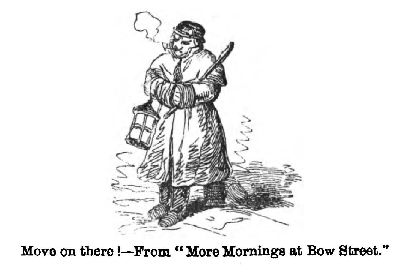
Mr. Wedmore, in his critical sketch of Cruikshank, has described in a few pregnant sentences, how in his later days the public fell away from the great humourist and subtle observer:—
“As time went on apace, neither the passage of time itself, nor the hard work which crowded the days of his maturity in art, nor the comparative neglect of the later years, when Cruikshank, no longer quite in the movement of the day, was solaced by visits in the Hampstead Road, chiefly of a very few who were collectors of his work, or of some stray humourist still faithful and confident in the achievement of so many years ago. As time went on, Cruikshank wore well and slowly, so that it was truly said of him that he looked as if he had once been very old and then had forgotten it. Employed no longer in sketching and satirising the society of which he was hardly any more a part, he betook himself, a good deal by choice, to work more distinctly ambitious than any he had attempted when his hand was really the strongest and his brain the most fertile. He furnished the design for a monument to King Robert the Bruce. He painted in oils, not only this or that moral lesson, but a tale of heroism in humble life. No doubt the absence of the knowledge of academical draughtsmanship told against him not less in 1871 than it would have done half a century before, and no doubt the absence of any capacity for the subtle modulations of colour—nay, the absence even of sensitiveness to these—made his painting in oil a failure when judged by the side even of quite every-day work by every-day artists. Thus it was that no fresh honours came to him when he was still eager for them. The popularity of the great days was a little forgotten by the public in the presence of the failure of the most recent. And then again, advertised poverty is never a helpful thing. We worship merit a little, but success more, and success must have its stamp. The public of Cruikshank narrowed. Of course critics and journalists—the men whose business it is to keep in memory some work that the chance public praises one day and forgets the next—knew that Cruikshank was great, and how he had been great, and having in more than one notable instance said so faithfully during his old age, said so again last month, when he died. And of course, again, so much of his work having become rare, collectors of it had arisen—curious and anxious seekers, to whose interest we shall owe the preservation of many of his early and many even of his riper things. For them, when Cruikshank’s work was pretty well accomplished, and ‘finis’ seemed about to be written to that immense volume of production, Mr. G. W. Reid engaged on a task of care—the great catalogue raisonné in which, with here and there errors not easily avoided, he has chronicled well-nigh five thousand designs: ‘the smiling offspring,’ as Thackeray so admirably said of them, ‘the smiling offspring of painful labour.’ But in the main Cruikshank was forgotten, and the weekly smiles—feint though now and again they needs must be, and of indulgence rather than commendation—which are given by the English public to the efforts of our youngest English humour, a little trivial and slight, had ceased to be bestowed on that larger and more massive humourist who lingered from the past he was part of.”
This is very true, and is a very sad story skilfully told. Think what would have become of the neglected or forgotten humourist, if, when the mere laughing public had turned away from him to Leech and Doyle, and Tenniel and Du Maurier, he had not been fired with the ardour of an apostle in the cause he had taken up. His Almanac had failed for lack of readers; and David Bogue had thrown up Cruikshank’s Magazine, after the second number—convinced that the artist had outlived his public. His ambition to become a painter was mercifully renewed, with the renewal of his health and mind, through temperance. Full of vigour he used to say, “A painter should paint from his shoulder, sir.” He became almost wholly a serious man in his work, and appealed to a public in a new capacity. He resolved, stimulated by the success of “The Bottle,” to execute a great picture that should remain behind him, a monument of his genius, and an immortal Temperance lesson.
In the early ardour of his second youth he had braced himself to supply, so far as he might, albeit he had reached his sixtieth year, the deficiency in his art education, by working as a student at the Royal Academy. He had, he believed, all his powers unimpaired; why then should he not yet obtain the academical knowledge, of which he had been deprived, as he had said bitterly, through the improvident habits of his whisky-drinking father. Mr. Charles Landseer says: “He entered as student at the Royal Academy, during my keepership, April 22nd, 1853; but made very few drawings in the Antique, and never got into the Life. He was placed upon the Turner Fund in 1866—£50 per annum. I have heard that he made an application to Fuseli for admission to the R.A., and was informed that the school was too full, but that he might go and draw there if he could find a place.” *
* Letter from Charles Landseer to B. J., Feb. 18, 1878.
This is the brief record of George Cruikshank’s relations with the Academy. He was past the years when men learn. Time pressed too heavily upon the elderly man to leave him patience for the slow progress from the “Antique” to the “Life.” He had been at the “Life” in his own keen way since he was a boy; and he must be content to paint with the imperfect but original knowledge which had sufficed for his etchings.
And so he turned to his easel, and painted in oils, with something of his own inimitable power of concentration and dramatic story-telling, such subjects as he had treated in earlier days with his etching-needle. His “Tam o’ Shanter,” “Grimaldi the Clown Shaved by a Girl,” “The Runaway Knock,” “The Fairy Ring,” “Titania and Bottom the Weaver,” “Dressing for the Day,” “A New Situation,” and “Disturbing the Congregation,” were exhibited at the Royal Academy or at the British Institution; and were welcomed, for the fancy, the life, the humour that were in them—although they were one and all crude or violent in tone, and betrayed in every part a hand unpractised with the brush, and an eye dead to the delicacies of colour. They were, in truth, such bits of humour or fancy as the master humourist was wont in the old time to throw off at the rate of two or three in a week—only laboriously rendered in oils. The Runaway Knock, for instance, might be a plate in the “Sketch-Book,” or in “Points of Humour”—and the remark applies to Grimaldi being Shaved by a Girl, and the Disturbing the Congregation—which latter, to the artist’s great delight, the Prince Consort, who was one of Cruikshank’s cordial admirers, bought. Some of these fetched high prices. The Fairy Ring, the most imaginative, and as a composition the best of Cruikshank’s oil-paintings, painted in 1855, was a commission given to the artist by Mr. Henry Miller, of Preston—the price being £800. * The fairy revel is full of exquisitely suggestive bits. The canvas swarms with fairy life, and abounds with fanciful episodes.
* It is now in the possession of Captain Douglass Kennedy, of Summerfield, Kirkby-Lonsdale, Mr. Miller’s son-in-law.
The grace and spirit with which the artist could treat fairy or elfin life may be seen in scores of his earlier works. Look at this “Fairy Revenge,” from “Scott’s Demonology,” drawn in 1833.
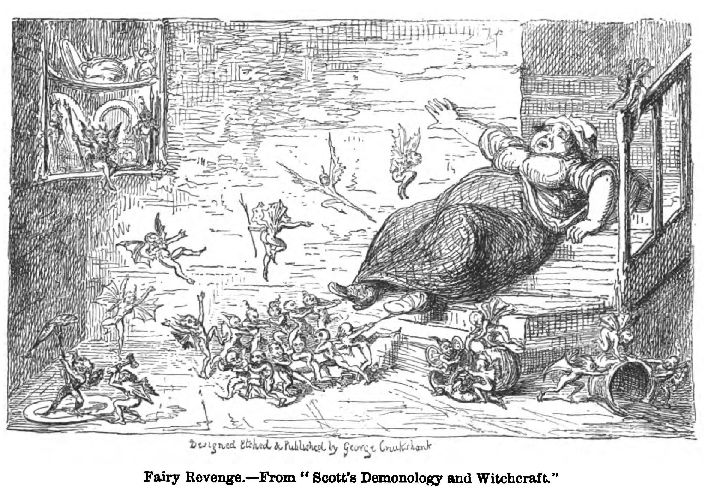
“The Runaway Knock” is, as the reader will perceive, simply such a bit of Cruikshankian humour as he had been wont to treat with his etching-needle. It is full of life and excitement. The entire household, to the pug puppy-dog, has been aroused; nor could the painter refrain from throwing life into the carved stone head over the street-door. Again, “Disturbing the Congregation” is an etching subject, elaborated. A little boy, in church, has dropped his pegtop, and the awful eye of the beadle (Cruikshank created the British beadle as a humorous figure) is upon him. The Prince Consort, whom a genuine bit of humour delighted, was glad to add this most characteristic Cruikshank to his collection.
Cruikshank’s old friend, Clarkson Stanfield, first persuaded him to trust himself to oils. In his tinted designs, he showed that sense of colour which was everywhere manifest in the etchings of his best time—in his designs to Ainsworth, for instance. The watercolour drawings for his Walter Scott plates, again, are admirable. * But in oil, it must be repeated, he failed utterly.
* They were for a long time the property of Mr. Lumley, of Her Majesty’s Theatre, and on the sale of his effects passed, fortunately, into the hands of Mr. Ellison, who bequeathed his collection to the South Kensington Museum.
The touch of the etcher remained. He was hard and crude. The first painting he exhibited was “Bruce attacked by Assassins”—the Bruce upon a burlesque horse smothered in drapery! It was exhibited at the Royal Academy. His next picture was “Moses dressing for the Fair”—a subject more within his power; but it was coarse, inharmonious, and sketchy. The wonder was that Cruikshank could not perceive that he was on the wrong road. So far, however, was he from suspecting this, that he was constantly meditating great historical subjects; and actually “got in” upon a spacious canvas the Battle of Agincourt. He even began a scriptural subject, “Christ riding into Jerusalem.” But the genius that could realize a street or fairy mob * upon a surface no broader than the palm of the hand, could not paint a battle-piece. Without his outline he was all abroad. The sacred subject remained in the studio, with many other canvases, to the end. It was his “Battle of a Gin Court,” in his “Sunday in London” that showed the master. He admitted, when it was suggested to him, that the “etching-point feeling” was always in his fingers, giving a “living” sensation to the brush, and that he never could get rid of it. His Falstaff tormented by the Fairies, was, on the whole, the painting he completed with most thorough satisfaction to himself.
* “Cruikshank’s crowds give one exactly the impression of reality. They show a certain monotony, from the common impulse of the mob, yet they are full of characteristic figures, no two exactly alike. There is also all the due sense of air, and motion, and fluctuation about them. They are penetrable crowds, especially the Irish, which he delights to draw,—true mobiles,—ready to break out into new mischief, or disperse before the onslaught of the Saxon.”—Francis Turner Palgrave.
Mr. Wedmore, dwelling on the shortcomings of biographers, complains that where an artist is the subject they tell “not much of the work he had planned but never executed; work, nevertheless, on which perhaps he had set great store, and looked forward to completing, and ‘purposes unsure.’ ‘That weighed not as his work, yet swelled the man’s amount.’
“You should see the comedies I have not written,” said a pensive playwright. Cruikshank was, throughout his life, disturbed by unfulfilled dreams of great subjects, with which he felt his genius could cope. He would have grappled with Milton, as we have seen, but hard fate kept him tied to bread-and-cheese work, and to minor themes. His “Pilgrim’s Progress” remains unfinished, and, even so far as he executed it, unpublished. *
* The plates are in the possession of Mr. Truman. “Ah! who shall lift that wand of magic power, And the lost clue regain? The unfinished window in Aladdin’s tower, Unfinished must remain.”
It would have gone sadly then, when the publishers could no longer find profit in his work, when the public had turned from his old-fashioned humour and fancy, to the fresher and more peaceful, albeit more circumscribed and less earnest, genius of Leech, had he not been buoyed up and comforted with the self-imposed mission, for which he had buckled on new armour, resolved to die fighting in the good cause. And so while his rival rode prosperously on the fashion of the hour, catching, in the words of Herrick,
“A winning wave, deserving note, In the tempestuous petticoat”—
he ordered a broad canvas to be carried to his modest studio in the Hampstead Road, and sat himself patiently down—his morrow’s bread secured by the sympathetic admiration of a few real friends—to build up that monument of his many-sided genius, his cartoon, composed in the manner of his master Gillray’s “Democracy, or a Sketch of the Life of Bonaparte”—in a series of compartments.
The story of the Triumph of Bacchus is honourable to all parties concerned. On the one hand we find the veteran artist eager to perform an enduring work in support of the Temperance cause; and on the other a knot of friends, also good servants of the cause, anxious to put him in a position to labour in comfort. It has been said the National Temperance League was the means of giving the great painting and engraving to the world; but the truth is, that no temperance association—as an association—took action in the matter. The many earnest men who have this good cause at heart co-operated in several ways in furtherance of the artist’s plans; but these plans were actually directed by a small independent committee, who held on to their task through many troubles and some disagreements, until the plate was completed, and the picture was finally made over to the nation.
When Cruikshank had drawn a rough sketch in oils of his design, he invited a few friends to his house to consult with him as to ways and means. The gentlemen who met as a committee were Sir Francis Crossley, John Stewart—the art critic, Mr. Hugh Owen of the Poor Law Board, Mr. John Taylor, and Mr. W. Tweedie, the publisher. The result of their consultation was the adoption of a proposal submitted by Mr. Stewart, who was a fervent admirer and devoted friend of the artist.
George Cruikshank undertook to produce his complete design in water-colours, from which a steel etching was to be executed. The artist assumed the entire pecuniary responsibility of the undertaking, on the condition that his friends would supply him with what he called “spending money,” or money for his daily wants, while the engraving was in progress. The advances of his supporters were to be refunded out of the proceeds of the sale of the plate. On this arrangement Cruikshank went to work with his usual vigour. The water-colour design was soon completed, and placed in the hands of Mr. Mottram, the engraver—the understanding being that the outline of every figure was to be etched by Cruikshank himself. This laborious work he finally performed, but not before serious and harmful delays had occurred.
It had been distinctly understood that the great oil painting—the ultimate form which the design was to take—was not to be begun until the engraving had been completed; but Cruikshank’s impatience to be at his magnum opus led him to break through his agreement. A member of the committee, on calling at his house one morning, found him before the broad canvas, with the upper row of figures already sketched in. In reply to remonstrances, he gave the reasonable explanation that no man could etch all day long. The committee then agreed that he should work as fast as was prudent at the engraving, and “for rest” take a turn at the big picture. In order further to encourage him, an honorary committee of about seventy gentlemen was formed, to promote the subscription to the engraving. But so engrossed did Cruikshank become in his oil-painting, that, although he knew that the delay in the print was destroying the chances of a great subscription list, he never touched an etching tool until the painting was finally lifted from the easel.
This work was to bring him, not only glory, but fortune. He was confident that crowds would flock to see it He had visions of policemen at the door of his gallery to keep off the tumultuous throng. The advances of his friendly committee exceeded a thousand pounds; but in a few weeks, he believed, the public, for whom he had been labouring since the beginning of the century, would fill his coffers, and he would be able to release himself from his obligations. Flushed with hope, he wreathed some choice specimens of his early work about the magnum opus, in a little gallery next to the Lyceum Theatre, in Wellington Street, Strand; and threw open the doors, and summoned the world to enter. But the world passed his door. *
* It was a bitter pecuniary disappointment also. Cruikshank believed that he would have excelled as an actor, but his power amounted to nothing more than the realization of a burlesque brigand. He was violent, fierce in ridiculous excess, and extravagant in all his movements. He had always a yearning for the stage, and thought, as we have seen, of adopting it as a profession in his youth. He played with the Charles Dickens troupe in 1848 (Oliver Cob in “Every Man in his Humour,” Doctor Camphor in “Love and Physic,” and Pistol in “The Merry Wives of Windsor”), but he could not compare with such accomplished amateurs as Dickens and Mark Lemon. He never lost faith, however, in his power; and even late in life when he contemplated—to compensate for his pecuniary disappointment with his Triumph of Bacchus—a benefit at Drury Lane Theatre, he proposed to play Macbeth himself, saying to a friend, “I will show them how the dagger-scene should be done.’”
On the 28th of April, 1863, he carried his painting, by command, to Windsor Castle, for the inspection of the Queen; and he never tired of talking gratefully and excitedly about the interview, acting with great solemnity the sweeping bow he made to Her Majesty. But the Queen’s kindness failed to draw her subjects in the crowds the artist had expected. Then his trusty friends organised a little soirée in the exhibition room on the 28th of August, and invited him to deliver a lecture on his picture, which he did in his own original manner, giving a reason for every group, almost every figure, upon his crowded canvas. * Still the laggard public disappointed the expectant veteran, who had cherished visions of a peaceful close for his life, won by this extraordinary labour. Kind Thackeray came, with his grave face, and looked through the little gallery, and went off to write one of his charming essays, which appeared in the Times (May 15,1863). He said:—
* See Appendix I.
“In a quiet little room in Exeter Hall a veteran lecturer is holding forth all day upon a subject which moves his heart very strongly. His text, on which he has preached before in many places, is still ‘The Bottle.’ He divides his sermon into many hundreds of heads, and preaches with the most prodigious emphasis and grotesque variety. He is for no half measures. He will have no compromise with the odious god Bacchus; the wicked idol is smashed like Bel and Dagon. He will empty into the gutter all Master Bacchus’s pipes, his barrels, quarter-casks, demijohns, gallons, quarts, pints, gills, down to your very smallest liqueur glasses of spirits or wine. He will show you how the church, the bar, the army, the universities, the genteel world, the country gentleman in his polite circle, the humble artisan in his, the rustic ploughman in the fields, the misguided washerwoman over her suds and tubs—how all ranks and conditions of men are deteriorated and corrupted by the use of that abominable strong liquor: he will have patience with it no longer. For upwards of half a century, he says, he has employed pencil and pen against the vice of drunkenness, and in the vain attempt to shut up drinking shops and to establish moderate drinking as a universal rule; but for seventeen years he has discovered that teetotalism, or the total abstaining from all intoxicating liquors, was the only real remedy for the entire abolition of intemperance. His thoughts working in this direction, one day this subject of ‘the Worship of Bacchus’ flashed across his mind, and hence the origin of a work of art measuring 13 ft. 4 in. by 7 ft. 8 in., which has occupied the author no less than a year and a half.
“This sermon has the advantage over others, that you can take a chapter at a time, as it were, and return and resume the good homilist’s discourse at your leisure. What is your calling in life? In some part of this vast tableau you will find it is de te fabula. In this compartment the soldiers are drinking and fighting; in the next the parsons are drinking ‘Healths to the young Christian.’ Here are the publicans, filthily intoxicated with their own horrible liquors; yonder is a masquerade supper, ‘where drunken masquerade fiends drag down columbines to drunkenness and ruin.’ Near them are ‘the public singers chanting forth the praises of the “God of Wine.”’ ‘Is it not marvellous to think,’ says Mr. Cruikshank in a little pamphlet, containing a speech by him which is quite as original as the picture on which it comments,—‘Is it not marvellous what highly talented poetry and what harmonious musical compositions have been produced, from time to time, in praise of this imaginative, slippery, deceitful, dangerous myth?’
“‘This myth,’ the spectator may follow all through this most wonderful and labyrinthine picture. In the nursery the doctor is handing a pot of beer to mamma; the nurse is drinking beer; the little boy is crying for beer; and the papa is drawing a cork, so that ‘he and the doctor may have a drop.’ Here you have a group of women, victims of intemperance, ‘tearing, biting, and mutilating one another.’ Yonder are two of the police carrying away a drunken policeman. Does not the mind reel and stagger at the idea of this cumulated horror? And what is the wine which yonder clergyman holds in his hand but the same kind of stuff which has made the mother in the christening scene above ‘so tipsy that she has let her child fall out of her lap, while her idiotic husband points to his helpless wife, and exclaims, “Ha, ha; she’s dr-unk’”?”
And then Thackeray appealed to the public to come and be grateful to the painter:—
“With what vigour, courage, good-humour, honesty, cheerfulness, have this busy hand and needle plied for more than fifty years! From 1799, * when about eight or nine years of age,’ until yesterday, the artist has; never taken rest. When you would think he might desire quiet, behold he starts up lively as ever, and arms himself to do battle with the demon drunkenness. With voice and paint-brush, with steel-plate and wood-block, he assails ‘that deceitful, slippery, dangerous myth!’ To wage war against some wrong has been his chief calling; and in lighter moments to waken laughter, wonder, or sympathy. To elderly lovers of fun, who can remember this century in its teens and its twenties, the benefactions of this great humourist are as pleasant and well remembered as papa’s or uncle’s ‘tips’ when they came to see the boys at school. The sovereign then administered bought delights not to be purchased by sovereigns of later coinage, tarts of incomparable sweetness which are never to be equalled in these times, sausages whose savour is still fragrant in the memory, books containing beautiful prints (sometimes ravishingly coloured) signed with the magic initials of the incomparable ‘G. Ck.’ No doubt the young people of the present day have younger artists to charm them; and many hundred thousand boys and girls are admiring Mr. Leech, and will be grateful to him forty years hence, when their heads are grey. These will not care for the Cruikshank drawings and etchings as men do whose boyhood was delighted by them; but the moderns can study the manners of the early century in the Cruikshank etchings, as of the French Revolution period in Gillray, Woodward, Bunbury.”
Still the public, the paying public, held back.
Mr. Francis Turner Palgrave took up the Exhibition in the Saturday Review, and thought it necessary to reintroduce Cruikshank to the British public: “Old George Cruikshank has been old George Cruikshank,” he said, “any time during the last thirty years to those whose nursery days date so far back. Indeed, we have heard his illustrations to Grimm’s Fairy Stories spoken of as the delight of their youth by some whose childhood dates forty years ago, whilst the similar labour of love which he has devoted to Jack and the Beanstalk is the thumbed and tattered darling of many who do not yet aspire to rank in the rising generation. He must, in fact, be old George Cruikshank, we are afraid, in the number of his years; yet our century has seen no better example of that ever-youthfulness which is one of the most frequent and least doubtful signs of genuine genius. That the name of Cruikshank deserves to be coupled with this epithet has never been dubious to those who, looking beyond certain mannerisms and limitations in his power as an artist, can appreciate high gifts to move both tears and laughter, exhibited on however small and unpretending a scale; or who can value downright originality, expressing itself in its own manner, irrespective of popular fashion; or who are aware what peculiar skill he has reached as an etcher.”
But the opus Georgii had been scattered through modest ways, in children’s books, title-pages to forgotten music, ephemeral pamphlets, mediocre works, or romances of passing popularity, as well as in the pages of Fielding, Smollett, Grimm, Scott, and Dickens. Nearly thirty years had passed over his head since he illustrated “Oliver Twist”; and so the crowd passed by his sterling excellence, and, in the old fashion, turned “to some loud trumpet-blowing hero of the hour.”
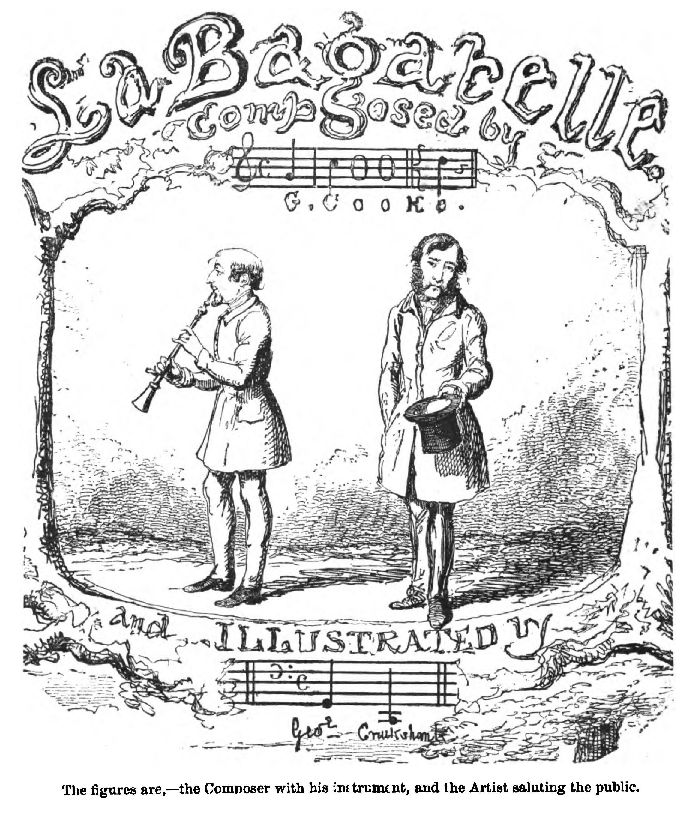
I remember seeing him standing in his exhibition room. It was empty. There was a wild, anxious look in his face, when he greeted me. While we talked, he glanced once or twice at the door, when he heard any sound in that direction. Were they coming at last, the tardy, laggard public for whom he had been bravely toiling so many years? Here was his last mighty labour against the wall, and all the world had been told that it was there. His trusty friend Thackeray had hailed it in the Times. A great committee of creditable men had combined to usher it with pomp into the world. All who loved and honoured and admired him had spoken words of encouragement. Yet it was near noon, and only a solitary visitor had wandered into the room. Thackeray might well say, “How little do we think of the extraordinary powers of this man, and how ungrateful we are to him!”
I was reminded of a visit I had paid years before to a room in the Egyptian Hall, where Haydon, wild and lowering, lingered by his pictures, a solitary, almost heart-broken man. In a letter he said that Douglas Jerrold was one of the two or three who answered his summons to Piccadilly. But it was I, then a young art-student, who had begged my father’s ticket, and stood for him, in the empty Haydon gallery. It was thus, with a sinking at the heart, that I went away from Wellington Street.
In order to make the exhibition more attractive, Mr. John Taylor suggested to Cruikshank that he should group around him a complete collection of his art work of sixty years; his original water-colour sketches of the Miser’s Daughter, the Tower of London, the Irish Rebellion, and indeed a selection from the rich store he had garnered in his home, in the hope that he should be able to leave a complete record of his long art-life as a legacy to his country.
This was the origin of the collection which was ultimately bought by the Aquarium Company, and is now, unfortunately, huddled in a corner of a gallery of their building.
From Wellington Street the Cruikshank exhibition was transported late in 1863 to Exeter Hall. All who knew the worth of Cruikshank’s genius went, and were delighted; but Cruikshank was made to see that the new generation had turned irrevocably to other and less gifted favourites, and that he had outlived his popularly with the multitude. * As one of the committee remarks, “The public neither spake nor moved.”
* “The Triumph of Bacchus” was taken afterwards through the provinces; and although the provincials in many places gave it a heartier welcome than it had obtained in London, the upshot of the speculation was that the expenses of exhibition were barely covered.
And yet Cruikshank, although burdened with the pecuniary liability which he had incurred, and which had continuously increased while the exhibition was in progress, set himself down with heroic fortitude to complete the etching. “Following the big picture painfully, wearily,” one of the committee writes, “the etching was at last completed; but the long delay had damped the ardour of subscribers. The engraving is a noble work, unique as a steel etching in its great size and multiplicity of figures. Each one is complete; nothing is scamped. Its power as a teacher has yet to be fully felt.”
Yet etching and picture brought only heart-aches to the artist. Both were got through under the pressure of grave money complications. Now the water-colour drawing had to be made over to Mr. Samuel Gurney, as an equivalent for the £400 which he had contributed towards the “spending money” fund; now the collection was pledged to another friend; now the artist found himself deeper in the books of Mr. W. Tweedie, his publisher; and now the plate and engravings were made over to the “spending money” committee, to recoup them for their advances. There were bickerings—nay, there were absolute quarrels, in the course of these entanglements; for Cruikshank was an unmanageable business man, and prone, as we have seen, to fall out even with his most devoted friends. Still there was so much that was good and lovable in him, that they bore with his foibles and his outbursts, and remained willing to help the brave old man again. His admirer, Mr. Raskin, and his secretary or representative, Mr. Howell, with others, got up a testimonial which cast something approaching a thousand pounds into Cruikshank’s lap, and at the same time they offered him five guineas apiece for such little thumb-nail water-colour drawings of fairies as he could throw off at least by the half-dozen in the week. But Cruikshank was fevered with mighty ideas, harassed by complicated monetary transactions, and at the same time elated by dreams of a great national transaction which was to put him clear of the world, and at ease in a serene light of steady popularity. An art union of his works was talked about; but it fell through. But no good end could be served by a minute account of the projects and counterprojects which arose around the “Triumph of Bacchus.”
The painting and the etching consumed nearly three busy years of the artist’s life; and his pecuniary reward was exactly £2,053 7s. 6d. as Mr. Tweedie’s ledger shows.
Of the art merits of this great cartoon the critics have pronounced many clashing opinions. “I think, on the whole,” Mr. Sala says, “looking at the amount of sheer labour in the picture, the well-nigh incredible multiplicity of figures, and the extreme care with which the minutest details have been delineated by a hand following the eye of a man past threescore years and ten, the ‘Triumph of Bacchus’ must be regarded as a phenomenon. Its pictorial merit is slight; but it possesses and commands interest of a very different nature from that excited by a mere picture, when we remember the painter’s purpose, and the tremendous moral lesson he sought to teach. It is an eloquent protest against the drinking customs of society, and a no less eloquent—and terribly ghastly—exposition of the evils wrought on that same society by the vice of drunkenness.”
If for no other reason than to do honour to George Cruikshank, it is well that this monument of work by an earnest old man has found its way to South Kensington, having been presented to the nation by a committee of subscribers, one of whom contributed a cheque for £800. Here, according to many Temperance authorities, it has ir made converts. A member of the Cruikshank committee writes: “An actor one day stood before the painting at South Kensington, gazing at it, and taking in its sad history, till, bursting into tears, he left the museum, took a cab direct for Mr. Cruikshank’s house, and signed the pledge for three years. Dr. Richardson told the other day of a clergyman who was pulled up by the vestry scene. Though the public did not patronise the exhibition, yet the warmest commendations of the picture have come from non-abstainers, and for this cause I suspect that the argument of the picture was to them a new idea never before fully considered.”
Mr. John Stewart’s estimate of his friend’s work is technically the most satisfactory verdict which has been written. “As a whole the ‘Bacchus’ is easily described, although ‘none but itself can be its parallel.’ It is the province of genius to make rules where there are none, but as truth is a consistent whole, true genius bends the rule it makes into harmony with those already in existence; and in nothing has the artist been more successful than in combining his novel creation with the recognised canons of art. This was a daring effort; and, however hyper-criticism might carp or ignorance may sneer at details, nothing but the feeling of a poet, which enables him to compose with a poet’s facility, could have sustained the effort so successfully. The general composition contains all the elemental types of pictorial grouping, generalised on the two axioms of balance and variety. So fully has the artist carried out this subtle truth of art—because an essential truth of nature—that it would not be difficult to point out every principle Haydon could extract from the combined works of Raphael successfully modified by Cruikshank to build up and support this picture. The horizontal is represented by the groups in the immediate foreground; the pyramidal by the Bacchus, Silenus, and Bacchante; the circular by the publicans, and repeated by the widows and orphan children; the perpendicular by the saloons of high life introduced on either side: and these are repeated out and still out, till the art which produced them is lost in the higher art necessary to hide the method of production.
“What is true of the picture as a whole is still more visible in the individual groups. These, however, must be seen to be appreciated, for they cannot be described in words, not even by George Cruikshank. But this may be affirmed without hesitation, that no other artist in Britain or in Europe could have produced the same variety of incident, action, and expression—that is, the same amount and quality of thought, in the same period of time—as Cruikshank has displayed in this ‘Triumph of Bacchus.’ The number that could have done it at all is easily counted, and they—artists like Frith—knowing most fully the difficulties, are most enthusiastic in their admiration of the genius and devotion by which Cruikshank has worked and conquered. True, the work wants finish, but this want is most felt by those ignorant enough to confound smoothness and prettiness with finish; but a lifetime would be too short to finish such pictures up to their standard, and they should understand that the artist never intended to finish after their fashion. His objects were entirely different: first, to produce his thoughts in a style that could be seen by an audience at a distance; and second, using the work in oil as a basis and a guide for the etching and engraving the more permanent work which is now in preparation. In the first the success is greater than the greatest smoothness could have given, and it would be as reasonable to blame Rembrandt for not finishing those studies in oil he painted to etch from, as to blame Cruikshank for following Rembrandt’s example. With this ‘Triumph of Bacchus,’ as with Yan Ryan’s ‘Hundred Guilders,’ the etching—the print—is the true completion of the work; while the picture is only a portion of the preparatory means to the nobler and more enduring end and aim. It is different with artists whose works, if engraved, must be translated from paintings into prints by others—often by those with little sympathy for the subject or the style in which it has been treated by the painter. Such pictures, however highly finished, lose much that is valuable in process of translation. With etchers like Rembrandt or Cruikshank, however diverse their styles, they have this in common, that their prints are more perfect than the pictures from which they are produced, because the artist is perfecting his idea while elaborating his plate. The shrewd old Dutch burgomasters, alive to this fact, secured Rembrandt’s most matured works by subscribing for impressions of his plates, and the wisest admirers of Cruikshank’s genius are following the same course, not doubting that his finished etching of this great work will be the most finished embodiment of his grand idea.”
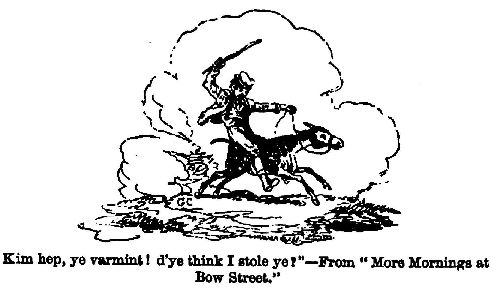
The works which George Cruikshank illustrated, and the enterprises on which he entered during the thirty-years of his teetotal career, would be enough to fill the life of an ordinary worker. After he had contributed “The Bottle” and “The Drunkard’s Children” to the Temperance cause, he engaged with renewed ardour, if with failing fortunes, in his old work of book illustration. For the Brothers Mayhew he illustrated “The Greatest Plague in Life,” “Whom to Marry and How to get Married,” “The Magic of Kindness,” and “The Adventures of Mr. and Mrs. Sandboys during ‘the World’s Show’ of 1851.” In the first two are some etchings full of the old spirit and the old quickness of observation. In the “Magic of Kindness” are some charming fairy scenes, notably the “Genius of Industry And “Whole Hogs.”
“Turning the Forest into a Fleet,” and in the “Adventures of the Sandboys” is Cruikshank’s famous plate of all the world going to Hyde Park—a new rendering of his pictorial preface to the Omnibus. In this we find that the hand had lost none of its cunning, and that the fancy and the power of observation were undimmed.
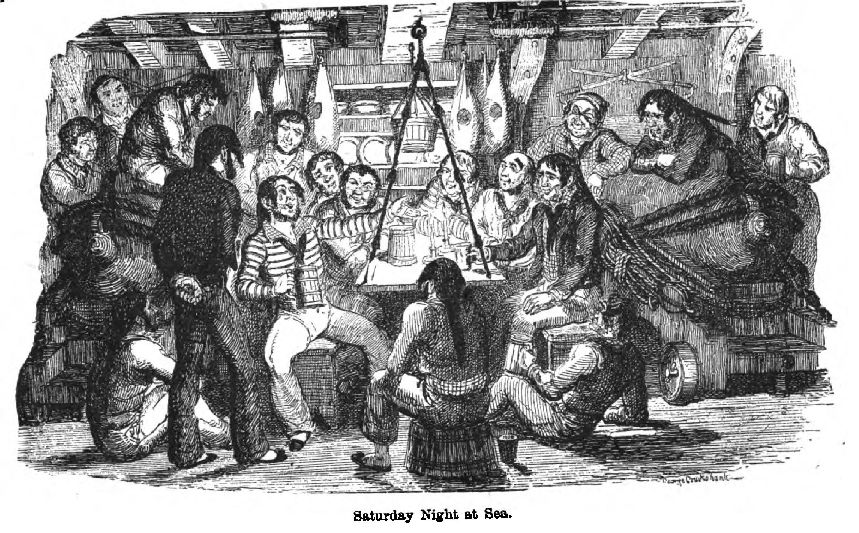
About this time—that is, between 1849 and 1853—Cruikshank illustrated two Christmas stories by Mrs. G-ore, “The Snowstorm” and “The Inundation,” in Angus B. Beach’s “Clement Lorimer,” * the “Songs of the late Charles Dibdin,” Frank Smedley’s “Frank Fairleigh,” and “Uncle Tom’s Cabin”—representing some seventy etchings, and as many wood blocks. The “Frank Fairleigh” etchings introduced Cruikshank to Frank Smedley, and led to a final venture in the magazine form, with which David Bogue, the publisher, had resolved to test finally the hold the artist still had on the public.
* Mr. Wedmore, in his article on Cruikshank, says of one of the etchings in this book, “Miss Eske carried away during her Trance,” that it is among the things that show him to have had “the imagination of tragedy.”
Bogue had long been Cruikshank’s fast friend and admirer, and was loth to believe that his name had ceased to be an attraction to the British public upon a title-page. Moreover, he had had some recent successes with the “inimitable” George. In two years the “Sandboys,” in which was his amazingly minute “All the World going to see the Exhibition” and his drawing of the transept, packed with myriads of people at the opening ceremony (I remember standing by him while he sketched it from the south-western gallery), had gone through four editions. But his recent Fairy Library had been a failure. Dickens (in Household Words), among others, had protested against teetotalism being introduced into fairyland; and had, two years previously, even ridiculed what was called Cruikshank’s temperance fanaticism, in a paper called “Whole Hogs.” These attacks, no doubt, helped to put an end to the George Cruikshank’s Fairy Library, after he had illustrated with some exquisitely dainty scenes, “Pass in Boots,” “Hop o’ my Thumb,” u Jack and the Beanstalk,” and “Cinderella.” * Cuthbert Bede, in a “Reminiscence of Cruikshank” in Notes and Queries, remarks: “It was very evident from that article, ‘Frauds on the Fairies,’ and also from a previous one from the same pen, called ‘Whole Hogs,’ that Dickens considered Cruikshank to be occasionally given over to the culture of crotchets, and to the furious riding of favourite hobbies. But in all these things it is indisputable that the great moral artist was firmly persuaded that he was acting in the cause of suffering humanity, and engaged upon some work for the amelioration of his fellow-creatures. And whatever was the act, and however small and trivial it might appear in the sight of the majority, Cruikshank threw himself into it heart and soul, and, like everything else he put his hand to, he did it with all his might.”
* These have been since published in a volume by Bell and Daldy, and by Routledge and Co.
To be driven from fairyland, which was the realm of his happiest dreams, was a bitter disappointment, and he felt deeply the blow of the friend who drove him forth from it.
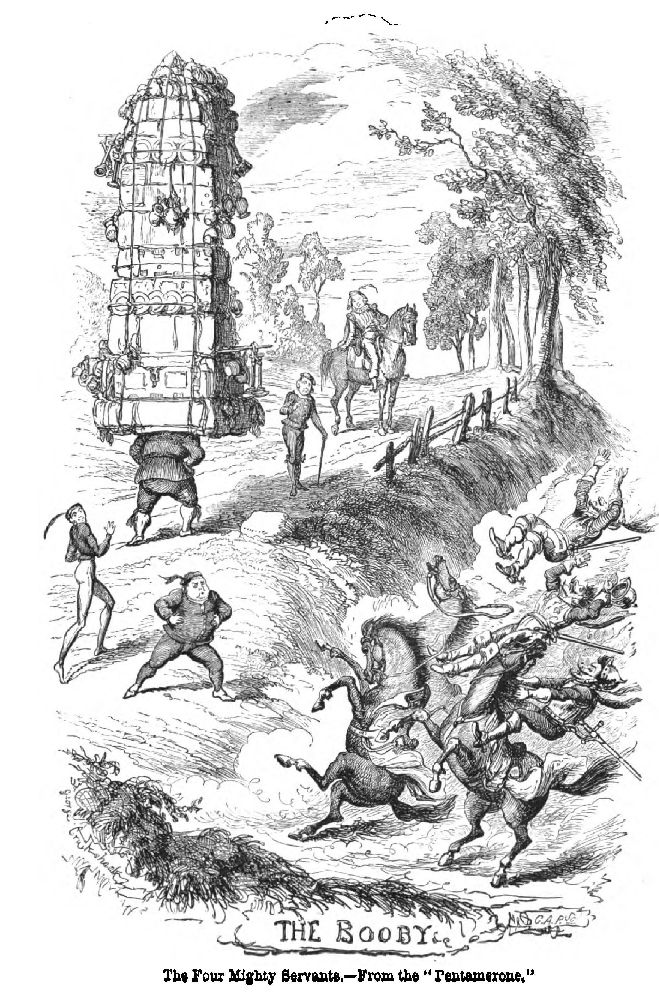
Dickens had said of him and his fairies,—
“He is the only designer fairyland has had. Callot’s imps, for all their strangeness, are only of the earth, earthy. Fuseli’s fairies belong to the infernal regions; they are monstrous, lurid, and hideously melancholy. Mr. Cruikshank alone has a true insight into the ‘little people.’ They are something like men and women, and yet not flesh and blood; they are laughing and mischievous, but why we know not. Mr. Cruikshank, however, has had some dream or the other, or else a natural mysterious instinct, or else some preternatural fairy revelation, which has made him acquainted with the looks and ways of the fantastical subjects of Oberon and Titania.”
When this wizard of the etching-needle, some fifteen years after he had drawn “the awful Jew,” pretended to put forth a whole Fairy Library of his own, the author of the Jew sat himself down and wrote:—
“We have lately observed, with pain, the intrusion of a ‘Whole Hog’ of unwieldy dimensions into the fairy flower-garden. The rooting of the animal among the roses would in itself have awakened in us nothing but indignation; our pain arises from his being violently driven in by a man of genius, our own beloved friend, Mr. George Cruikshank. That incomparable artist is, of all men, the last who should lay his exquisite hand on fairy text. In his own art he understands it so perfectly, and illustrates it so beautifully, so humorously, so wisely, that he should never lay down his etching-needle to ‘edit’ the Ogre, to whom with that little instrument he can render such extraordinary justice. But, to ‘editing’ Ogres, and Hop-o’-my-Thumbs, and their families, our dear moralist has in a rash moment taken, as a means of propagating the doctrines of Total Abstinence, Prohibition of the Sale of Spirituous Liquors, Free Trade, and Popular Education. For the introduction of these topics, he has altered the text of a fairy story; and against his right to do any such thing we protest with all our might and main. Of his likewise altering it to advertise that excellent series of plates, ‘The Bottle,’ we say nothing more than that we foresee a new and improved edition of ‘Goody Two Shoes,’ edited by E. Moses and Son; of the ‘Dervish’ with the box of ointment, edited by Professor Holloway; and of ‘Jack and the Beanstalk,’ edited by Mary Wedlake, the popular authoress of ‘Do you Bruise your Oats yet?’” Dickens goes on to point out what would become of our great books if this kind of liberty were to be tolerated. “Imagine a total abstinence edition of ‘Robinson Crusoe,’ with the rum left out. Imagine a peace edition, with the gunpowder left out, and the rum left in. Imagine a vegetarian edition, with the goat’s flesh left out. Imagine a Kentucky edition, to introduce a flogging of that ‘tarnal old nigger Friday, twice a week. Imagine an Aborigines Protection Society edition, to deny the cannibalism and make Robinson embrace the amiable savages whenever they landed. Robinson Crusoe would be edited out of his island in a hundred years, and the island would be swallowed up in the editorial ocean.” Then follows a most humorous story of “Cinderella,” edited by a stump orator on Temperance, Ocean Penny Postage:
“Frauds on the Fairies once permitted, we see little reason why they may not come to this, and great reason why they may. The Vicar of Wakefield was wisest when he was tired of being always wise. The world is too much with us, early and late. Leave this precious old world, escape from it alone.”
Poor George Cruikshank dropped his pencil, and Cuthbert Bede has told us how he found the artist, on an October day in 1853, still smarting from the effects of Dickens’s article. Cruikshank, however, was not the man to feel a blow and sit down under it.
Bogue had resolved, as I have already stated, to test finally the extent of Cruikshank’s remaining popularity with a magazine that was to bear his name, and that was to be edited by Mr. Frank Smedley, then a popular writer of fiction. Cruikshank had no sooner an organ of his own, than he buckled on his armour, and prepared for a lively assault upon the author of the two House-hold Words articles, In the second (and last) number of George Cruikshank’s magazine * (to which I have already referred) is a letter from Hop-o’-my-Thumb to Charles Dickens, Esq., upon “Frauds on the Fairies,” “Whole Hogs,” etc. It is in Cruikshank’s homely style, but the reader will see that it is not without several good home-thrusts. He begins:—
“Right trusty, well-beloved, much-read, and admired Sir,—My attention has lately been called to an article in Household Words, entitled ‘Frauds on the Fairies,’ in which I fancy I recognise your master hand as the author—and in which article, as it appears to me, you have gone a leetle out of your way to find fault with our mutual friend George Cruikshank, for the way in which he has edited ‘Hop-o’-my-Thumb and the Seven League Boots.’ You may, perhaps, be surprised at receiving a letter from so small an individual as myself; but, independently of the deep debt of gratitude which I feel that I owe to that gentleman, for the way in which he has edited my history, my anxiety to maintain the honour and credit of the noble family to which I belong impels me to take up my pen (made from the quill of a humming-bird), to endeavour to justify the course adopted by my editor, and also to take the liberty of setting you right upon one or two points in which you are entirely mistaken.
“These may seem bold words, from such a mite as I am, to such a literary giant as you are; but I have had to deal with giants in my time, and I am not afraid of them, and I shall therefore take leave to tell you, that although you may have held in your memory some of the remarkable facts in my interesting history, yet that you were ignorant of the general character of the whole; and the only way in which I can account for a man of your remarkable acuteness having made such a great mistake is, that you have suffered that extraordinary seven-league boot imagination of yours to run away with you into your own Fairy Land,—and thus have given your own colours to this history; and, consequently, a credit and a character to the old editions which do not belong to them.”
Cruikshank then quotes passages from Dickens’s article, and continues: “Now this, which you call ‘Frauds on the Fairies,’ in my humble opinion, might as well have been called ‘Much Ado about Nothing’; for, had my editor been altering the title of any standard literary work, the writing of any man of mark—one of your own glorious books, for example—then, indeed, you might have raised a hue and cry; but to insist upon preserving the entire integrity of a fairy tale, which had been and is constantly altering in the recitals, and in the printing of various editions of various countries, and even counties, appears to my little mind like shearing one of your own ‘whole hogs,’ where there is ‘great cry and little wool.’”
Then Cruikshank asks where is tenderness and mercy in Tom Thumb’s father, when he induced his wife to take their seven children into the forest to perish miserably of hunger, or to be devoured by wild beasts? “My editor,” Hop-o’-my-Thumb proceeds, “seeing that such a statement was not only disgusting, but against nature, and consequently unfit for the pure and parentloving minds of children, felt certain that any father acting in such a manner must either be mad or under the influence of intoxicating liquor, which is much the same thing, and therefore, wishing to avoid any allusion to such an awful affliction as insanity, has accounted for my father’s unnatural conduct by attributing to it that cause which marks its progress, daily and hourly, by acts of unnatural brutality.” Farther on, Hop-o’-my-Thumb, referring to the little peculiarity of the young ogres “biting little children on purpose to suck their blood,” wants to know whether they are good things to be nourished in a child’s heart. “And I should also like to know,” he adds, “what there is so enchanting and captivating to ‘young fancies’ in this description of a father (ogre though he be) cutting the throats of his own seven children? Is this the sort of stuff that helps to ‘keep us ever young,’ or give us that innocent delight which we may share with children?” Having thanked Mr. Cruikshank for rescuing his family character from the moral taints which former biographers had put upon it, representing him to be, in the transaction of the seven-league boots and the mother of the slaughtered children, “an unfeeling, artful liar, and a thief,” and his parents “receivers of stolen goods,” he turns upon Mr. Dickens for his attempt to throw ridicule upon the Temperance question, and also his “evident contempt, and even hatred, against that cause,” as shown in his “Whole Hogs.” Hop-o’my-Thumb hereupon valiantly and defiantly remarks: “This is not the place, nor is it my purpose, now to discuss the Temperance question, but I take the liberty of telling you that it is a question which you evidently do not understand, for if you did, your good heart and sanguine disposition would make you, if possible, a more enthusiastic advocate than my editor.”
About the good intentions of both artist and critic there cannot be any doubt in any honest mind, Cruikshank had his parting thrust at his assailant; he could not help that:—
“You are generally,” he says to his friend Dickens, “most happy in your titles; but, in this instance, the application seems singularly inappropriate. The ‘whole hog’ should, by rights, belong to those parties who patronise pork butchers; and the term as applied to the peace people would be better used in regard to the Great Bear, or any other war party; and surely, as to any allusion to the ‘unclean animal,’ in connection with total abstinence, the term would more properly attach to those who wallow in the mire, and destroy their intellects by the use of intoxicating liquors, until they debase themselves to the level of the porcine quadruped! And, as far as my editor is concerned, I consider it a great act of injustice to mix him up with other questions, and with which, you know, he has nothing whatever to do. I have therefore to beg that in future you will not drive your ‘whole hogs’ against us, but take them to some other market, or keep them to yourself, if you like; but we’ll none of ‘em, and therefore I take this opportunity of driving them back.”
The controversy is closed with a capital cut of Hop-o’-my-Thumb driving some prodigious porkers back to Household Words.
The first number of the magazine had warned the public that hobbies were to be ridden regularly. One of the folded etchings was the first of a series of “Tobacco Leaves,” in which the habit of smoking was to be attacked. The plate was a series of grotesque absurdities, in which a moral was torn to tatters. Boys with hoops are smoking pipes; an adult son is offering a “long day” and a spittoon in a drawing-room to his venerable mother; a young gentleman is passing ladies in the street with a cigar in his mouth, and under the picture is written, “No one but a very unthinking gentleman or a most contemptible snob or puppy would smoke in the streets or public places, regardless who he may annoy with his offensive tobacco smoke.” In one corner of the plate a gentleman is offering a cigar to his sister, saying, “Come, sister dear, soothe your distressed feelings with a mild Havannah!” in the opposite corner a lover on his knees is making a declaration in these words: “Dearest (puff) Virginia (puff), I (puff) love you (puff) dearer (puff) than my pipe (puff).” Virginia is listening, with a cigar in her hand.
Other hobbies were in preparation. Cothbert Bede, who was then in constant communication with Cruikshank, was invited to co-operate in them with his pen. “At one of our interviews at his house,” he says, “relative to his projected magazine, he showed me some wood-blocks, on which were his own designs, and which he had already gone to the expense of having carefully engraved by (if I remember rightly) Mr. T. Williams. He then explained to me the nature of the designs and the special object for which he had prepared them. I must continually have noticed (he said) an evil that was patent to every one, both indoors and out of doors, in the streets, and railway carriages, and omnibuses, and all public vehicles. It was an evil not confined to the young or the old; it was most injurious in its effects, and it only required the public attention to be pointedly directed to it to have it stopped and put down. This was what he desired to do with his pencil, and it was for this that he sought the co-operation of my pen.
“Now, what does the reader imagine was this evil that had obtained such a hold upon the nation?—It was nothing more or less than the habit of ladies and gentlemen, and boys and girls, placing the handles of their sticks, canes, parasols, or umbrellas to their mouths, and either sucking them or tapping their teeth with them! Suiting the action to the word, and acting the characters, Cruikshank showed me how the gent of the period tried to make himself look excessively knowing by sucking the ivory or bone handle of his cane; how the young lady, and even the very little girl, made their morning calls, and sucked their parasol handles—a sure sign of great gaucherie; how other ladies, even elderly ones, who ought to know better, did the same in carriages and omnibuses, thereby running the risk of having their teeth broken if the vehicle gave a sudden lurch; and how even grave physicians carried their gold or ivoryheaded canes up to their lips. (I here reminded Mr. Cruikshank that if they did so it was in traditionary keeping with an old custom dating from the days of the Great Plague of London, when every doctor who carried ‘fate and physic in his eye’ had a cunningly devised box for aromatic scents fixed on the top of his cane, so that he might hold it under his nose whenever he visited an infectious case.)
“Cruikshank spoke most gravely on this ‘hideous, abominable, and most dangerous custom,’ an evil that he was determined to try to put down, and for this end he had prepared the designs that he showed to me, and which had been already engraved. These illustrations he wished me to work into letterpress, which should first appear in the projected magazine, and should then be reprinted in the form of a small pamphlet. He did not desire to make money by the publication of this pamphlet; on the contrary, he intended to have many thousand copies printed at his own expense, and to employ men to distribute them gratuitously to the public. There were to be men posted outside every railway station in London, and as each cab or carriage rolled from under the gateway, one of the pamphlets was to be tossed into the vehicle. The omnibus travellers were to be liberally dealt with in the same way, and by these means Cruikshank was quite sanguine that the reform which he so much desired would be effected in generation.
“I could not see in this a very promising subject my pen; but, as the article was to make its first appearance in the new magazine, I agreed, to write something in furtherance of the object that he had in mind, and to incorporate the illustrations that he had prepared. After a while I took Mr. Cruikshank the article that I had written. He was more than disappointed with it—he was horrified. I had treated that grave and earnest question in a light and jocular spirit! It would only amuse instead of warn the reader! it would never do! and so on, with a great deal of action of hands and head. I argued that it was more likely to make the desired impression upon their minds, if they read what I had written, than if they were presented with a grave sermon-like treatise on the theme. But my arguments failed to move him, and he asked me to write another, and far more serious, paper on the subject. This I declined to do, and requested him to get some other author to carry out his ideas.
“Whether he ever did so or not, I do not know. The collapse of the new magazine in its early infancy prevented the appearance in that quarter of George Cruikshank’s tilt against stick and parasol sucking, and I am not aware if the engraved blocks of which I have spoken were ever made public. If any one is sufficiently curious to know the nature of the manuscript that I submitted to Cruikshank, he may do so by referring to Motley, by Cuthbert Bede, published by James Blackwood in 1855. There he will find eight pages taken up by an article, illustrated by myself, called ‘Dental Dangers,’ which is, verbatim, printed from the manuscript that I had written for Mr. Cruikshank—which, however, I called ‘Take Care of your Teeth!’
“In that paper I spoke of a lady in an omnibus, whose set of false teeth were projected into her opposite neighbour’s lap through a sudden jolt of the vehicle while she was sucking her parasol handle. This led me to tell Cruikshank an anecdote that I had then recently heard, and which, as it has not been in print, I may here narrate; for Cruikshank laughed very heartily at it, and said that he should like to make an illustration to it, and asked me if I could not write a paper on country rectors and their adventures, in which it might be introduced, and which he would further illustrate. Very likely this suggestion might have been carried into effect if Mr. D. Bogue had carried on the magazine. As it was, it was lost to the world.”
Cuthbert Bede has also given us an account of Cruikshank’s first introduction to the editor of his unfortunate final magazine:—
“He told me that, as in my own case, he had not known Cruikshank personally until this projected magazine brought them together, although Cruikshank had illustrated ‘Frank Fairleigh.’ The great artist’s first call upon Smedley was made only a few days previous to my own; and Smedley gave me the following account of it: ‘He was shown into this room, while I was sitting at that writing-desk by the window, I wheeled my chair round (poor Smedley had to use a self-acting wheeled chair), and advanced to meet him. Thus I had my back to the light, and he was facing the window. He appeared so amazed at seeing me such a cripple as I am, that he could not overcome his wonder, but kept exclaiming, “Good God! I thought you could gallop about on horses!” and the like expressions. I explained how it was; and we then proceeded to discuss business details. It was a hot, sultry day, and Cruikshank had walked fast; he was heated, and his face and forehead were very red. His hair was blown about, and, instead of sitting quietly on a chair, he was standing up and gesticulating wildly. I have a sense of the ludicrous, and had the greatest difficulty to keep from laughing, or to look him in the face. For all this time, in the very centre of his capacious and very red forehead, there was a round something of ivory, not plain, but carved in circles, and as big as a large button.
I wondered what it could be. Was it some Temperance badge? Was it some emblem of office in some secret society, in which he held rank as a Great Panjandrum with the little button atop? For the life of me I could not divine what it was. And all the time he was holding me with his glittering eye, and going through a whole pantomime of gesticulations. Suddenly, and to my from his forehead, and dropped on the hearthrug at his feet. Cruikshank looked at it with bewilderment, and said, “Wherever did that come from?”
“From off your forehead,” I replied. “From off my forehead!” he echoed, as he rubbed it fiercely. “Yes,” I said, “it has been there ever since you entered the room.” Cruikshank seized his hat, and looked into its crown, when it appeared that the ivory circlet had dropped from, the ventilating hole in the crown of the hat as Cruikshank had walked to my house, and that it had found its way down to his forehead, where, what with the heat of his head and the fragments of glue on the ivory, it had become firmly fixed, and would perhaps have remained there for some hours longer if he had not accompanied his conversation with so much action When he found out the truth, and fully realized the absurdity of the intense relief—for I was beginning to feel that I could not bear the mystery much longer—the ivory badge fell situation, he burst into such a hearty roar of laughter as I have not heard for many a day. This was my first personal introduction to George Cruikshank.’”
Cuthbert Bede had also the advantage of seeing Cruikshank at work on that plate of his magazine which will make its two numbers live longer than many a serial which has lasted twenty years.
“When I first went into his studio,’’ says Cuthbert Bede, “there were many specimens of his work around him, oil paintings, etchings, and wood-block drawings in various stages of execution. He seemed to take a particular pleasure in showing me these, and in explaining their designs. The chief work on which he was thus engaged was his wondrous etching of ‘The Comet of 1853,’ which was to form the frontispiece for the projected magazine. On account of its dimensions—the actual plate, without the title, ‘Passing Events, or the Tail of the Comet of 1853,’ being 15 1/4 by 7 inches—it had to appear as a folding plate. It was crammed with hundreds of figures, giving, at one view, an epitome of the leading events of the year—the Peace Conference, the war between Russia and Turkey, the war in China, the Queen’s review of the troops at Chobham, the naval review at Portsmouth, Spirit Rapping, Table Turning, the Derby Day, Betting, the City Corporation Commission, John Gough and the Temperance Demonstration, the Nineveh Bulls, the Zulu Kaffirs and Earthmen, the Anteater, Albert Smith’s ‘Mont Blanc,’ Charles Kean’s ‘Sardanapalus,’ Bribery and Corruption, the Australian Gold Discovery, Mrs. Stowe and ‘Uncle Tom,’ the New York and Dublin Exhibitions, the Vivarium, Guy Fawkes, Lord Mayor’s Day, Wyld’s Great Globe, Captain McClure and the North-west Passage, Miss Cunningham’s Seizure by the Grand Duke of Tuscany, the Ceiling-walker, Smithfield Cattle Show, Chiswick Flower Show, Christmas Merry-making, and the Pantomimes—these are among the subjects that appear in the Comet’s Tail, and the gradual progress of which to its ultimate perfection I was so fortunate as to see....
“The hundreds of tiny figures in this etching are shown with a distinctness and power of characterisation unrivalled by any other artist. I think that he surpassed Callot in this respect; and that no one could approach George Cruikshank in his vigorous, life-like, and picturesque delineation of surging crowds and packed masses of human beings.”
It was his wont to open a serial with a tour-de-force of this description.
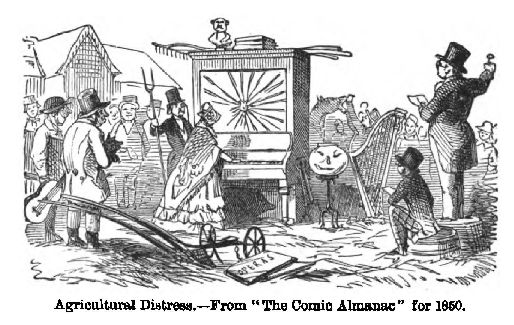
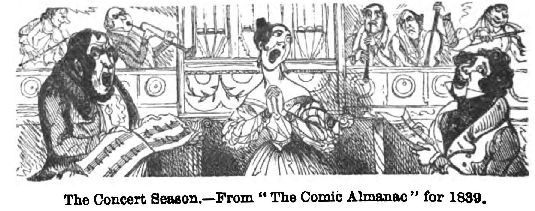
George Cruikshank’s habit of putting himself forward as the originator of any work with which he was connected was never more amusingly displayed than when, in March 1870, he made one of a deputation of the National Education League to Mr. Gladstone. “I must say,” he remarked on this event, in his introduction to the second edition of his ‘Slice of Bread and Butter,’ “that it afforded me much gratification to hear all the suggestions which I had placed before the public so many years ago, so eloquently and forcibly advocated upon this occasion.”
It was a harmless assumption in this instance, to be freely forgiven in the earnest old man who was still exerting himself to the utmost of his ability for what he conceived to be the right way, in the cause of popular education.
He had thrown his ideas into one of those whimsical forms, peculiar to him. He was fond of illustrated pamphleteering, and the reclamation of ragged children left out in the cruel streets hungry and half naked had always been a subject near to his heart. His last effort in their behalf he called “A Slice of Bread and Butter.” On the title page we find one of his bright little pictorial stories in wood. An outcast child lies upon the pavement surrounded by a crowd of men, who are in eager consultation as to the restorative which shall be administered. In the distance is the parish church, but overhead swings the sign of the Britannia, and the landlord, with a pipe in his mouth, is contemplating the scene from the bar parlour. The story is told with all the old completeness.
The crowd consists of “some worthy gentlemen, magistrates, and others,” who, on their way “to the Town Hall on county business,” have found this forlorn boy upon the pavement leaning against the wall. As he was neither begging nor stealing, and did not obstruct the pathway, he could not be taken into custody. When asked what was the matter, he replied, “I wants summut to eat.” Then follows the learned consultation around the starving boy:—
“Now the worthy magistrates and the other gentlemen—some of whom were clergymen, and ministers, and lawyers—were all kind-hearted and benevolent men as well as the doctor; and they all exclaimed, as with one voice, upon hearing what the doctor said, ‘Oh, dear me, how very shocking!—let him have some food instantly!’
‘Yes, yes!’ cried one: ‘here, officer! go into the Britannia, and get him something to eat instantly.’
‘I suppose,’ said he, turning to the doctor, “a bit of plain bread and butter wall be best for him in his present condition?’ ‘The very thing,’ he replied; and as the officer was about to run into the house to get a bit of bread and butter, another gentleman of the party cried out, ‘Stop! see that you bring brown bread.’ ‘Pooh! pooh!’ said another; ‘it does not matter what sort of bread it is, but it must be toasted.’ ‘White or brown, or plain or toasted, it matters not much,’ exclaimed a fourth, ‘provided there is plenty of butter on it.’ ‘I object most decidedly to the butter,’ observed a very sedate gentleman. ‘As to that,’ shouted out another, ‘I consider the butter as most essential: it is full of nourishment; and, besides, the poor boy might be choked by cramming dry bread down his throat without butter; but then we must be careful that it be salt butter.’ ‘No! no!’ cried another; ‘fresh butter, if you please, and as much as you please; but no salt.’ ‘You are all wrong, my friends!—quite wrong!’ vociferated another of the party; ‘depend upon it, that dry toast is the best thing he can have.’ ‘Oh! oh! oh!’ exclaimed all the other gentlemen; ‘who ever heard of such a thing as giving dry toast to a starving child?’ ‘Who ever, indeed!’ chimed in another; ‘it is quite ridiculous to toast the bread at all; the poor child might die before it was ready! No! no! plain bread and butter is best for him; but mind, if I have to pay my part towards it, the bread must be new—yes, new bread.’
‘New bread!’ exclaimed some of the party why, that’s worse than all; for if it does not stick in his throat, it will in his stomach, and perhaps kill him. New bread is indigestible and most unwholesome stuff.’ ‘Well, well; let it be plain stale bread and butter, but only the crumb of the loaf, and I will pay my part willingly,’ observed another. ‘Crumb without crust!’ said one of the former speakers; ‘why, the crust of the loaf contains ten times more nourishment than the crumb, and I, for one, will have nothing to do with it, nor pay a farthing towards it, unless he has a good lump of crust.’
“Now during this contention, or
‘all this splutter About the toast and bread and butter,’
the poor boy seemed to be getting worse and worse, and at the same time all these worthy gentlemen becoming more and more excited; some calling out for ‘Fancy bread,’ some for ‘French rolls,’ others for ‘German black bread,’ and all refusing to pay any part towards the bread and butter, unless cut after their own fashion, when they were reminded by one of the party that there was not the least necessity to trouble themselves about paying for what the boy might have, as it could be charged to the county. To which they all replied, rather sharply, that, as to that, if they did not think it right to pay out of their own individual pockets, neither did they think it right that the public money should be used for purposes which they could not individually approve of. ‘Gentlemen, gentlemen,’ cried the doctor, ‘pray let the child have something. Is it not dreadful to let this poor boy perish before our eyes, when there are the means of relief within reach? For mercy’s sake, let him have something to keep him alive!’ ‘Well,’ replied one of the magistrates (who was chairman of the Sessions),'as you see he cannot have the bread and butter, you must prescribe something else for him.
‘Dear, dear me!’ said the doctor, ‘I am really shocked at such inconsistency. Will you let him have a little brandy, then!’ ‘Oh yes I’ they all cried out together, ‘let him have some brandy—by all means give him some brandy!’”
The brandy made Ragged Jack drank; and presently, being still hungry, he is tempted to steal a roll from a baker’s shop, and dragged to the Town Hall, where the magistrates, who had left him upon the pavement taking brandy, give him a month’s imprisonment, and detention in a reformatory school.’ The chaplain was kind to him, and said, “Yes, now that Jack was a convicted thief, he had plenty of good wholesome bread and butter.” In the reformatory he was educated, and taught a trade, and sent to a distant town where his antecedents would not be against him. On his way he met his cousin, Tom Rag—“a boy as ragged and wretched as he used to be himself.” Tom wants to know how Jack has managed to get such nice clothes and a basket of tools, that he may go and do likewise.
“Cousin Jack, who had been taught, and indeed now knew, that thieving was a wicked thing to do, was sorely puzzled how to advise his friend in this matter; for, having a great regard for Tommy, he wished to save him from the miserable state in which he himself had once been—skulking and wandering about the streets all day, picking up hits and scraps of food, even out of the gutters like the dogs, and at night sleeping in the corner, perhaps, of an open sheep-pen in the cattle-market, or crouching from the drenching rain by the side of a doorway; and when he contrasted that state of his existence with the comfort he had felt, and the attention he had received whilst in the jail and the reformatory, he knew not how to advise his poor cousin, knowing that poor Tom was, as he himself had been, almost perishing for want of a little good wholesome bread and butter, clean clothes, and a comfortable bed to lie in, which he well knew poor Tom would have if he could be sent to jail, as he had been. When he thought of all this he was sorely puzzled what to recommend; but at last he said: ‘Tom, you must not steal; so you had better go a-begging, and perhaps you may be lucky enough to be sent to jail for that, and then you will have everything done for you, as I have had, and come out better than me; for nobody will be able to say that you have been a thief. Yes; go and beg, Tom!
But if this don’t answer, why, then, I suppose you must go a-THIEVING, as I did.’”
“It may be asked, Where were the parents of these poor boys all this time? Well, they could tell you at the Britannia public-house, only they don’t like to talk about such disagreeable matters there. But the fact is, Jack’s father used to use that house, and was once a decent sort of man, and was at one time a ‘moderate drinker’; but upon one occasion he got mad drunk, and in that state of drunken insanity went home and killed his wife, was sent to jail, and died there. Tom’s father was transported for committing some crime after he had ‘been drinking’ at the Britannia; and Tom’s mother took a little drop at first to comfort her, and then drank herself to death.” The foregoing will remind many readers of the scheme of Mr. Jenkins’s “Ginx’s Baby.”
But Cruikshank gives his views on popular education in his homely simple way:—
“One of the great social questions of the day is the necessity and importance of a general or national system of education for the humble classes, upon such a comprehensive plan as shall give every child born in the United Kingdom a certain amount of book knowledge, and also of moral and religious training, as they are, or ought to be, entitled to as juvenile members of a civilized community—such training as may prepare them to fill useful and honest positions in life, or, perhaps, be the first step to those high stations so often filled by honest, hardworking, mercantile men, or ingenious mechanics. Now, every thinking and right-minded person will agree that this object is a most desirable one, and that no innocent child should be so neglected as to be allowed to grow up in a state of savage ignorance; and at the first blush nothing seems more easily to be accomplished, in a wealthy and intelligent country like ours, than to arrange such a general system as is here alluded to, and to provide the ways and means. Well! all this would be simple and easily accomplished, but for one obstacle—namely, the differences in the religious opinions of a portion of the adult population. Yes, strange as it may appear,—nay, monstrous as it is,—nevertheless these religious differences have been, and are now, the only bar to the adoption of any wide and general system of secular education.”
“It is of course impossible to please all parties; but few persons, I imagine, could surely object to a national system of education upon the following plan:—In the first place, an Act of Parliament should be passed, making it imperative that every child should receive some education, and where the parents are destitute or depraved, then that the State shall take the position of the parents, and educate and train up all the neglected and helpless children. In the second place:—In the schools, let reading, writing, and arithmetic be taught (with other branches of education, if possible, or required), and such moral training as will teach a child the difference between Right and Wrong—and here let the schoolmaster’s duty cease, and that of the ministers of religion begin. And in the third place:—Let it be the duty of the clergyman, and ministers of all denominations, to instruct all those children who belong to their particular church, chapel, or sect, in the religious belief of their parents; but when the parents do not attend any place of worship, or profess any particular creed—then, that the clergy of the Established Church be allowed to instruct all such children in the religion of the State. By such an arrangement as this, it appears to me that if all the poor helpless children of the land were schooled in the common elements of reading, writing, etc., for five days in the week, and the clergy and ministers of all denominations were to instruct these children one day in the six in the religion of the class to which they belong (independent of the Sunday), that then all parties might be satisfied, and a great objection done away with as to the great general system which I here propose for secular instruction and moral and religious training.”
He goes on to remark that a reformatory may be wanted in any country, under any circumstances, “but why should we have Ragged Schools in rich England?” He proceeds to argue that there would be no need for either Ragged Schools or Reformatories if the use of “strong drink” were abolished; and he calls upon “the grown-up people not to allow innocent children to starve and fall into evil ways, because they cannot agree upon the mode of cutting a Slice op Bread and Butter.” He adds: “But as prevention is better than cure, I call upon all those who delight in good works to aid the Temperance cause, which is, in truth, the only radical cure for the evils complained of.”
The tail-piece to this characteristic pamphlet—as charming as it is characteristic—is a brightly-executed drawing on wood of Britannia seated upon the British lion, couchant, with her arms about “her ragged and reformatory pets.”
Cruikshank’s zeal for the cause to which he had devoted himself led him to take delight in the illustration even of little Temperance pamphlets and fly-sheets.
Ruskin had said, in his “Time and Tide, by Weare and Tyne” (1867), “It is no more his business to etch diagrams of drunkenness than it is mine at this moment to be writing these letters against anarchy.” Yet just as Mr. Ruskin has gone on with his letters, so Cruikshank went on with his diagrams of drunkenness to the end.
In 1867, when Cruikshank brought out his “British Bee-Hive,” with a worker at a trade or profession in every cell, the estates of the realm at the top, and the army and navy at the bottom, and called it “a penny political picture for the people, with a few words upon Parliamentary Reform, by their old friend George Cruikshank,” he was opposed to the Reform Bill, and advised the working-men to be content with the glorious constitution as it stood, and keep away from Reform meetings, as “revolutionary proceedings.”
Perhaps the best of Cruikshank’s pamphlets, taking the text and the drawings together, is “The Glass and the New Crystal Palace,” published by John Cassell. It is thoroughly Cruikshankian, and in his most vivacious mood: some of the illustrations—as the Spirit Level—a drunkard at full length upon the pavement; the Social Villagers, with Death for the host, and the villagers represented by their tombstones; and the whisky after the goose, and the goose after the whisky, for instance.
Think what would have become of the neglected or forgotten humourist, if, when the mere laughing public had turned away from him to Leech and Doyle, and Tenniel and Du Maurier, he had not been fired with the ardour of an apostle in the cause he had taken up. His Almanac had failed for lack of readers; and David Bogue had thrown up Cruikshank’s magazine, after the second number—convinced that the artist had outlived his public. His ambition to become a painter was mercifully renewed, with the renewal of his health and mind, through temperance. Full of vigour he used to say, “A man should paint from his shoulder, sir.” He became almost wholly a serious man in his work, and appealed to the public in a new capacity. He resolved, stimulated by the success of “The Bottle,” to paint a great picture that should remain behind him, a monument of his genius, and an immortal temperance lesson. He was ready, and eager, to give a helping hand in all directions to the last. In 1870, I asked him to join my Committee, when I was a candidate for the Maryle-bone division of the London School Board. I give his prompt answer as an example of his clear head and hearty readiness in his old age to serve a friend:—
“October 27th, 1870.
“Dear Blanchard Jerrold,—Your request would have been complied with on the instant, but it so happens that a gentleman called upon me a few days back with a message from friend Hepworth Dixon, asking me to allow my name to be placed on his Committee for this ‘Educational Council,’ to which, of course, I assented.
“Now if one man can have his name placed on two Committees, then by all means place my name on your Committee, but if not, then let me know if there is any other way in which I can assist in this matter the man who is a relative of, and who bears the name of two dear friends who were always held in the highest esteem by,
“Yours truly,
“Geo. Cruikshank.”
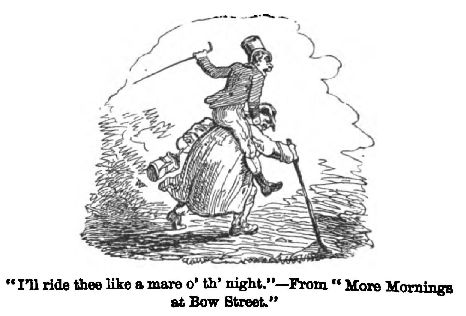
The most notable of George Cruikshank’s book-work, after the failure of bis magazine, was his “Life of Sir John Falstaff,” * illustrating a biography of the knight, written in Robert Brough’s happiest manner. Cruikshank’s twenty Falstaff etchings are admirable examples of his peculiar excellences as an etcher, and of his matured artistic faculty of composition and observation.
* Published by Messrs. Longman and Co., 1857.
In these plates are some of the brightest bits of his picturesqueness of outline, his happy, sprightly treatment of light and shade, and of his higher faculties as an artist, of which fate permitted him to give the world only scattered fragmentary evidences. Thackeray said of him, that he could draw an ancient gloomy market-place as well as Mr. Front or Mr. Nash. What could be more picturesque, or daintier in the play of light, or happier in the variety of the architecture, than the backgrounds of the scenes where Sir John is arrested at the suit of Mrs. Quickly, or when the knight not only persuades Mrs. Quickly to withdraw her action, but also to lend him more money? Mr. F. Wedmore has called attention, and with ample reason, to the exquisite pathos of the death of Falstaff, “in which the face of one who has died ‘a babbling of green fields,’ lies very calm, with the sign of gentle fancies but lately flown.”
These plates were reissued in a “Library Shakspeare” published in parts between 1871 and 1874, together with illustrations by Sir John Gilbert (who, by the way, in his youth delighted in copying Cruikshank’s etchings and drawings on wood); but it is to be hoped that they may some day be rewedded to Brough’s biography, and reappear as the artist’s last important creation.
The twenty years which elapsed between the first issue of “Falstaff” and the artist’s death, albeit no idle years, have left not much completely worthy of the best that had gone before. Cruikshank furnished etchings to the “Life and Enterprises of Robert William Elliston, Comedian” (1857), “Midnight Scenes and Social Photographs—revelations of the Wynds and Dens of Glasgow” (1858), Mr. Alfred Cole’s “Lorimer Littlegood” (1858), “Stenelaus and Amylda, a Christmas Temperance Tale” (1858), a frontispiece to Lowell’s “Biglow Papers” (1859), Dudley Costello’s “Holiday with Hobgoblins” (1861), “The Bee and the Wasp; a Fable in Verse” (1861), “A Discovery concerning Ghosts” (1863), Robert Hunt’s “Popular Romances of the West of England” (1865), the “Savage Club Papers” (1867), “The Oak,” a magazine, edited by his friend the Rev. Charles Rogers (1868), “Coila’s Whispers,” by the Knight of Morar (1869), “The Brownies,” and other tales, by Juliana Horatia Ewing (1870), “The True Legend of St. Dunstan and the Devil,” by Edward G. Flight (1871), “Lob-lie-by-the-Fire,” and other tales, by Juliana Horatia Ewing (1874). Then there are two works, the illustrations to which proclaim the coming end. “Peeps at Life,” and “Studies in my Cell,” by the London Hermit, published in 1875, are signed “George Cruikshank, aged 83, 1875;” and in Mrs. Octavian Blewitt’s “The Rose and the Lily,” is a frontispiece—George Cruikshank’s last design—signed, “Designed and etched by George Cruikshank, age 88, 1875.” This plate is here reproduced.
Not before 1869 did George Cruikshank publish his last political plate.
In 1867 he put forth “The British Bee-Hive,” which was a rearrangement of a design made in 1840. The artist drew a section of the hive, displaying fifty-four cells, in which the various grades of society—from the Queen to the costermonger—are shown, all supported by the army, the navy, and the volunteers, and surmounted by the crown, the royal standard, and the union jack. This was a protest against further Parliamentary Reform; for, as it has been observed, Cruikshank was something of a Radical and something of a Tory—but more of a Tory. He afterwards issued this plate on a double sheet, inscribed “A Penny Political Picture for the People, with a few words upon Parliamentary Reform, by their old friend, George Cruikshank.”
In the following year the old satirist drew a “Design for a Ritualist High Church Tower and Steeple,” which he dedicated to Dr. Pusey and the Vicar of Bray. It was etched on glass by Hancock’s process. The tower of the church was a fool’s cap and bells, with the Pope for weathercock. The porch was a bull’s head, with a procession of Ritualist fools entering by the nostrils. The last, dated July 1869, is a satire upon Miss Rye’s proposition to export “gutter children” to America. “The little dears,” as the artist always called children, are being scooped by a clergyman into a mud-cart, from the volunteers, and sur-royal standard.
The satire was against those who had christened the little waifs and strays of our streets “gutter children.” The name jarred upon Cruikshank’s sensitive heart.
Mr. Wedmore, referring to the closing years of the great pictorial moralist, remarks, “He continued to labour; some of his work being even now but little known. * Early unpublished plates for the ‘Pilgrim’s Progress’ remain, amongst others, in the hands of Mr. Truman. Quite in recent years” (it was in 1868) “he must have executed a private plate for Mr. Frederick Locker, which shows that there were moments at least in which the store of his fancy was not impoverished. No more ingenious design could have been furnished to a collector than this of ‘Fairy Connoisseurs examining Mrs. Locker’s treasures of Durer, Rembrandt, etc.’ For Mr. Ruskin, too, in 1866, there had been designed the ‘Piper of Hamelin,’ leading the children mountain wards with the spell of his wonderful music. And in 1870 a a frontispiece representing the fertile Mr. Barham, surrounded by the creatures of his brain. And yet more recent plates, the property of Mr. Bell, the publisher—one of the ‘Family Window,’ and one in ‘Lob-lie-by-the-Fire’—show that Cruikshank did not wholly outlive his talent. What he outlived was the social conditions he had best comprehended. Dying as it were only yesterday, he belongs so much to the past, because, though his period of production did not seem long over, his time of receptiveness was gone by. As a satirist, he belonged in spirit to another generation; we could not ask him to grapple, at fourscore years, with the foibles of ours.”
* His “Bachelor’s own Book; or, The Adventures of Mr. Lambkin, Gent,” the story as well as the etchings being by Cruikshank, for instance.
This is a true account of him, to all who knew Cruikshank well in his latter days.
Earnest, healthy, vigorous, and ambitious to the last; he could not resign himself to live on the glory of the past He must be ever up and doing—especially in the work that lay nearest his valiant heart. He scattered his temperance work far and wide. “The Fruits of Intemperance,” published by John Cassell, about 1855, is a minor design akin to that of the Triumph of Bacchus. The tree is covered with medallion-shaped fruit, and on each medallion is a picture showing the effects of intoxicating liquors. The roots of the tree are a bundle of serpents, and the surrounding ground is covered with tombstones, inscribed “early fruit.” But Cruikshank never lost an opportunity of preaching his moral. He made a drawing of “a drunken man knocking down a drunken woman, in Oxford Street” on a Sunday afternoon; and another of “a drunken ruffian knocking down a woman who carries a child,” in Farringdon Street. He illustrated the “Autobiography of a Thirsty Soul” in the Weekly Record; and for the same paper he drew a publican’s quart measure, with a death’s head in lieu of ale froth, two drunkards babbling of the strengthening properties of beer by a “Noted Stout House.” In the Band of Hope Review he illustrated a series, a parody on “The House that Jack Built,” called “the Gin Shop.” He threw off fly-leaves for Mr. Tweedie, as “A Man a Thing,” “The House in Shadow,” “The Loaf Lecture,” “There is Poison in the Pot,” “The Red Dragon,” and “The Smokeless Chimney,”—the last of which he designed as a contribution to the Cotton Famine Fund, during the American Civil War. But it didn’t pay. He was consoled, when publishers fell away from him and his means of living became precarious by the steady friendship of many admirers. He received a pension of £95 from the Crown, and one of £50 from the Royal Academy. In 1875, an endeavour was made by Mr. Charles Rogers to raise a second testimonial; but this effort finally took the shape of a committee (of which his good friend Dr. B. W. Richardson was chairman) to purchase the Cruikshank collection of etchings and drawings for the nation and drawings for the nation—the price put on it being £3,000—£500 more than the artist himself had fixed.
After much trouble and many disappointments, the collections passed into the possession of the Westminster Aquarium Company; Cruikshank receiving in December, £2500—the price put upon it being what artist himself had fixed; then receiving in 1876, £2,500, and a survivorship life-annuity for himself and wife of about £35.
The closing years of George Cruikshank’s life were harassed by a controversy about a design he made and a statue he modelled of King Robert the Bruce, to be erected by subscription at Bannockburn. The consequence was a very lamentable quarrel, during which Cruikshank claimed that he had been engaged by the committee to make the design, * and that the statue modelled by Mr. Currie was originated by him—the contrary being, according to the committee, the fact. Cruikshank, in co-operation with Mr. Adams-Acton, produced a model; that is, Cruikshank made a design, and then himself stood in the attitude of it as Mr. Adams-Acton’s model—the result being a statue, and one which found favour with members of the committee. But money disputes put an end to negotiations with Cruikshank. He had drawn £85 for expenses; his plan involved in any case an outlay which the funds would not cover; and finally, after many difficulties, the statue was committed to the care of Mr. Currie.
* In a letter to the Times (December 5th, 1877), he remarked: “As I am the artist who was first engaged by the Bruce Committee to make a design for a monumental statue of King Robert the Bruce, I was very much surprised, upon reading in the Times of the 26th ult. the account of the unveiling of the Bruce statue at Stirling, to find that no statement was made as to my being the original designer,” etc.
But Cruikshank’s share in the transaction, as set forth by himself, and as addressed to the Scottish people in his eighty-fourth year, is too remarkable an example of his vigour in old age to be omitted.
“An Address and Explanation to the Scottish People, by George Cruikshank, with respect to the proposed Statue in Honour of King Robert the Bruce.
“In the month of May 1870, several Scottish noblemen and gentlemen formed themselves into a committee with the object of raising a fund by subscription, for the purpose of having a statue of King Robert the Bruce placed on “the field of Bannockburn,” in honour of that hero, and in memory of the great victory achieved by him and his army in that field on the 24th of June, 1314.
“Some friends of mine, who were on this committee, invited me to be a member thereof—which honour I was obliged to decline, as I could not spare the time to attend the meetings; but, as ‘The Bruce’ was one of my great heroes, I promised to give them all the assistance I could, and suggested the attitude for the figure, which they all approved of, and at their first meeting they decided that I should be requested to make the design for the statue.
“I must here explain that, although I am an artist and designer, I am not what is termed a sculptor; but it so happened that a friend of mine, a brother artist, who is a sculptor, chanced to see my design, and was so pleased with it, that he volunteered to make a model of it, which he did, acting upon my suggestions, and from me as I stood in the attitude and equipped in the armour.
“I also designed a pedestal; and when the model was completed, a cast in plaster of Paris was taken, and exhibited in my studio to the committee, and the noblemen, gentlemen, and friends who attended. All highly approved of the design and the model, and the gentlemen gave most flattering reports, for which I most sincerely thank them. After this I had the very great honour of submitting the model for the inspection of Her Most Gracious Majesty Queen Victoria at Windsor Castle.
“Several casts in plaster were taken from the model for exhibition in London and Scotland, for the inspection of any one who might feel disposed to subscribe; and the committee gave a commission to the sculptor, Mr. John Adams-Acton, to execute a bronze statue of ‘The Bruce,’ ten or twelve feet in height, to be placed on a rocky grey granite pedestal twenty-two feet high; and all seemed to be going on well, and the work was about to be commenced, when suddenly the subscriptions all stopped at once! and this, no doubt, was in consequence of the breaking out of the late war between France and Germany, which terrible contest so entirely absorbed the public mind, that ‘The Bruce’ was quite forgotten.
“This was, of course, a great disappointment to all connected with the press, who had visited my studio, concerned in the movement, and the matter since that time has been almost at a standstill; but I am happy to say that a military officer has joined our ranks, and who now takes the lead, and seems determined, if possible, to conquer and overcome all difficulties. This is Major-General Sir James E. Alexander, C.B., of Westerton, Bridge of Allan, and who is chairman of the ‘Bruce Local Committee of Stirling.’
“I have now to mention another disappointment to myself and the committee, which was, that the Odd Fellows of Stirling had erected a large flagstaff (by permission of the owner of the land) on the very spot where we had intended to have applied for permission to place the statue; that being the site where the Scottish standard was fixed on the day of the battle. This bit of ground being occupied, it was then thought that the best place to have the statue would be on the esplanade of Stirling Castle. Sir James Alexander thereupon applied to the Secretary of State for War for a space on the esplanade for this purpose, which request has most kindly been complied with.
“I must now explain to those who have not seen the original model that Bruce is there represented as if he were looking down with pity on the slain, and as if he were saying, ‘The fight is o’er, the day is won: I sheathe my sword.’ But now that the site is quite different to what was originally intended, it is necessary that the position of the figure should be altered; and, as will be seen by the accompanying rough sketch, the head is now elevated, and Bruce is supposed to be looking across the esplanade towards the field of Bannockburn, which is a mile and a half from Stirling Castle, and, as in the first model, Bruce has sheathed his sword.
“With respect to the pedestal, I may just explain that on the front part are the words ‘King Robert the Bruce’ in large letters, and following this, in smaller letters, is ‘Bannockburn, June 24, 1314.’ Under this line are two branches—one of laurel and the other of willow, emblems of victory and sorrow for the slain. Then is stated, ‘Erected by public subscription in the reign of Victoria, Queen of the United Kingdom of Great Britain and Ireland. Between the words Victoria and Queen is a circular wreath formed of the Rose, the Thistle, and the Shamrock, in which circle are two hands joined, a male and female, as an emblem of the union by marriage of the two royal families of England and Scotland, and on one side of these royal families were the descendants of ‘the Bruce.’
“Nearly fifty years back I painted a picture of an incident in the life of Bruce, exhibited in the British Institution, Pall Mall, London, and was then careful to have the correct costume; but when making the design for the statue, ‘to make assurance doubly sure,’ I got my friend Mr. Bond, keeper of the Ancient Manuscripts at the British Museum, to let me look over the MSS. of the time of Bruce, and then found that I had got the correct costume. I think this is important; for should the statue be erected, all those who might look at it would see just such a powerful man as Bruce was, in the exact sort of armour and coat of mail that he wore on the field of Bannockburn.
“The Bruce in his early progress met with many difficulties, all of which, however, he overcame by his perseverance, and the ‘Bruce Committee’ and myself are following his noble example in this respect; and I trust that all the descendants of those ‘Scots whom Bruce had often led’ will rally round the Major-General and his committee corps, and assist them to place the statue of him who was the great commander of the Scottish army at the battle of Bannockburn in this safe and commanding position on the esplanade of Stirling.
“With regard to myself, as my ancestors were all natives of Scotland—some Lowlanders and some Highlanders—I should indeed be pleased to have my name associated with any national work of art that might be placed in the land of my forefathers, and I should consider it one of the greatest honours that could be conferred upon me if it could be written on the pedestal that this monument in honour of King Robert the Bruce was designed by the artist,
“George Cruikshank.
“Hampstead Road, London, August 1874.
“P. S.—I am authorized to state that subscriptions may be remitted to W. Christie, Esq., secretary to the Bruce Committee, Port Street, Stirling; or to the treasurer, John A. Murrie, Esq., the manager of the branch of the National Bank of Scotland at Stirling; and at London. And I am given to understand that about fourteen or fifteen hundred pounds are required, in addition to what is already in hand, in order to carry out the work in the first style of art.”
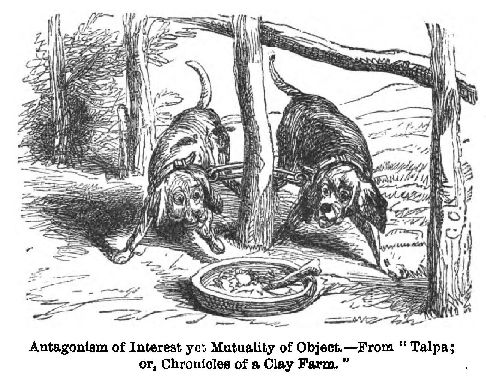
At the ceremony of unveiling Mr. Currie’s statue in front of Stirling Castle (November 24, 1877), Major-General Sir James Alexander, of Westerton, in handing over the work to the Provost and Corporation of Stirling, said, that as they could not get a bronze statue “under the direction of an eminent artist, Mr. George Cruikshank, of London,” they had resolved to have one of durable stone.
This closing transaction of his life poor Cruikshank felt most bitterly; and he charged his old friend Dr. Rogers, Sir James Alexander, and all concerned in it, with having behaved in “a most dishonourable and disgraceful manner.” These were hot, ill-considered words, uttered in the pain of a very trying disappointment: words to be forgotten over the artist’s grave.
Mr. Frederick Wedmore gives us a peep at him as he went about of late, his heart still upon his sleeve as when he was young, in the days of the Regency: “Many of us who did not know him at home have at least met him about; for not only was he a familiar figure of the dreary quarter which he inhabited—where the dingy squalor of St. Paneras touches on the shabby respectability of Camden Town—but he travelled much in London, and may well have been beheld handing his card to a stranger with whom he had talked casually in a Metropolitan Railway carriage, or announcing his personality to a privileged few who were invited to see in him the convincing proof of the advantages of a union of genius with water-drinking. He was an entirely honest man; and who is there that would not forgive the little pleasurable vanities that he chose to allow himself at the fag end of a life not over-prosperous—a career no one had carefully made smooth, a career filled full of inventive work as rich as Hogarth’s and as genial as Dickens’s?”
“Occasionally,” Mr. Frederick Locker writes,* “he used to come to us and tell us his troubles, and what was occupying him; but, like many other interesting people, he did not talk about what would have been most worth hearing. The last time I saw him he spoke of having known Tom Hood (the elder) ** very well, but he did not tell as anything about him worth remembering.
* March 26th, 1878. ** When it was agreed that Cruikshank was to illustrate Hood’s “Epping Hunt,” author and artist, with two or three friends, spent a highly convivial day in the Forest. Hood and Cruikshank were fast friends, and sat up together very late of nights in Amwell Street—the wild humour and prodigious animal spirits being a delight to the quiet humourist, under whose form lay a serious poetic mind, and a tender heart.
Poor man, it was a bitterly cold morning last December, and he arrived before breakfast, and stayed to breakfast. Mr. Austin Dobson was there; and he told us the story of how he invented Old Fagin in the condemned cell.” Mr. Dobson says of him at this breakfast: “On the morning in question (I think it must have been the 14th of December last, 1877), Mr. Cruikshank came in; and I, who had not seen him more than once or twice in my life, was only too eager to ask him all sorts of questions about himself. Except that he was a little bent, he had no appearance of age—certainly not of the advanced age he had reached. He was very-bright and alert, and appeared to have an excellent memory for the circumstances of his career.”
He celebrated his silver wedding on the 8th of March, 1875, when his house was crowded with his friends and admirers, who took tea with him. Mr. S. O. Hall, his old friend, addressed a few words to the company, which so affected Mrs. Cruikshank, that she fell weeping upon her husband’s neck. Mr. Walter Hamilton, who was present, remarks: “To receive the congratulations of so many friends was a task which would have fatigued and excited many a younger man than Mr. Cruikshank; but he preserved his self-possession through it well, having a ready jest and a smile for each and all; whilst Mrs. Cruikshank, who was fairly hedged in on every side with bouquets, looked far too young to be one of the principals in such a ceremony. A guard of honour from his old corps attended to congratulate their late colonel. It was late in the afternoon before Mr. Cruikshank withdrew for a few moments from the crowded rooms, and as he went he whispered, laughingly, to the author, ‘You are down on our list of visitors for the Golden Wedding.’”
“On the morning of the 1st of February,” writes his young friend, Grace Stebbing, ** “there was still living a bright, brave-spirited old man, who had worked on untiringly almost to the end, even to within three weeks of his death, when I, one of those privileged to claim his friendship even from my infancy upwards, met him hurrying along the streets with cheerful, eager aspect, to keep ‘a business appointment.’”
** The Graphic, February 9th, 1878.
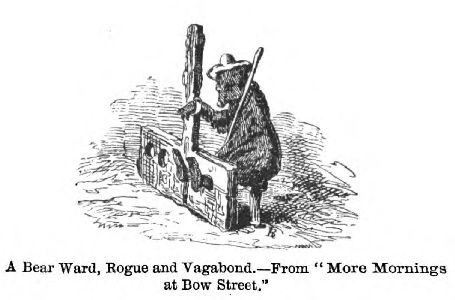

George Cruikshank fell ill in the first month of 1878, and was attended by his sympathetic and distinguished friend, Dr. B. W. Richardson.
He died at his house in the Hampstead Road, on the 1st of February. He was buried temporarily—the Crypt of St. Paul’s being under repair—at Kensal Green. The only member of the Royal Academy who attended his funeral was Charles Landseer, R.A., who was almost as old as Cruikshank. But Messrs. Tenniel and Du Maurier were there, with poor W. Brunton, a clever caricaturist, who was to fall in his youth. Cruikshank’s friend, George Augustus Sala, and Lord Houghton, were among his pall-bearers; and in the group about the coffin were Edmund Yates, S. G. Ball, General M’Murdo, and John Sheehan, the “Irish Whisky-drinker.”
On the 29th of the following November, a hearse, followed by a mourning-coach containing Mrs. George Cruikshank, conveyed the mortal part of the illustrious artist to St. Paul’s, and four sergeants of the volunteer corps which he had commanded brought up the procession. The coffin was silently lowered to its final resting-place immediately after the afternoon service.
